Children of Immigrants
A Dubuque Family Story
Iowa Immigrants from Germany,
Fredrick Voels
(born 1849),
his wife Elizabeth Daniels
(born 1850)
and the stories of three generations of their descendants
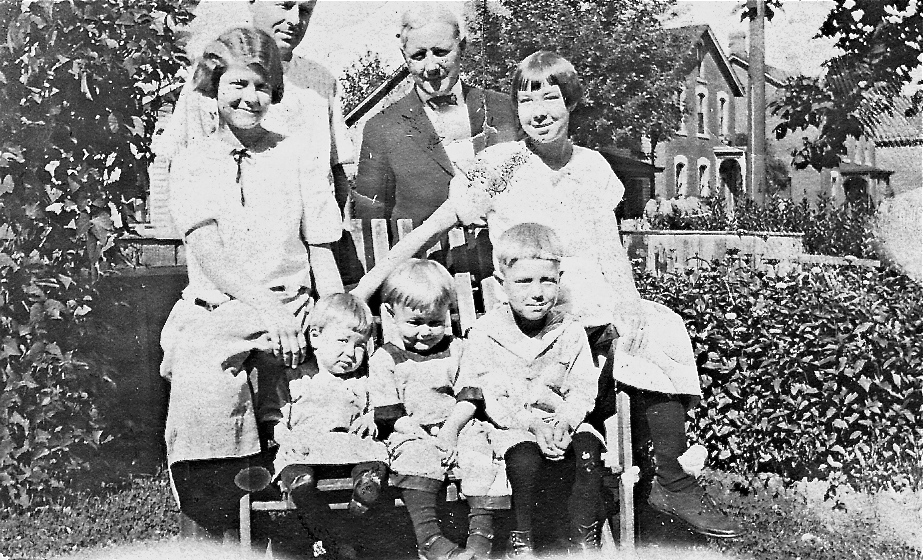
Picture taken in the back
yard on 22nd Street in Dubuque, Iowa.
Standing are from the left, Elmer Voels (son of Fredrick Voels who
emigrated from Germany), Joe Berg (Elmer's brother in law from
California who married Paulina, Elmer's sister), seated are third
generation children, Elma and Lucille, and on the bench are Mary
Jeanne, David and Elmer (Bud). Lucille remembers that they were
playing and someone called that Uncle Joe Berg from California had
arrived. Photo circa 1924, Dubuque, Iowa
Researched
& Prepared by
Karl Terrance Kleeman
(Voels)
Great
grandson of Fredrick Voels
Preface
America is truly a land of immigrants. People from all around the world
came to America to start a new life. They came with great aspirations
and to make a new home for their families. This is the story of two
immigrants, Fredrick Voels and his wife Elizabeth Daniels (Voels). It is
a story of struggles, some hardship, and the challenges of adapting to a
new country, a new society and a melting pot of many nationalities,
religions and cultures.¬
Success cannot be measured by their accomplishments alone, but perhaps
as important, the accomplishments of their children and the children of
their children and now a fourth generation.¬
The book tracks the story of Fredrick and Elizabeth, their children (the
second generation), then their children’s children (a third generation)
and finally a mention of the current fourth generation and all that they
are now doing and giving to America. None of us would be here if not for
the courage that Fredrick and Elizabeth showed in coming to America and
starting this family story.¬
Acknowledgements
Jim Kleeman for his tenacious searching of historic records and filling
in the gaps and finding new family mysteries some of which will need
further research.
Dave Howe for providing lots of information about Dubuque
Steve Voels for photographs from his collection
Stephanie Keehner for her editing
And all of our cousins for sending stories and pictures
Printed in Bellingham,
Washington
2015
Dedication
This book is dedicated to the memory of Barbara Ann Voels
Barb (Barbara Ann) Voels, daughter of Robert and Sally (McCauley) Voels
was born on September 13, 1964 in Dubuque. She was an active and
athletic child joining whatever came her way from playing
'Barbie's' or baseball to playing the violin. She attended
St. Columbkille's grade school, and was a 1983 graduate of Dubuque
Wahlert Catholic High School. Barb spent her first year after high
school attending classes at Loras College and working, she then
transferred to the University of Northern Iowa. She graduated in May
1988 with a Bachelor's Degree in Social Work where she planned to
support those who were less fortunate. It was at UNI that Barb met Ladd
Pettit, fell in love, became engaged, and were married at St.
Columbkille's in June 1988.
Barb and Ladd moved to Fort Know, Kentucky where he was in training with
the US Army. Sadly, their time together was short, as Barb was
diagnosed with cancer in July 1988. They came back to Dubuque and lived
with her parents and despite trying multiple medical treatments,
therapies, prayer and her own valiant spirit, the cancer was too far
advanced. Barb passed away far too young in February 1989, with her
husband and family at her side. She was warm-hearted and fun loving,
with a ready smile and a hearty laugh, and she will always missed.
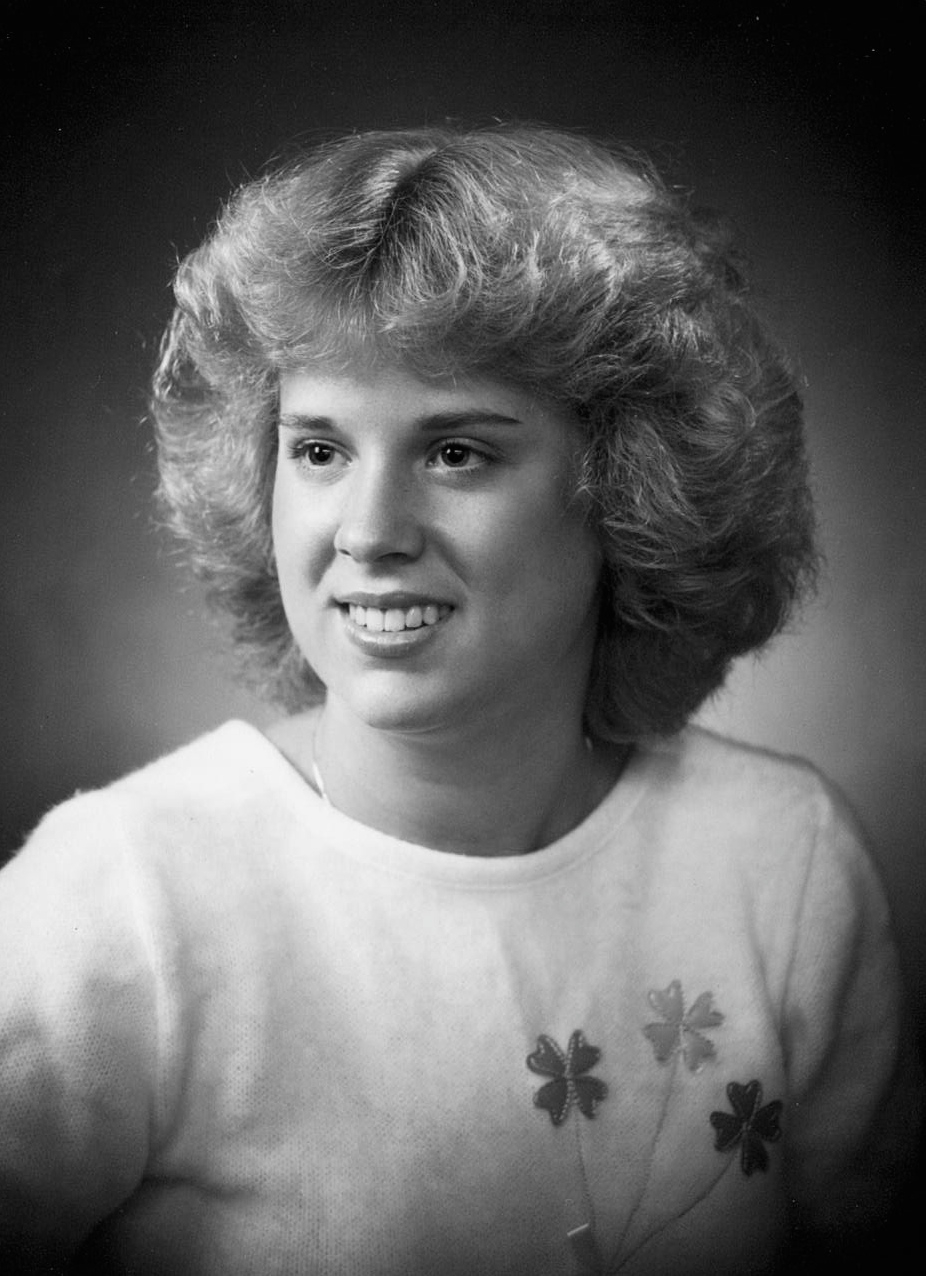
Introduction
A Short History of Dubuque, Iowa (Excerpts from
‚ÄúDubuque on the Mississippi‚ÄĚ by William Wikie, published 1987)
Julien Dubuque grew up in eastern Canada and went west with an older
bother in the early 1780s. Julien learned to communicate with the Native
Americans along the Mississippi. He became interested in the lead mines
in what was to become northeastern Iowa and made an agreement with the
native peoples to operate the mines. In about 1833, eastern Iowa was
purchased from the Black Hawk tribe and Julien Dubuque was able to
develop federal leases for the mines.
In 1835, the town of Dubuque had about 25 dry goods stores, numerous
groceries, four taverns, a courthouse, a jail and three churches. A
Federal Land Office was located in Dubuque in 1838 and a land boom
ensued for the next 20 years. Land was sold at the standard $1.25 per
acre. Dubuque became and remained the largest city in Iowa until 1875.
In 1860, 42% of the people in Dubuque were foreign born. Immigrants were
mostly from Ireland and various parts of German speaking Europe. Iowa
became a state on Dec 28, 1846.
European Immigration: 1880-1920 (From Iowa Public
Television's Iowa Pathways Project)
Between 1880 and 1920, a time of rapid industrialization and
urbanization, America received more than 20 million immigrants.
Beginning in the 1890s, the majority of arrivals were from Central,
Eastern and Southern Europe. Iowa was still a young, growing state
during the years when millions of foreign-born immigrants arrived on
America's shores. It was a time when immigrants needed new homes,
and Iowa needed to attract new citizens.
To attract immigrants, railroad and land companies advertised in eastern
newspapers describing the rich, productive farmland and the beauty of
the state. After immigrants settled in Iowa, they often wrote glowing
letters to relatives and friends in their homelands. These "America
Letters" often influenced others to immigrate to this state. By
1870 about 18 percent of the people living in Iowa were foreign-born.
Except for those from Canada or the British Isles, most of the
immigrants did not speak English. Also, they had grown up in countries
with customs different from those in the United States. To make the
adjustment to living in a new land where language, customs, values and
government were different, newcomers often traveled and settled in
groups. This led to large ethnic areas or neighborhoods where the
immigrant families often remained through the first and second
generation. As children of immigrants attended Iowa schools and learned
American customs and language, the most obvious differences between the
cultures disappeared.
Germans began arriving in Iowa during the 1840s. Like many other
immigrant groups, Germans came for a variety of reasons. Before 1871,
what we today know as Germany was really a collection of small kingdoms
and duchies. Around 1848, people in some of the German states began
revolutions against their rulers. When these revolutions failed, the
people who had supported them, known as ‚Äúforty-eighters‚ÄĚ immigrated to
the United States. In the 1860s Otto von Bismarck became the chancellor
of Prussia, the largest German state. Under Bismarck’s leadership,
Prussia forced the other German states to unite into a single country
under the Prussia king, now called Kaiser Wilhelm I. In order to achieve
his goal of a unified Germany, Bismarck began a program of conscripting,
or drafting, young men into the army. Many young men did not want to
serve in the military and they, and often their families, left Germany
for the United States.¬
The Germans who settled in Iowa were both farmers and city dwellers. In
many towns, Germans formed Turnvereins (turner halls), organizations
that promoted physical education for young people. Germans also enjoyed
going to parks for picnics, where they would listen to band music and
drink beer. German immigrants historically were the second largest
immigrant group (behind people from the British Isles) to settle in
Iowa. Immigrants from Germany settled in every Iowa County. No other
immigrant group was that widely spread across the state. By 1920 half of
all Iowa farmers were of German descent.¬
In the early 1850s, city officials in the river communities of Dubuque,
Clinton,
Davenport,
and Burlington
began to organize local railroad companies. City officials knew that
railroads building west from Chicago would soon reach the Mississippi
River opposite the four Iowa cities. In 1854 the first train
from the east reached the Mississippi River at Rock Island, Illinois.
Soon other railroad lines from Chicago reached the great river.
Ferryboats carried the freight and passengers across the river from the
railroad cars to the cities in Iowa.
On the Iowa side of the river, short railroad line construction began,
and in 1855 the first engine was ferried across the Mississippi from
Illinois. Just one year later a wooden bridge spanned the wide river so
freight and passenger rail cars could travel right on across. By then
one railroad line reached as far west as the state capital at Iowa City.
In 1856 the Congress gave public land in Iowa to companies to build four
‚Äúeast-to-west‚ÄĚ railroads. By 1860 there was 655 miles of track built in
Iowa. The four railroad companies had just begun to build across the
state when the Civil War interrupted progress. Smaller railroad
companies soon linked the towns and cities of Iowa with the main-line
railroads all across the state. Those parts of Iowa where only a few
settlers had been living began to fill with people as the railroad
arrived. Railroads became the key to the growth and success of towns and
cities. The places the railroads bypassed remained small or sometimes
faded away.¬
The first passenger train arrived in Dubuque from Chicago on January 1,
1869. It came over the recently completed railroad bridge, built by the
Keystone Bridge Company.
The following account is from the “History of Clayton County,
Iowa‚ÄĚ
In 1870, the only railroad in Clayton County (north of Dubuque) was the
line from North McGregor through Monona and Luana and to the west. The
Dubuque and Minnesota was one of the first lines. By September 1871, the
railroad had reached the mouth of Turkey River. In 1871, agitation for
the Volga River line was commenced and, in July, Volga voted a tax of 5
per cent in favor of the "Iowa Pacific." This line seems to
have had good backing and it experienced fewer of the vicissitudes of
pioneer railroading than did the other lines of the county. In November
1874, a Volga correspondent writes, "We are bound to have a
railroad at last; Daniel Green, the great railroad contractor, has
contracted to grade six miles of the Volga Valley Railroad. He has
secured the men and teams for active operation." The correspondent
also tells of Volga City as it was before the coming of the railroad,
saying: "Volga City is a wide awake, enterprising town, with one
flouring mill, owned by Henry White; two dry goods stores, owned by
Hollister and Wetmore; a wagon shop, owned by Pardee and Goodwin; three
blacksmith shops, one tin shop, harness shop, boot and shoe store and
two hotels. The Methodists have a very good frame church, and one Union
church, frame. There is a Masonic lodge, a Good Templars lodge, and a
flourishing grange. Dr. McLane enjoys a splendid practice.
The Volga Valley Railroad line was pushed to completion through the
county and the towns of Osterdock, Elkport, Littleport, Mederville,
Osborne and Volga became prosperous and thriving. Each town boomed,
particularly, while during construction, it was the terminus of the
line. The farmers hailed the railroads with joy and fraternized with the
contractors and their men. There were balls and parties and banquets
given by the citizens in honor of the railroads and, when the road was
completed, this was reciprocated by free excursions to Dubuque.¬
In1879, a committee was appointed to examine a route to connect with the
Volga branch at Mederville. Garnavillo also had longings for rail
connection with the outside world and at a meeting held in February,
1878, Crosby, Linton and Kregal were appointed to examine the
feasibility of a line from Garnavillo down Buck Creek and, at a second
meeting, Judge Williams offered to extend the narrow gauge to
Garnavillo, if that city would donate $13,000.
All of this was happening when Fredrick Voels who was born in Germany in
1849, immigrated to America in about 1873. Initially Fredrick and his
wife Elizabeth moved to the Buck Creek area in Clayton County, Iowa,
where he did some farming. But soon, he was to play a role in the
building of railroads in Clayton County and his children were born in
the various locations along the railroad lines mentioned above. Later,
Fredrick moved to Montana where he continued to work for the railroad.
Eventually, he married a second time and had three sons in Montana. This
family history is the story of Fredrick Voels, his large family, and his
descendents.¬
Children of Immigrants, a Dubuque Family Story
By Karl Kleeman (Great grandson of Fredrick Voels, Grandson of Elmer
Voels, son of Lucile Voels)
Based on genealogy research with stories told by the descendants of the
original
1873
immigrants, Fredrick Voels and Elizabeth
Daniels
-
Fredrick’s
name may have originally been Vols, from the Swedish Viscometer
We start this story with an imagined event based on factual
information from descendants and historic records including a letter
dated April, 1980 from Fred Voels, son of Henry Voels who was the
son of Fredrick and Elizabeth. In Fred’s letter he states, “All that
follows I learned from my Dad and Aunt Liza (Henry’s twin sister
Elizabeth Voels) plus a bit of checking on my own part‚ÄĚ.
As
the steamship approached the dock at Wilmington, Delaware, a young
mother stood on the deck with a baby in her arms. Elizabeth (Daniels)
Voels was born in March 1850 in Germany. Elizabeth’s mother died when
she was only 4 years old.¬ At a young age Elizabeth married Fredrick
Voels who was born in September 1849, also in Germany. Her father, Henry
Daniels, and her new stepmother treated her badly and she was glad to
get out of that situation. Elizabeth had a half sister by her
stepmother, Bertha who had been good to her and she would certainly miss
her. Elizabeth wondered what their new life would be like in America.
What would her children and her children's children lives be like?
Did they do the right thing leaving the rich farmland of northern
Germany? But she really had no family there other than her half sister
Bertha. She looked at her husband, Fred, who was leaning on the rail
already sizing up their new home. He had been a schoolmaster, a bright
fellow, but a dreamer with a natural talent and interest in
construction. Fred was dreaming of a new life in America. Her young son
Fredrick was standing by the rail next to his father. Elizabeth wondered
how they would manage and what future would her son Fredrick and his
sister Mary have in this new county?
Right now, Elizabeth really missed Bertha. Bertha was always the one and
the only one with whom she could share her deepest feelings and her
current excitement was tempered by fears of what was to come of her and
her children. Elizabeth prayed that the Springers had received her
letter and that they would help the new immigrants. The Springers were
first cousins, Elizabeth’s mother having been a Friehle from Sweden. She
often thought of her mother who she barely knew. What could the
Springers tell her about her mother? The Friehle family had been
attached to the Royal House of Sweden but her mother’s family had
disowned her. For generations, her mother’s family had arranged all of
the children’s' marriages, but her mother would have none of it. Her
mother met and fell in love with a Scotsman, name of MacDaniels (later
changed to Daniels). Elizabeth’s mother, being a strong-minded woman, in
spite of the family’s protestations, married this "scalawag",
a commoner in the eyes of nobility even if he was a wealthy shipbuilder.
After they were married, Elizabeth’s father and mother had tried to
settle in Sweden but were never accepted. So, they emigrated from her
mother's homeland to Mecklinburg-Schwerin, Germany (Mecklinburg
being a province of Schwerin). It was a crushing blow for Elizabeth’s
mother and left her father (MacDaniels) a bitter man.¬
Elizabeth’s new husband, Fredrick Voels, was never happy in his work and
when he was faced with the enforced German military service of those
times, he decided to move his young family to America. Since Elizabeth
had relatives there, they sailed for Wilmington where there was a large
Swedish community. Little did Elizabeth know that they would land in the
midst of relatives who were at that time millionaires. The Springers
were relatives of the Friehles, thus Elizabeth was in the midst of first
cousins through the Friehle connection. She hoped the Springers did not
carry the old Friehle family bitterness toward her mother and feared
they might now direct it toward her. The following is the story of the
children of these new immigrants and of their children. Their lives
would be a mixture of success and difficulty. But they brought a new
generation to America who like so many immigrant families would populate
this land.
Fredrick Voels (Vols) and Elizabeth Daniels (MacDaniels)
By the time Elizabeth MacDaniels was born, her father Henry had changed
the family name from MacDaniels to Daniels. After her Swedish mother
died when Elizabeth was only four, her father remarried and had a second
child, her half sister, Bertha. Her father and stepmother always treated
Elizabeth poorly but her half sister had always loved her. Elizabeth had
married young to escape the
oppression of her father and stepmother. Her husband, Fredrick Voels was
from Schleswing-Holstein, this is in the northeast part of Germany and
is often referred to as the farm country. The people of this region are
often, jokingly referred to as "wooden shoe Deutsche".
Although he was an educated man and made his living as a schoolmaster,
Fredrick had a natural talent for, and deep interest in construction.
When they came to America, they already had two children, their son Fred
who was born in 1870 and a daughter, Mary born in 1873, both in Germany.
Fredrick Voels was aware that the Mississippi Valley was developing, and
what with river traffic and the railroads under construction, he knew
there must be opportunities for construction jobs. Fredrick and
Elizabeth first moved from Wilmington west to Clayton County, Iowa where
they lived at Buck Creek and farmed for a time. This was good farm country and there
was a large community of people of German extraction there. While at
Buck Creek, Fred learned of the Milwaukee Railroad building a spur line
from Turkey River to West Union, Iowa. He got a job with the railroad
and they lived in Turkey River Junction in a house given to him as part
of his compensation. It was not long before he was Track & Bridge
foreman and helped complete the line to West Union. This line was known
as the Volga Branch Line as it was built along the Volga River.¬
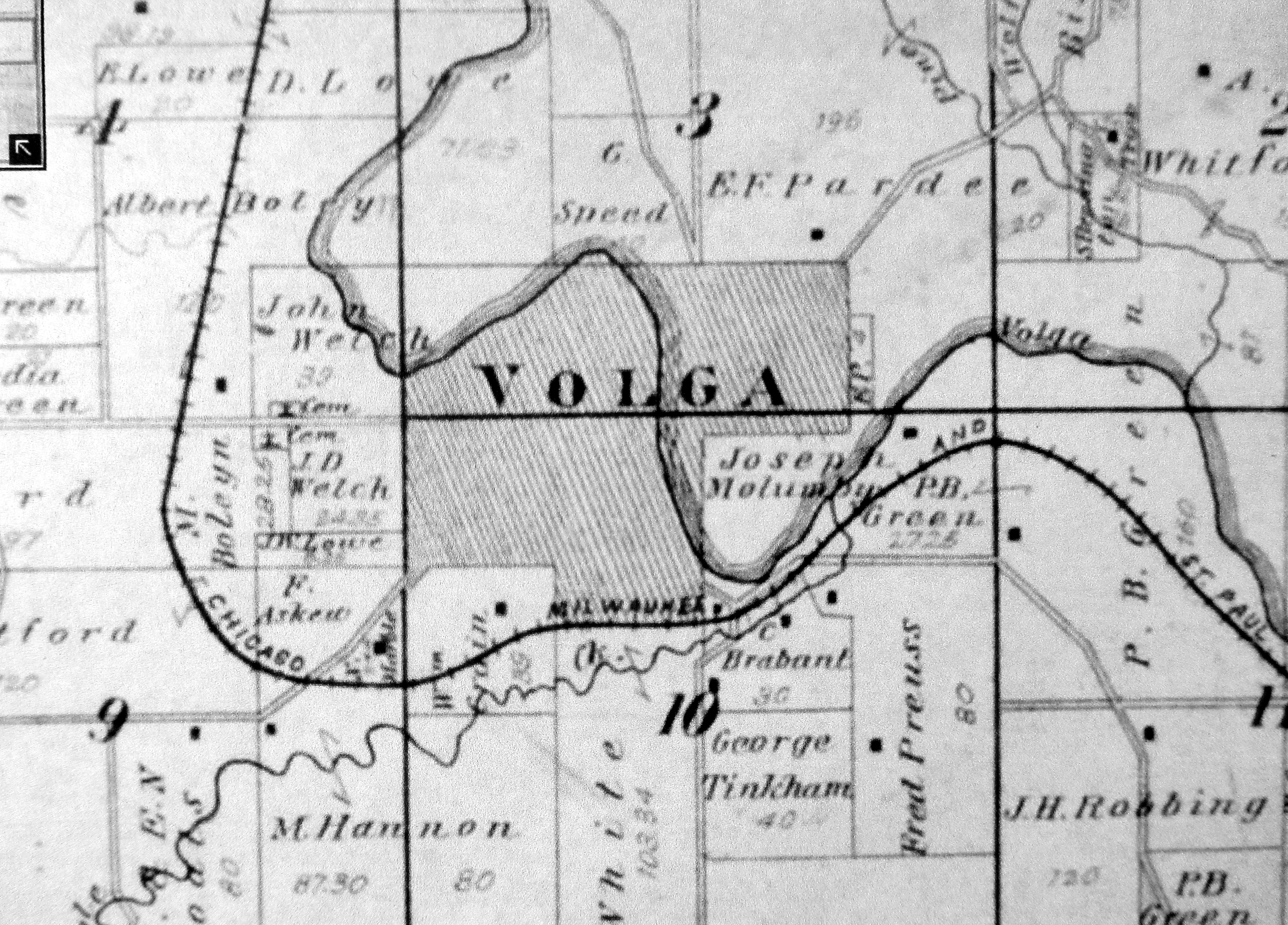
Map showing the city of Volga - You can see the river going
through town and the railroad south of town.
Here, Fredrick and Elizabeth had their first child born in the USA, a
boy who died in infancy and is buried
at Volga City. As the line was being built, the family lived at the
various communities in Clayton County. During that time Elizabeth had
several more children Harriet 1875, Sophia 1876, Henry & Elizabeth
(twins) 1878, Paulina 1882, Albert &¬
Elmer (twins) 1882, and George 1884). One day when they were living at
Littleport, Iowa, her half-sister
Bertha arrived from Germany. Elizabeth's joy knew no bounds. While
visiting her half sister Elizabeth Voels, Bertha told this story.¬ One
day when Bertha was still in Germany a courier from the Royal court of
Sweden came to the Daniels residence. From the conversation it was
apparent that the Friehles (in Sweden) had been keeping an eye on things
including the Daniels family because Elizabeth’s mother had been part of
the royal court. The courier wanted to know the whereabouts of Elizabeth
Daniels, knowing that Elizabeth’s mother had died when Elizabeth was
about 4 years old. Old man Daniels told the courier he did not know
where Elizabeth might be. Old Daniels smelled something good and did not
tell the courier that Elizabeth was in America. The courier stated that
the Friehles had recanted and had forgiven their daughter who had
married MacDaniels. The couriers said that Mr. Friehle was dead and that
Elizabeth as their daughter was to inherit a fortune, the money alone in
the sum of 600,000 Kroner. Old Daniels made up some story and he ended
up with the fortune. Bertha urged Elizabeth to contact the Swedes and
try to get the money that was rightfully hers. Elizabeth refused.
Fredrick and Elizabeth and their children lived in Cox
Creek, Clayton County, Iowa at the time of the Iowa State Census of
1885. Fredrick continued to go on "toots" and was verbally abusive to
his wife and the children when "loaded". It was said that as drunk as
the old man got, he never once laid a hand on Elizabeth. For some
reason he took a lot of his abuse out on Fred, the oldest boy.
Elizabeth became very morose, stubborn, and would fall into moods for
days at a time. She would “bite off her nose to spite her face just
to get back at her husband‚ÄĚ so reported her son Henry many years
later. Never the less, she was always referred to as Mother Voels, a
well-deserved title as she was known for her kindness. Her son Henry
remembered, my mother, Elizabeth, would always say, “My beautiful
Princess Mother, I have never seen anyone so beautiful‚ÄĚ, she was
apparently just old enough at her mother’s death to remember her or
she just pictured her in her memory.¬
Fredrick always had an adventurous spirit. Around 1900, Fred was
contacted by the CB&Q railroad that wanted him to go out west as a
construction and maintenance foreman. It was to be in the CB&Q
headquarters area in Helena, Montana. In his letter written in 1980 on
which most of this history is based, Fred Voels (son of Henry who was
son of Fredrick) goes on to say that his father, Henry Voels who was
born Feb 21, 1878 witnessed the following event. When Henry was about
ten years old, Elizabeth received a notice from the Court in Wilmington,
Delaware. It stated that a family by the name of Springer was having a
family re-union aboard their Yacht on Delaware Bay, when a sudden squall
struck the boat and it capsized. All on board were drowned. Elizabeth
was informed that she being a first cousin through the Friehle
connections was the eligible beneficiary for the sum of a little over a
million dollars and that, if Elizabeth were no longer living, her
children, being second cousins, would receive the money. This was at a
time when the relationship between Elizabeth and her husband, Fredrick
was at its worst. Henry said he heard most of the discussion and the
haggling between his mother, Elizabeth and her husband Fredrick.
Fredrick asked that Elizabeth go after the Springer inheritance for
herself and her many children. Elizabeth stubbornly refused his
suggestion. Fredrick then suggested that she give him power of attorney,
giving him one tenth, and he would go after the money and she and her
children would be taken care of the rest of their life and he would then
leave if that is what she wanted. Also, he promised if she would agree,
he would forget the money, and would reform his drinking problem and
then the whole family could move to Helena where he would have a good
job and they could all start a new life. The answer was NO. So Fredrick,
her husband of so many years went to
Chicago and never returned. Henry said he had a feeling that Fredrick,
together with his daughter Mary and Mary’s husband, Charles Wall, took
off for the west at about the same time. Henry said, Aunt Mary for some
reason was gramps out and out favorite and they always got along well,
even when her father Fredrick was ‚Äúlooped‚ÄĚ.
According to the Iowa 1895 census, Elizabeth and the rest of the family
resided at Dubuque at 2064 Jackson St. Also they were both listed as
Lutheran (1895 census). At this time some of their children were listed
as Catholic (Sophia, Elizabeth and Pauline) while the boys were listed
Lutheran (Henry and Albert). Shortly after moving to Dubuque, Fredrick
left his family to move to Montana.¬
Elizabeth (Fredrick’s wife, also had a daughter Elizabeth) was known for
her hospitality, her first inquiry to anyone coming to the house was,
"Have you eaten yet today?" Lucile daughter of Elmer Voels,
remembers her grandmother, ‚ÄúMother Voels‚ÄĚ, as she was called by all,
lived on 17th and Central Avenue in an upstairs apartment. She was very
well liked by everyone. Elizabeth Voels died May 1, 1919 at the age of
73.¬
From her obituary; Elizabeth Voels (Daniels) was born in 1850 in
Germany, married Fredrick Voels, and immigrated to Iowa. Elizabeth
gave birth to the following children:
-
Fred - son born in
Germany about 1870 ‚Äď lived in North Dakota ‚Äď married Rose Downs,
died in 1951 at age of 81.
-
Maria (Mary) -
daughter born on March 29, 1873 in Germany - married Charles
Wall April 28, 1893 in Grant County Wisconsin, died on Sept 28,
1966 in Los Angeles, CA at age of 93
-
Mrs. Harriet Hagen of
California (daughter? Born Oct 23, 1875 in Iowa, died May 3,
1959 in Los Angeles, CA at the age of 84 (unable to find a
daughter, Harriet listed in any of the early census
records)
-
Sophia - daughter born
in 1876 in Garnavillo, IA, married Herman J. Berg Nov 28, 1895
in Grant County, Wisconsin
-
Elizabeth - daughter
born on Feb 21, 1878 twin at Garnavillo, IA - married Matt
Kiebel, died in Milwaukee, WI on Aug 10, 1964 at age of
86.
-
Henry - son born on
Feb 21 1878 twin at Garnavillo, IA ‚Äď married Dorothea Gunter on
July 24, 1902, died in Dubuque on Nov 8, 1972 at the age of
94.¬
-
Paulina - daughter
born on April 19, 1880 at Osborne, Iowa¬ - married Joseph Berg
in Grant County, Wisconsin on May 9, 1898, died in Florida on
Oct 18, 1974 at age of 94.
-
Elmer - son born on
Oct 23, 1882 - twin at Littleport, Iowa - married Anna Nesen
Sept 15, 1908, died in Dubuque, Iowa on Feb 11, 1940 at the age
of 57.
-
Albert Voels - son
born on Oct 23, 1882 - twin, at Littleport, Iowa and died in
Dubuque on March 19, 1919 at the age of 38.
-
George Voels -son born
in June 1883 at Mederville, IA, married Leona Cunningham on Nov
1, 1919, died in Dubuque on Sept 10, 1958 at the age of
75.
Fredrick Voels goes to Montana and has a second family
It appears that Fredrick Voels arrived in Montana in
early June 1900.¬ He is listed in the 1900 US census collected on
5 June as residing in Dubuque, Iowa BUT is also listed in the same 1900
US Census collected on 15-16 June as residing in Jefferson County
Montana. We know that his Montana wife, Julia, worked as a cook for a
railroad crew at Montana, City and that is no doubt where she met
Fredrick. They were married on Jan 20, 1902 in Montana City. Fredrick
Voels was 49 and Julia Gunther was 27.¬ The marriage license says
Fredrick’s father was Henry Voels and his mother was Dora Schoole. On
the marriage license it states that Fredrick Voels was previously
married but the word ‚ÄúDivorced‚ÄĚ on our copy of the marriage license
was crossed out. ¬
The 1920 Federal Census shows Fredrick and Julia living at Travis Creek,
Jefferson, Montana. He is 67 years old. His occupation was listed as
farmer, and location was listed as General Farm that he owned outright.
Julia is listed at 44 years old and their three children are listed,
Julius (17), William (16) and Charles (15). On a trip to Helena, Mt.,
Karl Kleeman, great grandson, found the following newspaper article
dated Mar 16, 1929 on microfilm.
AGED TRAVIS CREEK FARMER FOUND DEAD IN STABLE
Helena, March 14 ‚Äď The body of Fred Voels, 75 years of age and a
resident of this section for more than 31 years, was found hanging
in a cowshed on his ranch at the head of Travis Creek, six miles
above Unionville by members of his family this morning, according to
word received shortly before noon by city and county authorities.
Voels, it is said had been despondent for several months over the
loss of his savings through investment in oil stocks.
Notification of the Voels’ death was received by Fireman Bill Hayes,
who was called on the telephone form Unionville by one of Mr. Voels
sons. The farm is in Jefferson County and Sheriff Clyde Burgess has
notified officials at Boulder. Voels and his wife had been living at
the ranch this winter. Yesterday afternoon his three sons borrowed a
team from Jim Hayes and went to visit their parents. Besides his
wife and sons, Voels is survived by two stepdaughters. He is
buried in Forestvale Cemetery in Helena, Montana.
And another obituary; Julia Voels (Fredrick’s second wife) Long
Time Resident, Dies
Julia Sophie Voels, 89, resident of Montana for 72 years, who had
made her home in Helena, a quarter of a century, died Saturday night
Aug 15, 1964 at Cooney Convalescent Home following an extended
illness.
Mrs. Voels was the widow of Fred Voels, early day rancher in the
Travis Creek area. She was born Jan 30, 1875, in Warren County,
Montana, the daughter of the late Henry and Mary Benkelman. When
Mrs. Voels came to Montana as a young woman she was employed as a
cook for a railroad building crew at Montana, City. After her
marriage, she and her husband ranched on Travis Creek above
Unionville for 32 years. Mr. Voels died in 1929. For the past 25
years, Mrs. Voels had lived in Helena and had made her home at 620
W. Main.
She is survived by two daughters, Mamie Bell and Minnie Fen, both of
Helena: three sons, Julius Voels with the Veterans Administration
Center, Hot Springs, SD, William and Charles Voels of Helena, a
sister, Emma Roelker, Wright City Mo: two half sisters in
California: three half brothers in Colorado: four grand children:
two great-grandchildren: numerous nieces and nephews. Funeral
services will be held at 2:30 pm, Tuesday in the Chapel of Roses at
Herrmann and Company Funeral Home. The Rev George Harper of St.
Paul’s Methodist Church will officiate; Interment will be in
Forestvale Cemetery.¬
History of the children of Fredrick and his first wife, ¬
Elizabeth Voels who immigrated and lived in¬
various locations in Clayton County, Iowa
Fred Voels¬ Born Jan 1870, in Germany
Fred, the eldest son of Fredrick and Elizabeth, left home at a young age
right after having given his father a first class physical beating at a
time when his father was on a drunk and had been very abusive to his
mother. After Fred left home, he went to Arizona and wound up working
for a railroad maintaining track and bridges. His crew was made up of
Mexicans. At all times he was required to carry a gun. After some time
he quit the job. He bought a bicycle and rode it all the way to
Westhope, North Dakota. He could have gotten a railroad pass but he had
gotten very heavy and was determined to lose weight. He had saved some
money and when he arrived in Westhope, he became acquainted with a man
named William Barber. They bought a used, broken down threshing rig and
repaired it. Fred was very talented mechanically. There were few rigs
around at the time and they made a "boodle" of money the first
year. They invested their earnings in a new machine. From then on they
made a lot of money.¬
Each year, when winter rolled around, life became dull. Fred and his
partner bought a business that was located in a huge frame building.
There was a pool hall, bar and small grocery in the downstairs. The
upstairs was a huge hall and was used for occasional dances. There were
quite a number of chairs in the hall also. Fred talked his partner into
buying a used moving picture rig and they repaired it. Fred then
convinced his partner that for a reasonable sum per person, they could
have a movie every Saturday night in the winter, then push back the
chairs and have a dance. This would be good for the bar trade, plus they
could serve a light lunch. It worked and the boys made more money.¬
Fred always wanted to go places. Some time after Fred and his partner
started to make good money, after three or four years, one day after
threshing was over, Fred took his money he had saved and went to St.
Paul, Minn for the winter. In the spring he came back riding the boxcars
and flat broke. He and his partner would then get the rig in shape and
made a lot of money threshing and binding plus a share of the bar
business. For some years thereafter, Fred would take off for the winter
returning in the summer for threshing. Someone saw Fred one winter in
St. Paul, Minn and said Fred was living like a king. However, Fred never
drank, he onetime told his brother Henry that he never drank after
seeing what it did to his father. Eventually, at the age of 55, Fred met
and married a widow, Rose Downs who had three grown sons. His wife died
and the boys left.
One day Henry Voels, who was living in Dubuque, Fred’s brother got a
phone call from a fellow named Schroeder and learned that Fred had been
up a scaffold painting and it broke, he came down his foot landing on a
sharp edge and nearly severed his foot. He got a serious infection and
they did not know if he would live or die. Fred had asked Schroeder to
contact his brother Henry, as he wanted to see him once more. When they
got the message, back in Iowa, Henry and his sister Liza set off the
next day for North Dakota to see Fred. They were instructed to look up a
man by the name of Barber (Fred’s long time partner). Barber was very
friendly. He invited them to stay at his home and took them daily to see
Fred. When they saw Fred, he had taken the first steps toward recovery.
This is when they learned the story (included earlier) of what Fred had
done after running away when the Voels family lived in Littleport, Iowa.
Fred belonged to the Odd Fellows that was quite strong in North Dakota.
In later years, Fred began to ail and feeling the ravages of time, he
applied for and was admitted to the Odd Fellows Home for Homeless
Brothers. This is located at Devils Lake, North Dakota. He is buried at
the cemetery at the Odd Fellows Home at Devils Lake. North Dakota.
Maria (Mary) Voels¬ Born: March 29, 1873 in Germany
Mary Voels was born in Germany and immigrated to America with her
parents at a young age. Mary was her father’s favorite and she always
got along well with her father, even when he was "looped".¬ In
1885, Mary was 12 years old and living with her many brothers and
sisters in Cox Creek, Clayton, Iowa.
Mary went to Dubuque with the family for a time and did house work. It
was here that she met and married Charles (Chas) Wall. They wound up in
Chicago after marrying on April 28, 1893 in Grant County, Wisconsin.
Fredrick (her father) may have gone to Chicago after leaving his family
and Mary and her husband may have gone to Montana with him. In later
years Mary lived in California. She had a daughter, Ethyl who married a
photographer, Fred. Mary died on Sept 28, 1966 in Los Angeles, CA at age
of 93.
Child
of Fredrick and Elizabeth Voels died in infancy
buried at Volga City, Iowa. We cannot confirm this.
Harriet M. Voels born 1875 in Iowa
Harriet Voels was mentioned in two obituaries, one when Elizabeth Voels
(her mother) died and again when George Voels, her brother died. In both
she was listed as Harriet Hagen. We have located a death notice for her
from Los Angelus, CA saying she was born in Iowa in 1875 to Fredrick and
Elizabeth Voels and died on May 3, 1959 but we cannot find any other
record of her.
Sophia Voels¬ - Born 1876 in Iowa
She was married to Herman J. Berg in Grants County, WI
on November 28,1895.¬ In 1900 lived in Dubuque with Herman and
two year old daughter Margaret. Lived on Jackson Street.
¬
Henry Voels - Born: Feb 21, 1878 Garnavillo, Iowa
Henry was born in Garnavillo (listed as Volga City in his obituary),
Iowa Feb 21, 1878. Henry moved with his mother Elizabeth and the
family to Dubuque. In 1900 Henry was living in Dubuque with his
brothers George, Albert and Elmer and his twin sister Elizabeth.
Henry was 22 years old and single. Later that year he married
Dorothea (Dora) Gunter. They had four children, Joseph who died when in
1904, two sons, John and Robert who both died in 1909 and a son Fred
Martin who was 10 years old by the 1910 census. Henry’s occupation was
listed as a shipping clerk for a Coffin Co. (T. E. Rhomberg). He worked
for them for more than 50 years.
On his draft registration card completed Sept 12, 1918 he was listed as
age 40, tall with a medium frame and blue eyes. In the 1920 census, Ruth
Gunter, age 20 and Louisa Gunter age 64 were listed as living with them
(perhaps mother and sister of Dora, his wife).
In 1980 Henry’s son Fred Voels wrote the letter that forms the basis of
this entire book. The information came from Henry and his sister, then
called Liza.
Henry died Nov 7, 1973 at the age of 94. In his obituary he is survived
by his son Fred and two grand children and his sister, Pauline Berg,
then of Pompano Beach, Fla.
Albert Voels ¬ Born: Oct 1882, Cox Creek, Clayton, Iowa
In 1900, Albert was 18 and lived with his brothers and sisters,
George, Elizabeth, Henry and Elmer, with their mother Elizabeth in
Dubuque, Iowa. By 1910 he was listed at 28. Albert died at his
sister Elizabeth’s home (was then Mrs. M. J. Kiebel) in Dubuque at
the age of 38.
George Voels¬ ¬ Born:¬ Jun 1883 in Mederville, IA
George was born at Mederville, IA. At age 16, George lived in Dubuque,
Iowa with his sister and brothers, Henry, Elizabeth, Albert and Elmer.
George was the youngest. At 26 he was still living at home but now only
he and Albert, age 28 remained at home.¬
When he was 35, George married Leona Cunningham (born
1896, died 1960).¬ George was working as an Express Man. By 1930
they had a large family, George (9), Harold (8), Henry (7), Elizabeth
(married name Moore)(5), Donald (2), William (new born). Later he had
another son, Robert.
George was kind of a black sheep. He was a drinker like his father
(Fredrick). Their kids used to come up to Uncle Elmer and Aunt
Anna's house. Anna was always worried about how poorly dressed they
were and would give them cloths. Ann remembers that young George used to
come on Saturday morning and he would say Aunt Anna, we need this or
that. Anna would have fresh baked bread and she would give them bread
and cookies, then she said do you need a pair of shoes; those shoes
don't look so great George? Dave or Bob or one of the boys shoe size
was the same so she gave George a pair of shoes. After George left, she
would say, I won't give him any money because his dad will drink it
up.
Both are buried at Linwood Cemetery in Dubuque (sect 1, 1st Street E.,
grave 31).
Paulina (Polly) Voels¬ ¬ Born: April 19, 1880
Paulina Voels was born in 1880 in Clayton County,
Iowa.¬ At age 11 she lived at Cox Creek, Clayton County. By the
census of 1900 she lived in Dubuque. She was married to Joe Berg on May
9, 1898 in Grant County, Wisconsin (interesting that 3 of the Voels
girls were married in Wisconsin ‚Äď what is that all about?). Joe was a
paper hanger. Their daughter, Dolores was born in 1900. By 1910 they
were listed as living in Minnesota. In the 1930 census they were listed
as living in Milwaukee. They bought, lived in and renovated
houses.¬ They were still in Milwaukee in 1942. At some point they
moved to California.
Their daughter, Dolores, married Ray Munson and later moved to Florida.
By 1952 Paulina had moved back to Dubuque. However, by 1978 she was
living in Florida, probably with her daughter.
Elizabeth Voels ¬ ¬ Born: Feb 1878 in Garnavillo, IA
Elizabeth Voels was born in 1878 in Garnavillo, Iowa. She had a twin
brother Henry. Her father was Fredrick Voels and her mother was
Elizabeth Daniels Voels, both born in Germany and immigrated to the
United States about 1873. By 1900 the census showed Elizabeth was 21
and was living in Dubuque, Iowa with her mother and brothers,
George, Henry, Albert and Elmer. Elizabeth Voels married
Matthias (Matt) Kiebel, who eventually was head of furniture department
at Roshek’s a large department store in Dubuque. By the 1920 census,
Elizabeth was 41 years old and was living with her husband and three
children in Dubuque, John (13), Elizabeth (10) and Lillian (8). Her
daughter, Lillian married Eddie Bull. John married Brunhilda Nicks. Her
daughter, Elizabeth, was an accomplished pianist and married Ralph
Lawrence.¬
Lucile Voels remembers this story about Aunt Liz. Aunt Liz lived on N.
Main St on a hill. One time the Voels kids were up there playing with
the Kiebel kids. Lucile put her roller skates on and started down the
grade. John Kiebel, who was older, saw her and ran over and threw
himself in front of her to stop her. They also used to sled down the
street but had to have a lookout for traffic at the bottom of the hill.
Somehow, they all lived through it. Aunt Liz was Uncle Bud Voels’
godmother. (Elmer [Bud] was a son born to Elmer Voels who was
Elizabeth’s brother).
Elmer Edward Voels
Elmer Edward Voels was born in Littleport, Iowa. He had a twin
brother, Albert. He married Anna Nesen and they had 7 children. All of
the Voels descendants in the rest of this history are the children or
grandchildren of Elmer Edward Voels.
Elmer Voels was born in Littleport, Iowa. He had a
twin brother, Albert. In the 1900 census, he is listed as being 18
years old and living in Dubuque with his mother, sister and brothers,
George 16, Elizabeth 22, Henry 22, Albert 18. We located his draft
registration card for World War I. At the age of 24 he married Anna
Nesen and in the 1920 census they are listed as living on 22nd St. in
Dubuque. The 1920 census list 3 children, Elma (9), Lucille (8), Elmer
(baby) and also Catharine Broell (13), who was adopted.¬ His
occupation is listed as a Movie Operator. In 1925 Elmer (42) is still
listed in Dubuque with the additional children, David (3), Mary J. (2)
and Robert (1).¬ In the 1930 census he is still listed as a Movie
Operator with one additional daughter, Anna Mae (3).¬ Elmer died
on the February 23, 1940 and is buried at Mount Calvary Cemetery in
Dubuque.
History of the children of Fredrick and his second
¬ wife, Julia Voels, Montana
Julius Voels ‚Äď born Oct 18, 1902, died in Columbia Falls,
Flathead, Montana, died Mar 22, 1979
William Voels ‚Äď born Nov 22, 1903, at death living in Helena,
Montana, died Feb 1971 ‚Äď never married
Charles Voels ‚Äď born May 4, 1905, at death living in Helena,
Montana, died Mar 14, 1968
We have located this obituary for Julius F. Voels son of Fredrick Voels
with his second wife Julia in Montana…
Former Helena-area resident Julius F. Voels, 76, dies
Thursday at the Soldiers Home in Columbia Falls, where he had been a
patient for the past year.
He was born Oct 18, 1902 in Montana City, where he attended schools.
He later ranched in Jefferson County. Voels was ill for 33 years,
and was hospitalized at Fort Harrison Veterans’ Administration
Hospital, Helena Nursing Home and the Soldiers Home.
He was preceded in death by his wife Alice in 1943, his parents and
two brothers. He is survived by a daughter, Mrs. Andrew (Faye) Van
Deale of Helena, two sisters, Minnie Fenn and Mamie Bell, also of
Helena and three grandchildren. Voels was a member of both the
Fraternal Order of Eagles and the American Legion.
NESEN ANCESTORS (Anna Voels’ parents)
John J. Nesen (Anna Nesen‚Äôs father‚ÄďAnna Nesen married Elmer Voels)¬
¬
John Nesen was a big man with a black moustache. He was a very strict
disciplinarian. His first wife was Marie Kathryn Schuler. They had 3
children, 2 girls, Anna and Kathryn and one son, John who died at a
young age. After Marie Schuler died, John J. Nesen married a second time
to Maggie Patsche and they resided at 1620 White St. in Dubuque. He
lived near to and was a life- long member of St. Mary's Catholic
Church in Dubuque. The Nesen home was a 4 unit apartment building. They
owned it and lived in one of the downstairs apartments.
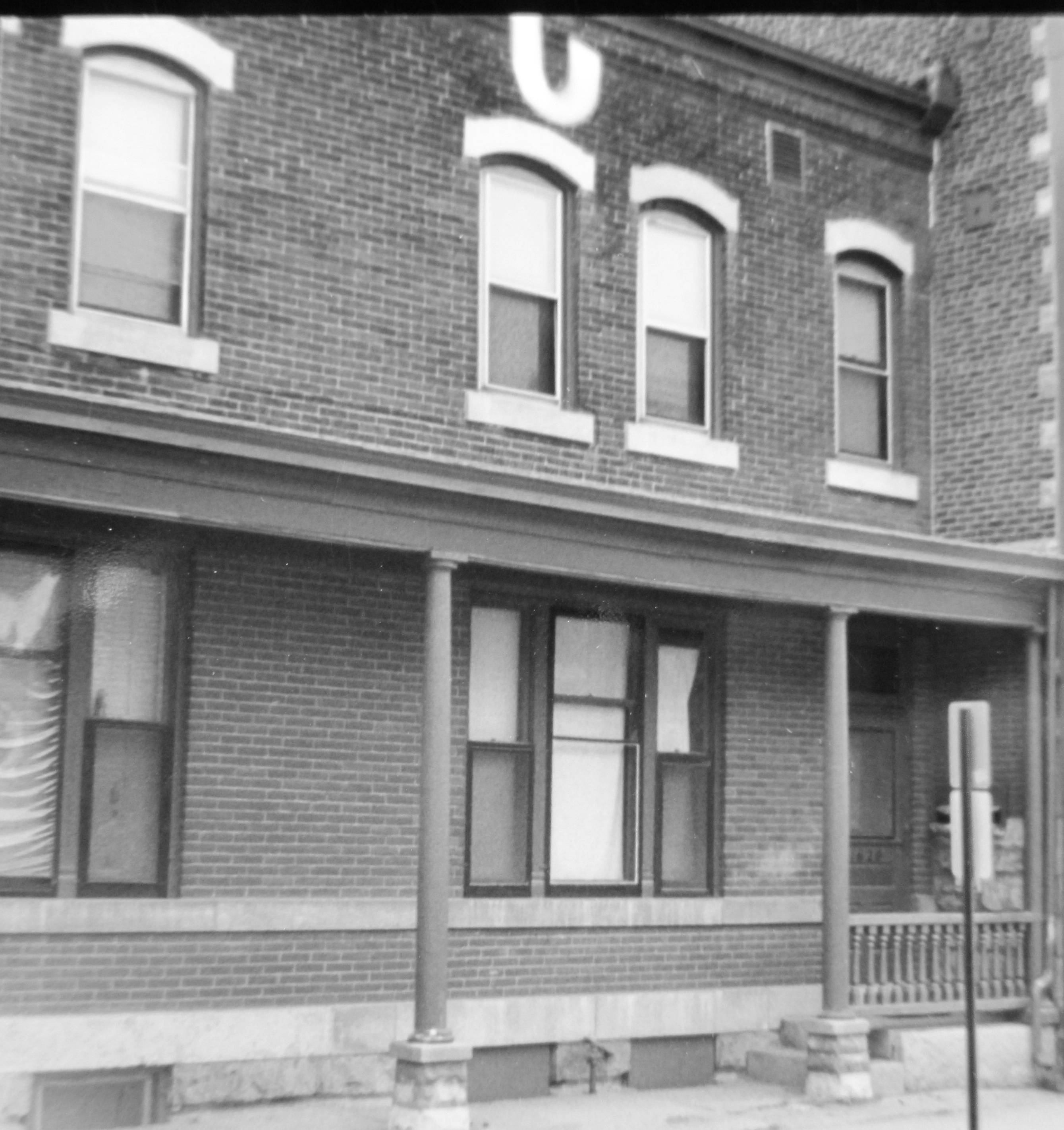
Nesen Home at 1620 White St., Dubuque (photo, 1996)
Next door was St. Mary's Casino. It was not a gambling joint, it was
a recreation hall. This was a German section of town; St. Mary’s is
German Catholic. There was a lot of friction between the German and
Irish immigrants in those days.¬
John Nesen traveled for the Dubuque Alter & Manufacturing Co. and
seemed to be on the road most of the time. Lucile remembers her
grandfather a big, austere man with a big moustache. She remembers his
second wife, Maggie. His first wife died before Lucile was born. John
Nesen died in Sacred Heart Hospital in Chicago, Illinois.
Marie Kathryn Schuler (mother of Anna Nesen who married Elmer
Voels)
Marie Kathryn Schuler, first wife of John Nesen and mother of his 3
children, Anna (who married Elmer Voels), George and another daughter,
Kathryn.¬
Marie Schuler died and her husband, John Nesen remarried so the children
had a stepmother, Maggie Nesen (Patsche).¬
Elmer Voels married Anna Nesen
Most of the material in this section was from interviews of the
sons and daughters and is presented exactly as was told to me
without editing.
Elmer Voels worked at the Dubuque Grand Opera House starting as a
stagehand for live performances and transitioning to a projectionist
when movies took over.
GRAND OPERA HOUSE, DUBUQUE,
IOWA
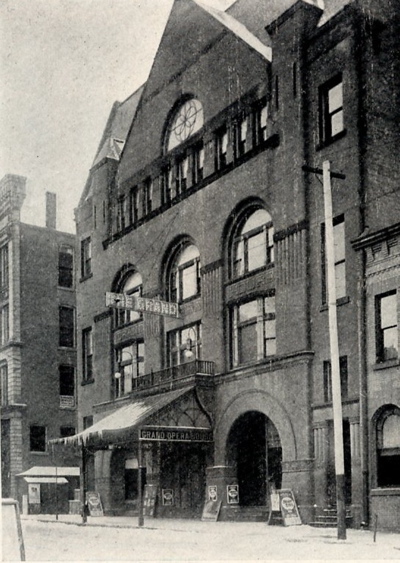
Photo courtesy: Jim Massey From the ‚Äúon line‚ÄĚ Encyclopedia of
Dubuque
The Grand Opera House, oldest surviving theater in the city of
Dubuque was built at a cost estimated to be $65,000 between 1889 and
1890 by Grand Opera House Inc. The Grand Opera House had its opening
night performance on August 14, 1890.¬
The largest theater ever built in the city; the Grand had 1,356 seats
and a mammoth stage stretching thirty-nine feet from front to back.
An eager crowd of eight hundred paid $5.00 each to see a performance
of the opera "Carmen" by the Hess Opera Company. Actors
made costume changes next door in an old house that was connected to
the theater by a tunnel. Originally illuminated by gas, the building
was lighted by electricity by 1897. From it’s opening through 1930,
over 2,600 different live theater shows were performed in the Grand.
Such well-known actors and actresses as Ethel Barrymore, George M.
Cohan, and Lillian Russell added to the excitement on special
occasions. Perhaps the Grand's most elaborate production was
"Ben Hur" complete with elephants, horses, and chariots-on
stage.¬
In its first twenty-eight years, the Grand ran in the red only six
times and these were due to expensive improvements. Reservation of
seats began at 9:00 a.m. one day in advance of a performance.
Telephone reservations were accepted until 6:00 p.m. of the same
day. Doors were opened for the evening performance at 7:30 p.m. and
for the matinees at 1:30 p.m. Evening performances began at 8:15
p.m. and matinees started at 2:30 p.m. Season programs carried the
names of cast members and advertisements from many local
companies.
The Grand was closed in 1930 for three months of remodeling including
the removal of the second balcony and the box seats. The orchestra
pit was covered and the semi-circular stage front was straightened.
With the addition of a big screen and a projector, the age of
wide-screen motion pictures had arrived.¬
The Grand, Dubuque's only surviving downtown movie house, was
sold in 1972 to Richard Davis of Des Moines who sold his interest to
the Dubinsky Brothers in 1976. With the purchase of the Grand by the
Barn Community Theater, live performances returned to the stage with
the musical "Tintypes" on August 15, 1986.¬
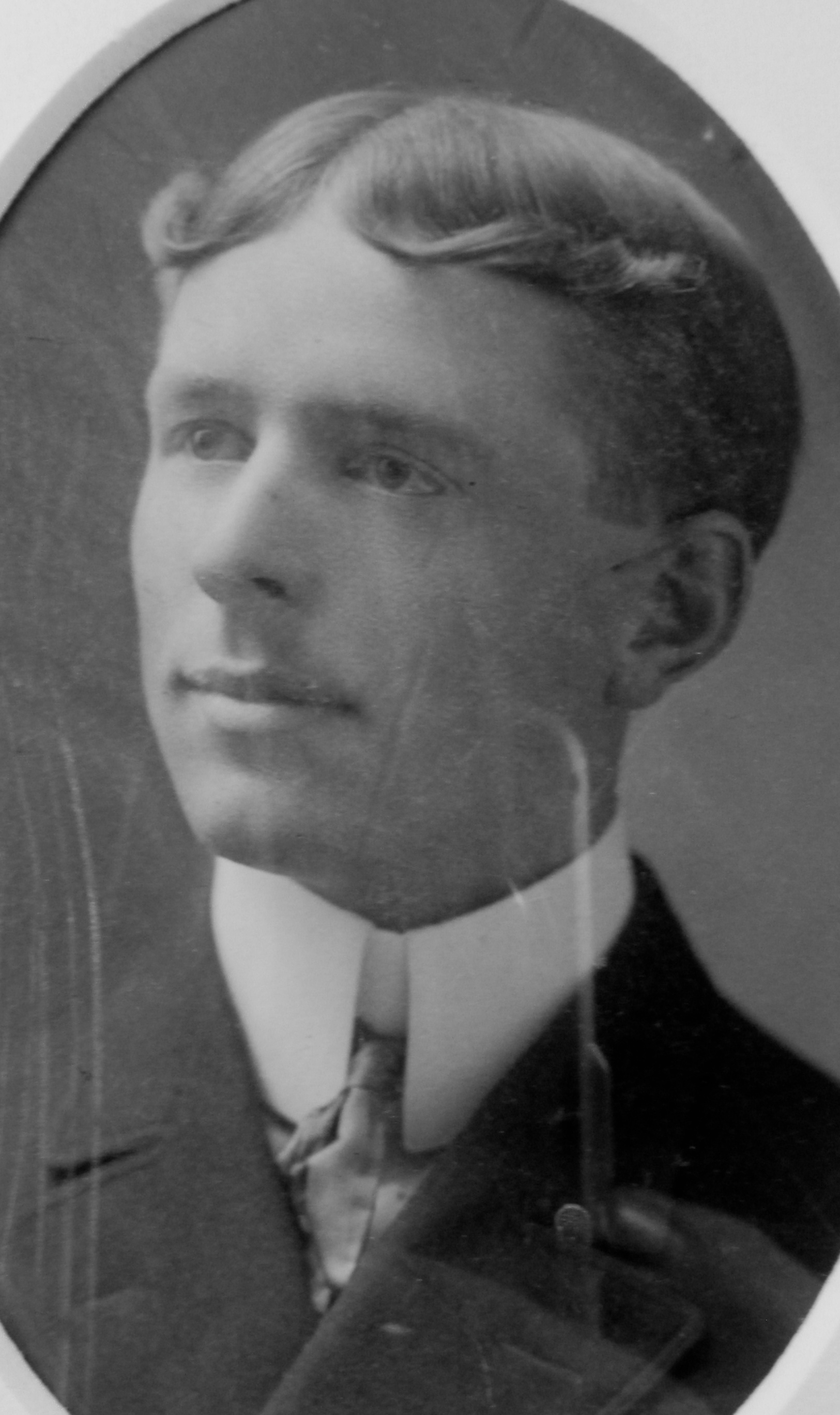
¬ Elmer Voles, son of Fredrick Voels
As a young man, Elmer Voels started as a stagehand and soon became the
stage manager at the Grand Theater in Dubuque. They put on a lot of
traveling road shows. These shows had big stars of the day and were
large productions. When they did Ben Her, they had horses on stage. Anna
would take the older children to shows once in awhile.¬
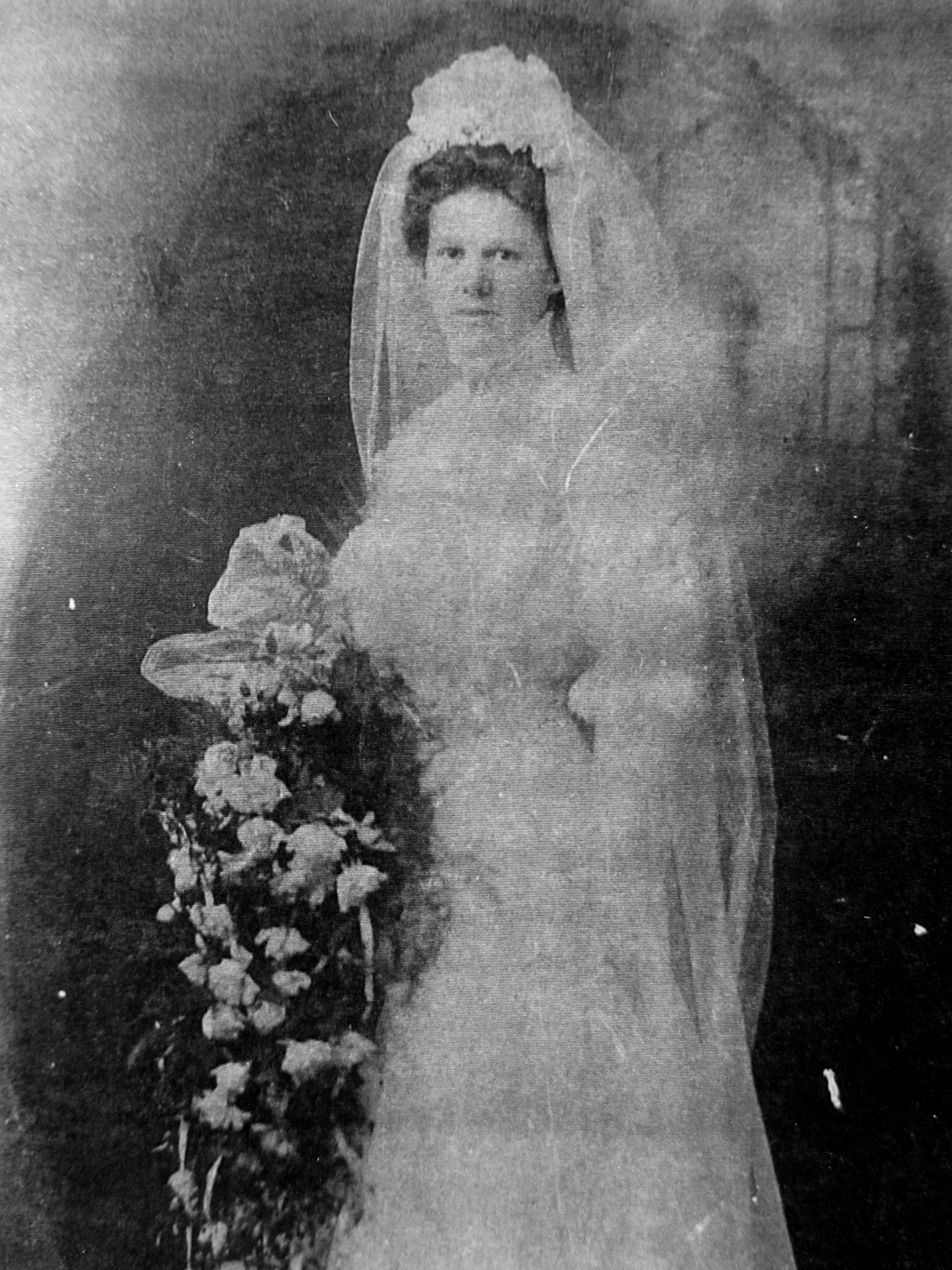
Anna Nesen, wedding picture, married Elmer Voels
Bud remembers that Elmer was stage manager at the Grand Theater. The day
Mother and Dad were married, they were closing a show that night, so Dad
couldn't leave, he had to stay until that show closed. Then they got
on the train with all the show people who were going back to Chicago.
All the show people knew they were married that day so they kidnapped
Mom and Dad didn't see her until they got to Chicago.¬
Lucile remembers that after they were married Elmer and Anna first lived
in an apartment, she thinks on Central Ave. The only thing she knows of
the early days was this story of her birth. It was the 4th of July and
her Dad had just gone to the roof of the building to put up a balloon
and Anna called; ‚ÄúIt‚Äôs time for the baby‚ÄĚ. Lucille was born on July 4,
1911.¬
Elmer went to work in the afternoon before the children got home from
school. He never had dinner with the family when he was working. He got
home late at night and was sleeping when the children got up and went
off to school. They even had shows on weekends so the family pretty much
grew up without their father.
¬ Anna had a big job with taking care of the family. It was a wonderful
day when his working hours were cut back to 40 hours per week.¬ Elmer
became a projectionist when the theater changed to movies. This was in
some ways more demanding as the movies were shown 7 days a week.¬
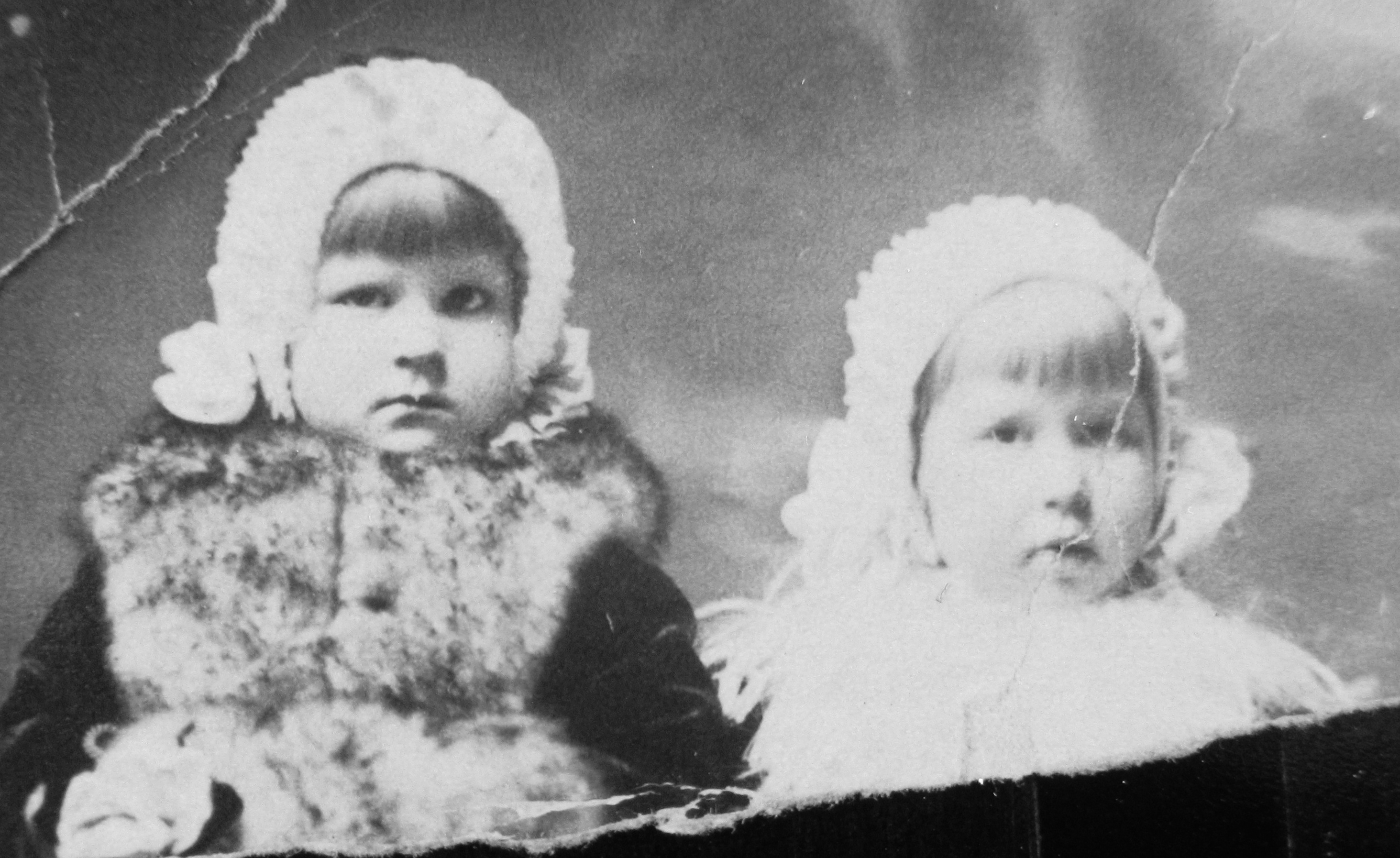
Elma left and Lucille, right¬
Anna's sister, Kathryn Nesen died and left a child, Catherine Broil.
Catherine's father died some time later. Catherine (Kate) was
adopted by Elmer and Anna. Elmer and Anna also raised 7 children of
their own, Elma Ann (6-29-1910), Lucile Mary (7-4-1911), Elmer John
(Bud) (3-3-1917), David Robert (7-5-1922), Mary Jean (7-1-1923), Robert
Jerome (10-6-1924) and Anna Mae (5-3-1926). They also had a baby girl
who died at birth.¬
When they had 3 of the children, Catherine, Elma and Lucile; Elmer and
Anna rented a house at 301
E. 22nd St. in Dubuque. Elma was called Leme and Lucile was
called Dede. Elma gave Lucile that name because she always called a doll
a Dede and when she saw her new sister, she said, oh that's a big
Dede. Anna Voels was a great cook. She never measured anything. She
would just use a handful of this and a dab of that, she never even had a
measurer, and it always came out great.
¬
Life at 301
E. 22nd St.
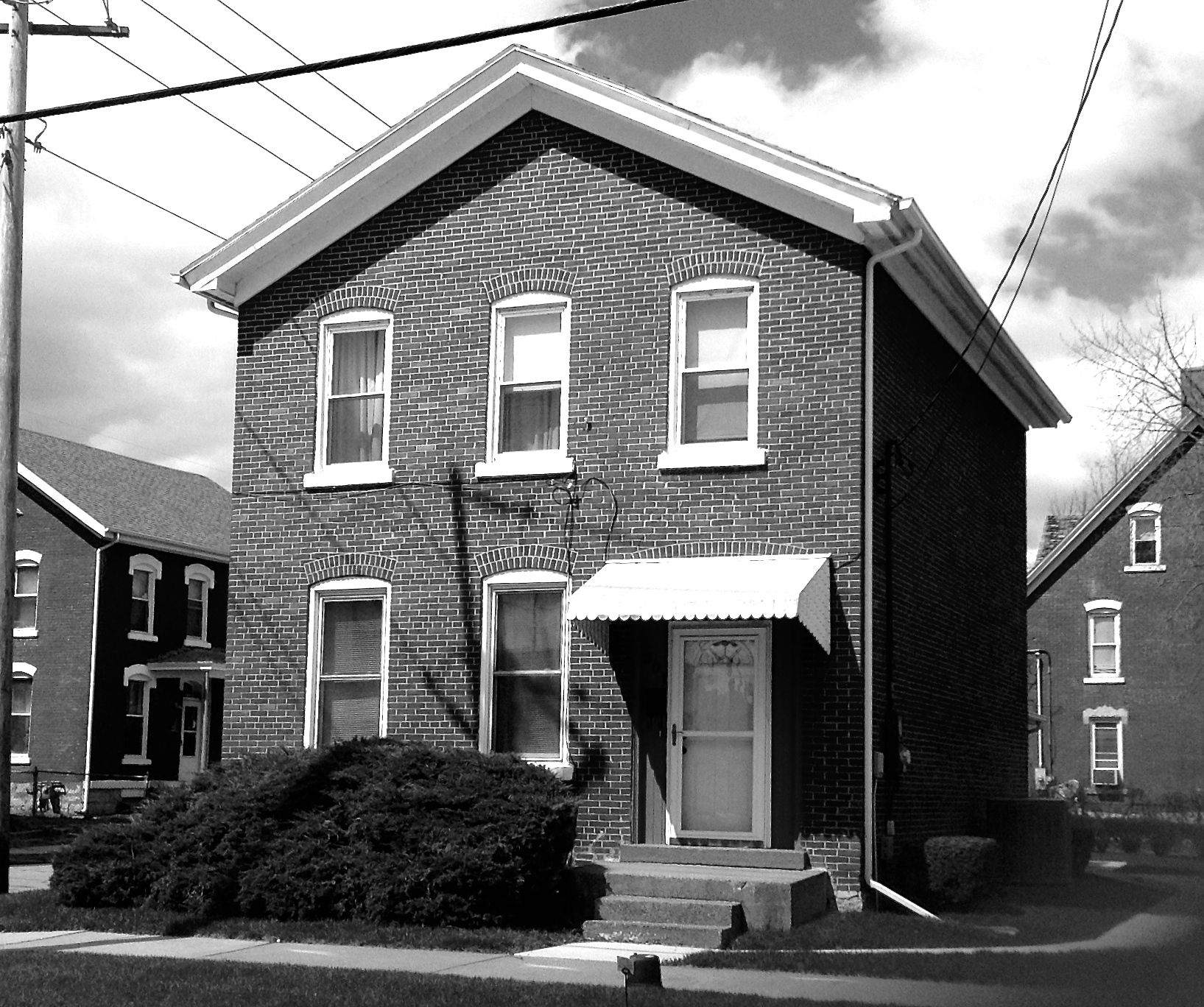
Elmer & Anna’s rented house at 301
E.¬ 22nd
Street in Dubuque, photo David Howe, 2015
All the rest of the children were born in the house on 22nd Street. The
house was a two story brick with a long entrance hall and a stairway
going upstairs. There were 3 bedrooms upstairs and a living room, dining
room and kitchen on the first floor. The house had both a front and back
porch. They had a large yard with grass and flowers. There was indoor
and outdoor access to the cellar. Lucile remembers sliding down the
cellar door. One time she got a splinter in her behind and her Dad had
to take it out. Down the street was Jungk’s Bakery frequently visited by
the kids. On the corner was Shandral’s Butcher shop. A friend of
Bob's, Joe Frederick, owned the house on the corner. As a young man,
Joe went into the service and was killed.¬
All the children were born at home. Dad would bring a bed downstairs and
put it in the dining room in the house on 22nd Street and that is where
the children were born. It seemed to Lucile that mother always had that
happen during the day when the rest of the children were away at school.
When babies were born, they used to have a nurse come and stay right at
the house. The nurse would live with the family for 10 days and assist
while the new mother was kept quiet. Bud remembers the story that Elma
and Lucile wanted a brother boy, they mispronounced it "budder
boy". Then Elmer was born. That is how he became Bud "a budder
boy". Lucile remembers the long hall on 22nd street. Elma and
Lucile could never go out to play after lunch until they wheeled their
"budder" to sleep in the baby carriage, up and down that long
hall. Someday he would go right to sleep which was a joy because the
girls could go out and play, but sometimes that little
"so-in-so" would act up and just never go to sleep. The girls
could hear the kids playing outside and would get so upset. Bud
remembers 4 children sharing a bedroom, Catharine and he in one double
bed and Elma and Lucile in the other.¬
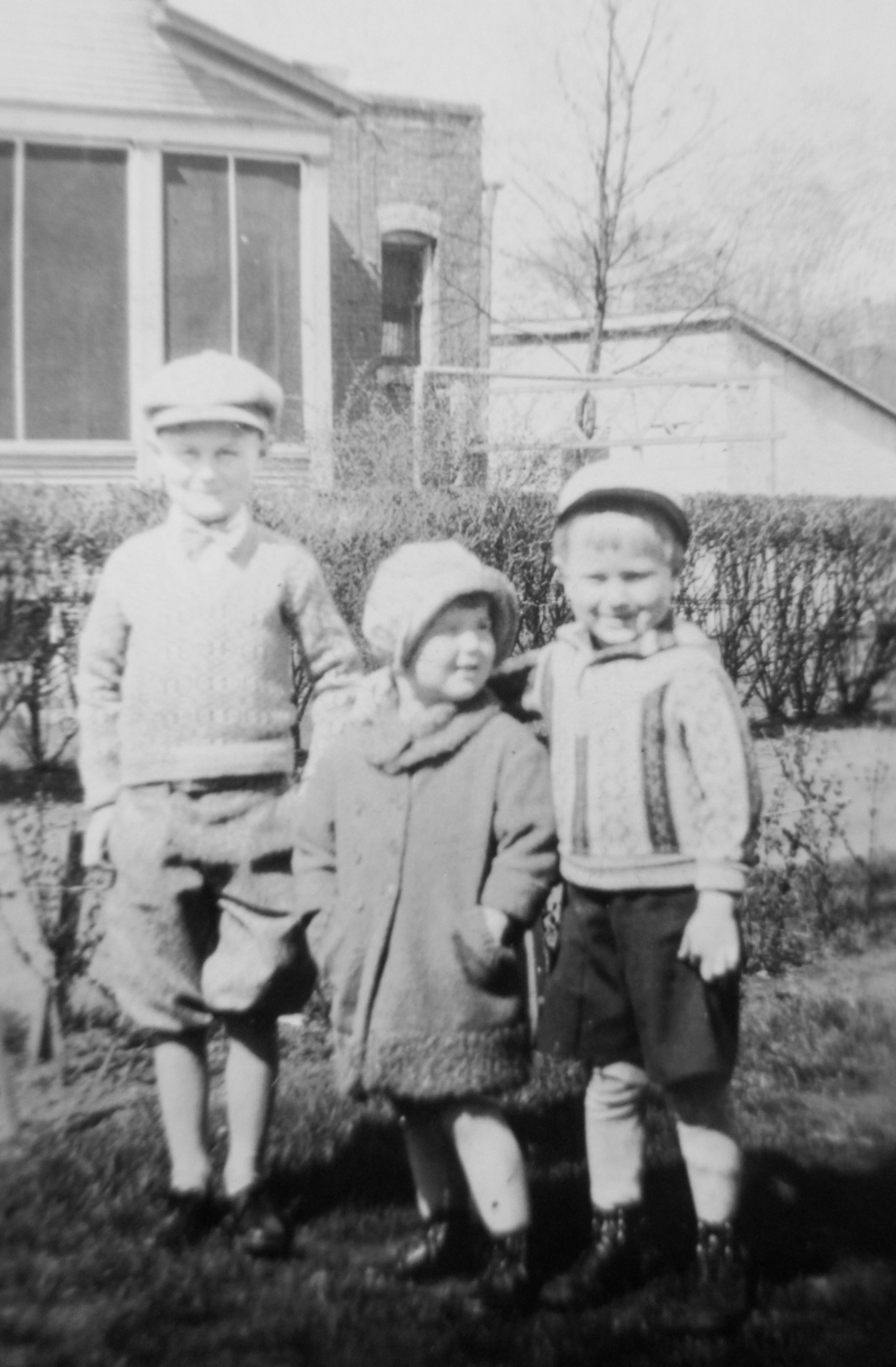
¬ Three of the Voels children in the back yard of home on 22nd
Street, left David, center Mary Jeanne, right Robert
All remember those trips to the outhouse in the winter were murder. When
they put water in the house and a bathroom, they thought it was
wonderful, even if 2 adults and 8 children had to share the single
bathroom. Lucile re-collects that she had a good childhood, had fun.
They were about 4 blocks from Sacred Heart School where they all
attended grade school. It was a nice big school. They were taught by
nuns. A lot of life was centered around religious activities. Life was
simple. Very few people had automobiles. The family had a wonderful
mother. She really worked hard, washing and cooking for a growing family
with no modern conveniences. All the kids had their chores. Lucile
remembers when the streetcars ran on 22nd street. When they got to the
end of the line, the motorman would jump out and reverse the trolley.
While they were living on 22nd street, the city eliminated all the
trolleys and went to buses. Elmer never had or drove a car. Relatives
had cars but not Elmer and Anna. They really couldn't afford one but
they never really felt the need as they had good bus transportation.
Elmer worked at night as the stage manager at the Grand Opera House in
Dubuque (later became a movie theater - The Grand). Dad used to tell
about his experiences at the theater. When they had ‚ÄúBen Hur,‚ÄĚ for the
chariot race scene, they had 9 horses on treadmills on the stage. Later
he was the projectionist so the family didn't see him much. Bud used
to take his dinner down to him in the evening. He remembers how his Dad
would run the multiple film reels to maintain a continuous movie. Elmer
would sleep late and loved bacon and eggs for breakfast. He also loved
oysters. Anna worked hard doing the cooking, cleaning, laundry, etc for
her large family. Anna did a lot of canning and made ketchup and
preserves. Bud remembers that Uncle George would come by and say. Auntie
Anna, you make the best ketchup in the world. It was a struggle to make
it and she would always give him several bottles. The house they rented
had 3 bedrooms and as the family grew, they kept the bedrooms full,
Elmer and Anna's room (often had a baby in the room with them), the
boys’ bedroom and the girl’s bedroom. Bud recalls that after his
brothers were born, he, Dave and Bob slept in one bed. At first there
was no indoor plumbing, but later it was added.¬
¬

From the left, Jenny Hoffman, Anna Mae and Mary Jeanne
The boys had bicycles (not allowed for the girls in the early days). The
children all took music lessons, the girls had to take piano by
tradition, but the boys took up other instruments. Dave took the violin
and drove everyone crazy. One of the boys took the saxophone. Bud was
Mrs. Hop's (a neighbor) favorite. Bud used to go down there all the
time and Mrs. Hop would give him treats. One time she did not have
anything, and Bud said, "Auntie Hop, ain't you got
nothing?" Elmer built a little golf course in the back yard. He
buried tin cans for the holes. He had nine holes. He had all kinds of
things, a little bridge, and a real miniature golf course before its
time. Lucile remembers Dad planted a row of zinnias across the back of
the lot. There was a well and a pump in the backyard. On hot summer
evenings. Bud would pump and pump buckets of cold water. They would pour
the cold water on the back porch and the family would sit there to cool
down. “When we lived on East 22nd St. there were at least sixteen or
more kids in the neighborhood and we always played games on summer
evenings--Run Sheep Run or One O‚Äôclock And The Wolfs Not Home.‚ÄĚ
Bud and Betty Voels remember neighbors, the Heuchelin's had a
cottage at Frentress Lake, the other side of East Dubuque. Every summer
the Voels family would rent the cottage for a week. The cottage had one
big heating stove there in the dining room.¬
The Heuchelins had some acreage near Grand View Park where there were
some great big trees there. On his days off, our Dad, Elmer, would go up
there and cut trees and bring them home and put them in the back yard at
22nd
Street. Then he hired a man (had a bad eye, lived up the street) to cut
up the wood to firewood size for the stove. Sunday nights when Dad was
off, he would build a big fire, when it burned down to glowing coals, he
would open the door of the stove, it was almost a foot square, and he
would shake the popcorn popper in there. This large stove was just used
for heating, not for cooking. There was a hole in the ceiling, and that
is the way the upstairs was heated. At night in the cold weather you
really needed to cover-up. The only bad thing was to have to go out to
that path in the back. Every Monday Mom did the laundry. Bud had to fill
the big copper boiler in the evening. In the morning before going to
school, Bud had to put the hot water in the machine for her so she could
do the laundry. She used shaved soap. The ringer was hand operated. She
would put a couple drops of "bluing" in the cold rinse water.
Had 2 tubs, the first rinse and the last rinse.
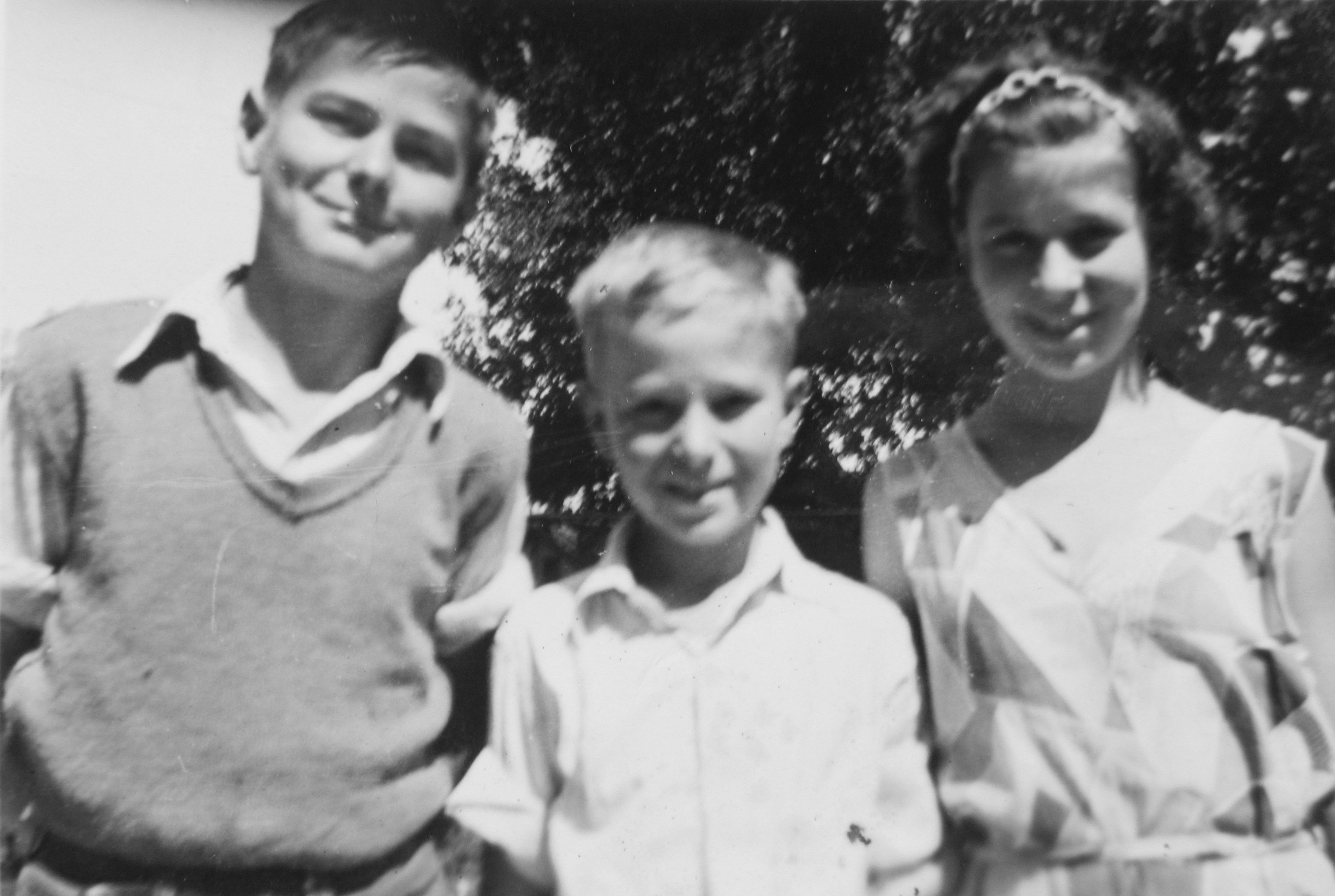
¬ Three of the Voels Children in the back yard of home on 22nd
Street, on left David, center Mary Jeanne and right Robert
When Bud got home from school, it was his job to empty the water for
her. The family had a pump with a drain, and that is where he would have
to dump that water, bucket after bucket. Every Monday the family would
have pork chops with macaroni and tomatoes. Bud remembered. Mom baked
lemon pies for Elma. Saturday night was hot dog and potato salad night.
Chicken on Sunday. Bud always got the wings or so he remembered. Anna
loved the circus. The train would pull in down by the river. She would
get up all the kids early, 4 or 5 am. The train would off-load all the
wagons and animals on the lower part of Main Street. They would parade
up Central Avenue, elephants and all. The parade would last for hours
until lunch.
Sacred Heart School in Dubuque
From the ‚Äúon line‚ÄĚ Encyclopedia of Dubuque Sacred Heart
was a catholic school that began with a layman principal. With the
founding of Sacred Heart parish, classrooms for Sacred Heart School
were located on the first floor of the Pape Memorial Building. The
second floor was used for church services. Sacred Heart School was
formally opened on January 15, 1881,with an enrollment of one
hundred fifty-four students. The classes were taught by Franciscan
Sisters from Dubuque.¬
Within eight years, crowded conditions led to the construction of a
new church. The second floor of the first combination school-church
building was remodeled into four classrooms. Additional classroom
space was provided in 1891 by the construction of Marquette Hall.
Sacred Heart had the unique tradition for many years of having a
layman principal. This person also acted as the church organist and
teacher for the upper-grade boys. Beginning in 1952, the principal
of Sacred Heart was a Sister. The continued growth in parish
population brought the school enrollment in 1912 to seven hundred.
Classes were held on the ground floor of the rectory, in the first
Marquette Hall, Sisters' convent, and every available room in
the Pape Memorial Building. Beginning on March 19, 1915, work was
started on a new school that was dedicated one year later. On March
20, 1916, five hundred students began classes in the new school with
the remaining classes held in the Pape Memorial.¬
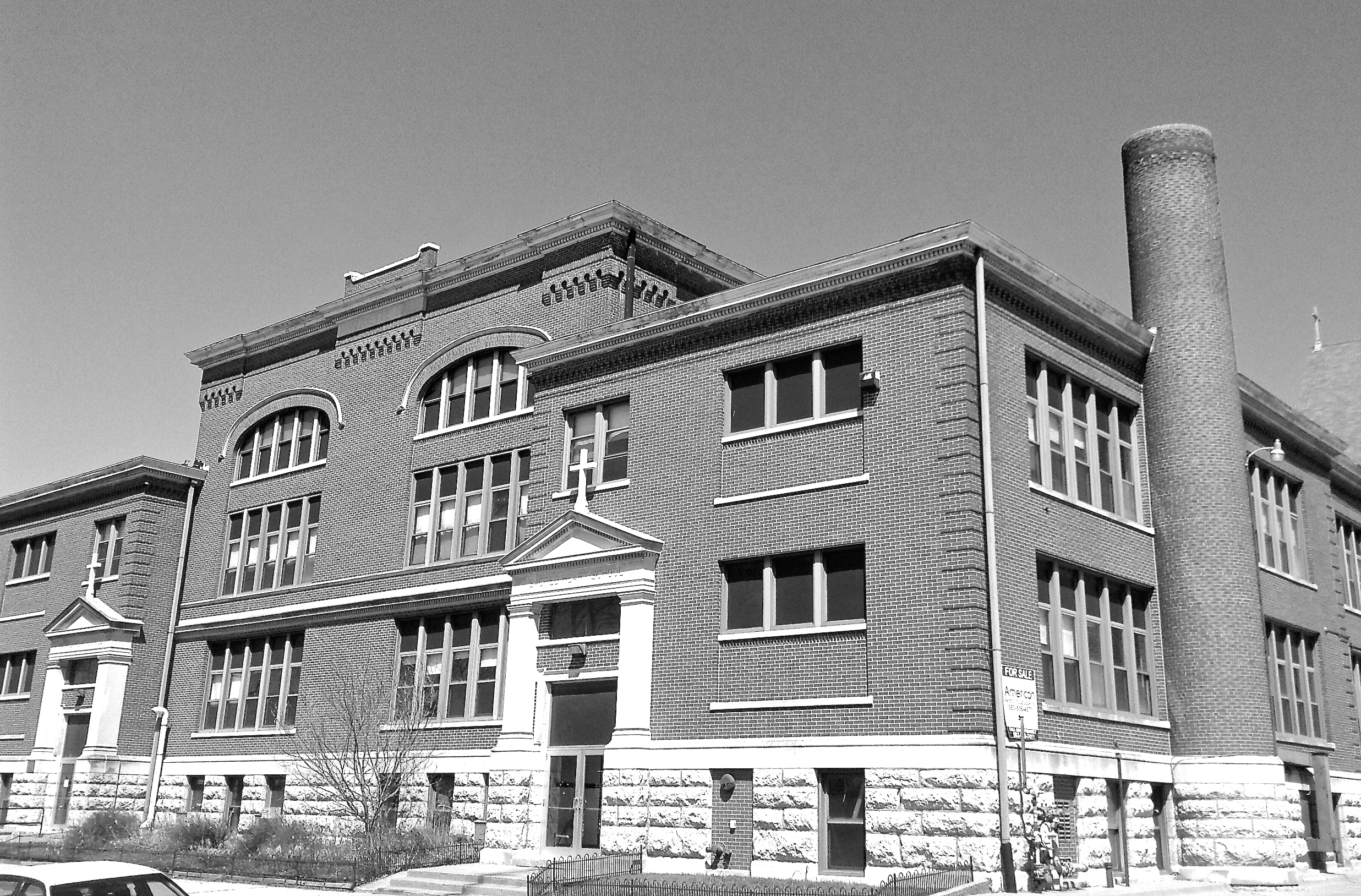
¬ Sacred
Heart School, picture by David Voels
All the children went to grade school at Sacred Heart School. It cost 50
cents per month. They were taught by the Franciscan nuns. Some were
sweethearts, some were little old crabs. The students had nicknames for
the nuns. Students were expected to go to Mass every morning but the
Voels children did not always make it. They had to walk to school and
had to cross a railroad crossing. Frequently a long freight train would
make the Voels kids late for mass. The children had to memorize bible
stories, one a week. They would be called upon to recite it or part of
it and someone else would carry on. There was not much activity after
school, the nuns preferred the students go home.
SACRED HEART CHURCH IN DUBUQUE
From the ‚Äúon line‚ÄĚ Encyclopedia of Dubuque Industrial
development in northern Dubuque beginning in 1875 attracted many
young families with children to the area. Most of the people were
Catholics from German-speaking regions of Europe. The present site
of Sacred Heart Church was purchased, and work began in 1880 on a
two-story combination church and school. One story was designated
for the church. The other was used as the school. The cornerstone
was laid on August 15, 1879. Construction was completed on December
12. To minimize costs, much of the work was furnished by
parishioners. The school was not opened on this date because the
rooms were not finished. Worship was held on the second floor, while
school was held on the main floor. The basement and one of the rooms
on the first floor were used as a convent. A house was rented south
of the church as a rectory. An economic boom occurred on the north
end of Dubuque with the construction of the Milwaukee Railroad
Shops. Soon the church was filled to capacity. The cornerstone for a
new church was laid in 1887 on Palm Sunday. The church, with a
seating capacity of one thousand one hundred, was dedicated on July
7,1888, and the first church building was remodeled for classrooms.
Additional buildings included a parish rectory and Sisters'
convent. The members of the parish continued to feel a great need
for more schoolrooms and a place to hold meetings. On Thanksgiving
Day 1891, Marquette Hall was formally opened. This served the need
for social and school space until the new school was opened in 1915.
The church installed a Wangerin-Werchardt organ and twenty-one
stained glass windows in 1922. A convent built to house twenty-two
nuns was constructed on Queen Street in 1966. The church, located at
2215 Windsor, is recognized for its two distinctive spires. The
taller, into which clocks were installed in 1982, rises two hundred
feet. The shorter tower has a height of 135 feet.
¬
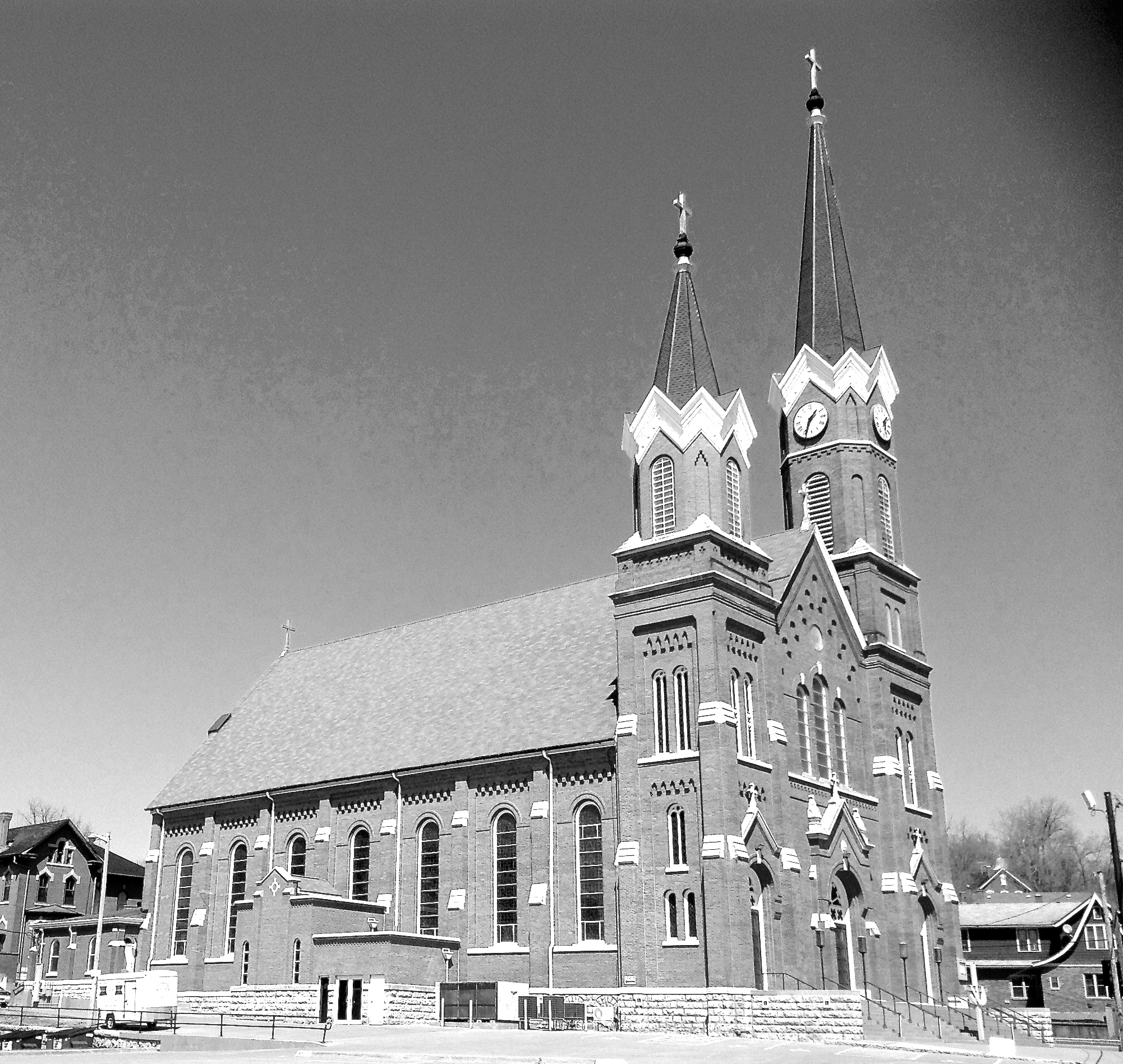
Scared Heart Church on the corner of 22nd
and Windsor. The school was built in 1880 and was used temporarily
as a church. Photo by David Voels
The Voels family was closely associated with Sacred Heart Church with
baptisms, first communions, confirmations and weddings being held there.
IMMACULATE CONCEPTION ACADEMY, DUBUQUE
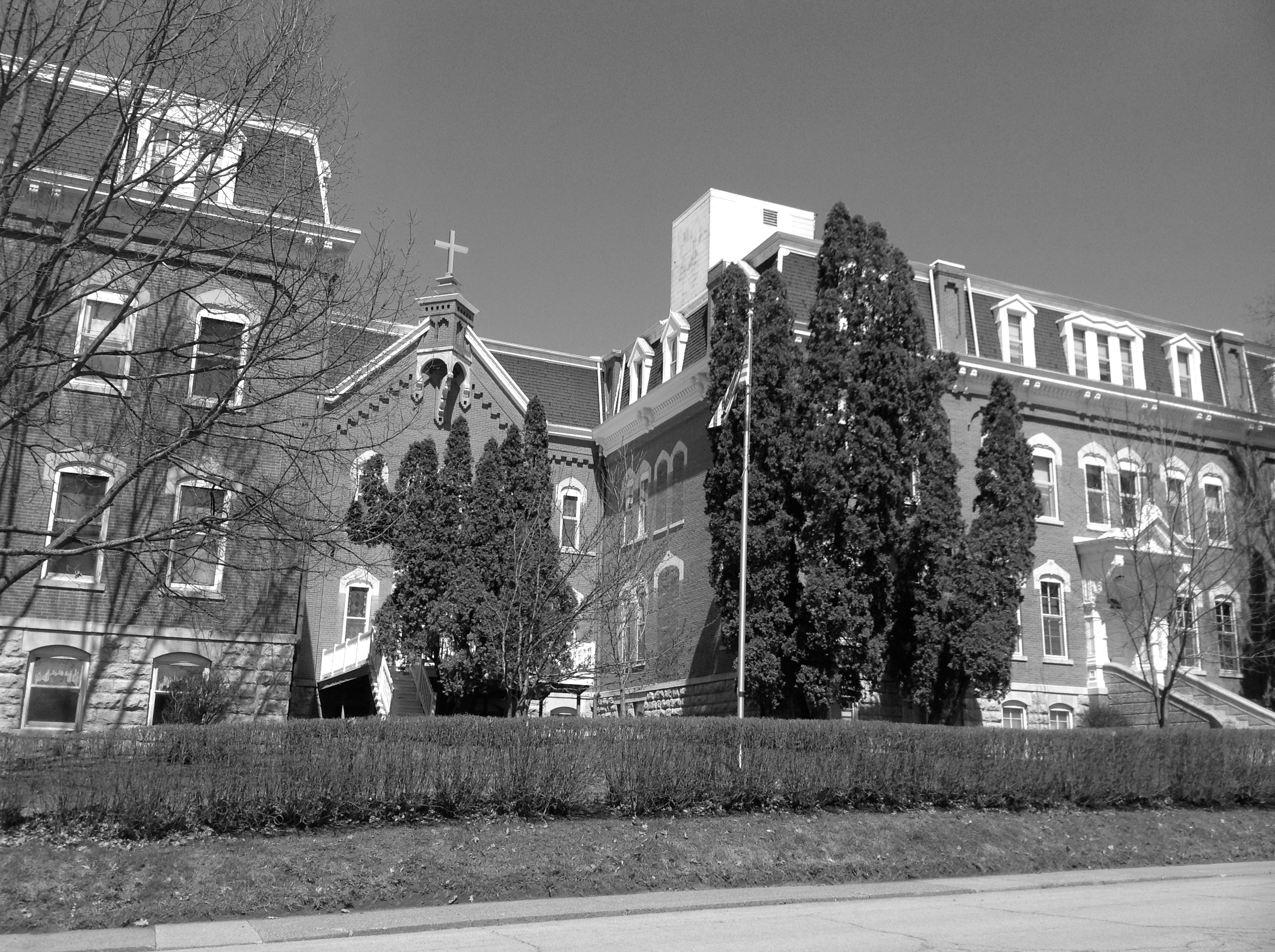
From the ‚Äúon line‚ÄĚ Encyclopedia of Dubuque Established
in 1907 by the Franciscan Sisters of the Holy Family, Immaculate
Conception Academy occupied a historical building. Since its
construction in 1854, the structure had served as the home of the
DUBUQUE
FEMALE SEMINARY, the first public high school, an
Episcopalian seminary, and a Lutheran seminary. It was purchased by
the Sisters of St. Francis and dedicated to the Virgin Mary, and
opened as a high school for girls. The first class consisted of
twenty-four students, twelve of them residents at the school.
The students were offered four tracks of study. The Preparatory
offered "a thorough training in the grammar grades." The
Academic offered a complete four-year high school course. The
Commercial involved a "thorough course in book-keeping and
stenography." The Normal was for those preparing to take
teacher examinations. The last was the department of Music and
Elocution. Shortly after the establishment of this program, courses
in art, sewing, and "domestic science" were added. By 1920
the Academy, a "boarding day school was well established with
eighty resident and sixty-six day students.¬
Increasing numbers of high school students by 1921 led to the
two-year normal and two-year commercial departments being
discontinued although electives still allowed a student to quality
for a teaching or commercial employment. High school courses became
basic with art, music, sewing, and domestic science being taught
independently. Religion was a required subject for Catholic
students.¬
In 1924 because of enrollment increases, it was decided to move
Immaculate Conception to a site on Davis Avenue in the former
motherhouse of the order. Students and sisters in the school may
have opposed the move because they offered a Novena to "Our
Lady" requesting that the transfer would fail. Sisters at the
Motherhouse, however, offered their own Novena asking that the
transfer would be successful. With renovations, the building was
ready for 171 students. In 1939 Immaculate Conception was accredited
by the North Central Association of Colleges and Secondary Schools.
¬
Most of the Voels girls attended the Immaculate Conception Academy after
completing eighth grade at Sacred Heart grade school.
Life on Francis Street
In 1929 their landlord decided to sell the house on 22nd and the family
moved into a rental brick duplex at 2295 Francis St. (Elma the oldest,
was 20 and Ann the youngest, was 5). Lucile remembers they lived in what
she called a "1/2 house". Wimers lived across the street.
Bellnaps lived upstairs. The Bouies lived next store and owned the
duplex. The family lived there about 4 years.¬
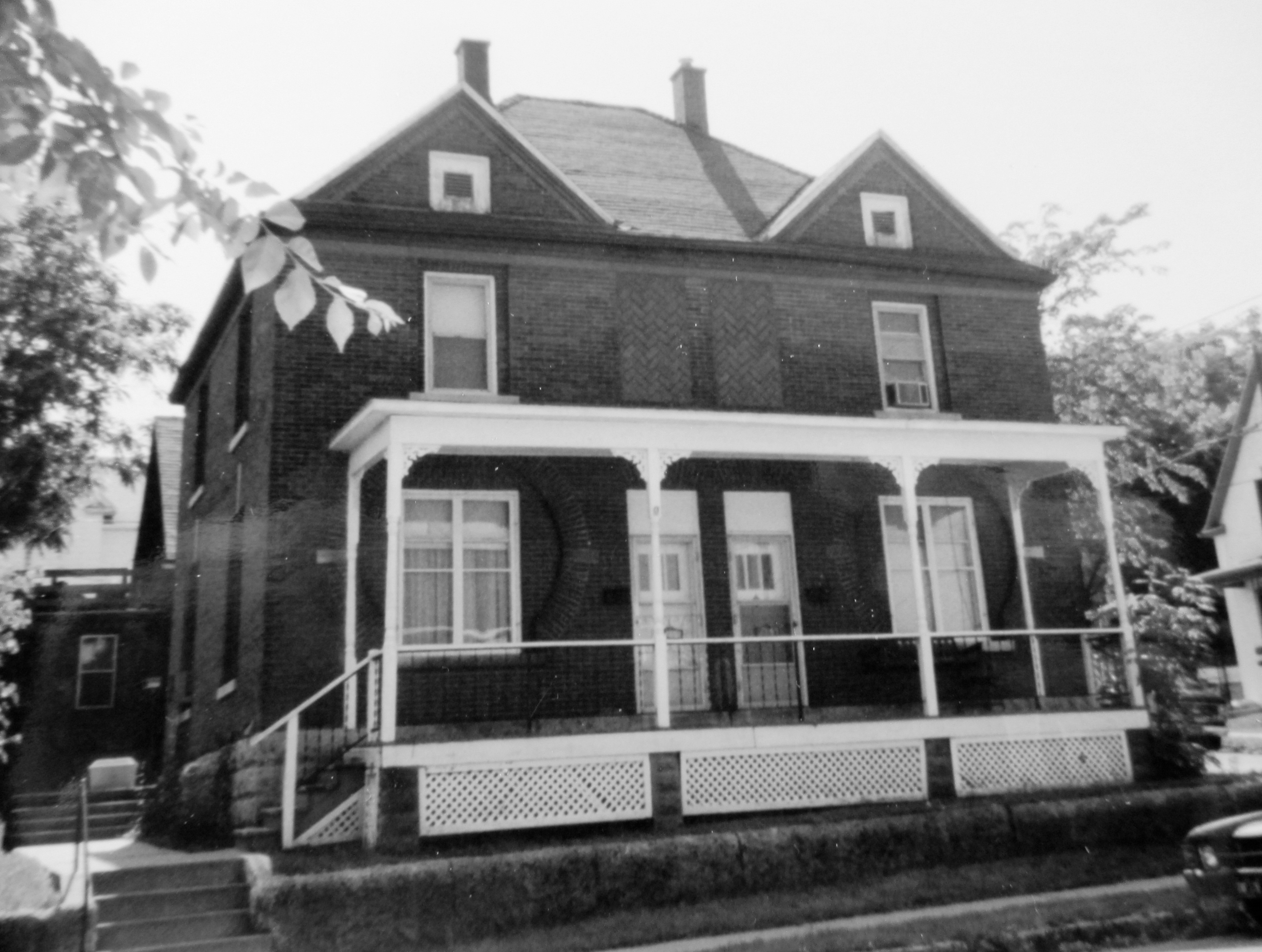
¬ In 1929 their landlord decided to sell the house on 22nd
Street and the family moved into a rental brick duplex at 2295
Francis Street. Photo taken in 1996.
Lucile remembered, when we moved to 2295 Francis St. it was in the fall
and the weather was cold Dad made a fire for the first time in the
furnace and the thermometer hit 100 degrees. He had to open the windows
to get the temperature back to normal. ‚ÄúNo thermostatic control‚ÄĚ. When
we got our first refrigerator, Anna Mae and Mary Jeanne would sit on the
front porch swing with a bowl of ice cubes to munch on and that was
quite a treat.¬
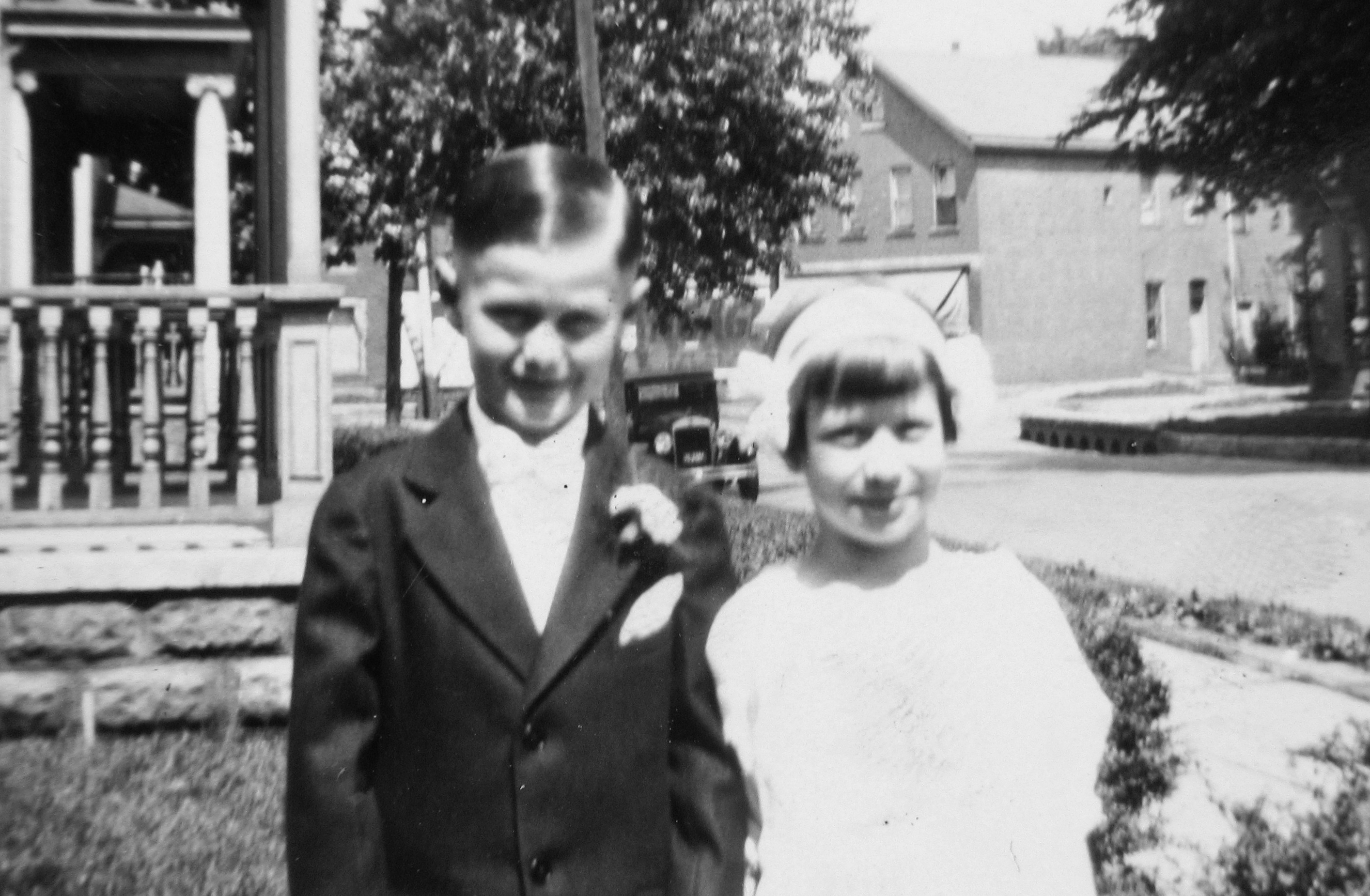
David’s First Communion (second grade), Mary Jeanne (first
grade)
In 1933 Elmer and Anna purchased the house at 2260 Francis St for $3500.
It was a 2 story brick, 3 bedrooms and bath upstairs, living room,
parlor, dinning room and kitchen downstairs. Separate garage. Nice home,
nice neighborhood. People sat out on their front porches. Also had a
covered back porch. Smiths lived on the right side, the Slades across
the street. Had clematis on the trellis by the front porch. The house
had both front and back porches. The house had a front porch swing.
There was a separate garage and an alley

Voels House at 2260 Francis St. Photo taken in the 1930s.
in¬ the back of the lot. There was a large
living room, a second sitting room with a piano, a full sized dining
room and large kitchen. Upstairs they had 4 bedrooms but no plumbing.
There was plumbing in the basement. They converted the smallest
upstairs bedroom into a bathroom/dressing room.¬
The dining room had a real deep closet with a light in it. Dave was a
seminarian student and would often bring other students home for a meal.
They used to have to read their "office" each day. Because
there was so much noise around the house, they used to go into that
closet to say their prayers.¬
Mother used to hide cookies she made. She would make a
huge amount of cookies for all the children. One time Ann found the
peanut butter cookies in the back of the closet (to this day, she can
not face peanut butter cookies). At holiday time Anna would bake loads
of cookies. Mom was a wonderful baker and in addition to those good
pies she made the best rolls and coffee cake ‚ÄĒof course without a
recipe. She would have a couple big tins of cookies. At nighttime, to
keep the kids from stealing the cookies, she would take the tins up to
her bedroom. Most of the children got married during the war years and
while the family lived here. In the back yard Dad had a beautiful rock
garden filled with flowers; he loved his yard. They a cherry tree in
the back yard. The boys would cut the branches off instead of climbing
up the tree to get the cherries and finally the tree died.¬
“About every other week in the summer when we lived at 2260 Francis
St. we would go to Eagle Point Park with Josie Kasel and family for a
picnic.‚ÄĚ Josie always baked the cake and Mom made the German Potato
Salad. “l
always had to peel those boiled potatoes.‚ÄĚ ‚ÄúUGH‚ÄĚ we stopped on the way
to the park at Trenkles for their good wieners.
Lucile recounts an interesting story that goes like this. “One of the
kids got smallpox. The house was quarantined. Elma and Lucile were
working and had to get a room downtown (a large home for working women
run by the nuns). Room and board was $6 per week. The girls shared a
nice room within walking distance of work. Lucile worked at the Thomas
Flynn Coal Company and Elma worked for the Piekenbrock Shoe Company.
Every once in awhile they would take a bus and go by the house and talk
to the family but could not enter and none inside could leave. They
would leave things by the door and the family would come out and pick
them up. Elmer was working but Anna was stuck in the house by herself
with all the rest of the children. This was right before Christmas and
Anna Mae remembers that Elma and Lucile bought everyone wonderful
Christmas presents. Anna used to bake fruitcakes that Bud adored. One
time in July, she found two fruit cakes in the basement and they were
hard as a rock. She brought them upstairs, wrapped them in a dishtowel,
poured wine over them, and let them sit for about a week. They got nice
and soft and Bud ate both of them.‚Ä̬
¬ Friday night was serial night at the Capital
movie theater. Each night at the end of the episode, the hero would be
in eminent danger, like the plane would be spiraling straight down and
it would be continued next week. Ann also remembers that the family had
a theater pass because Dad worked at the Grand and she remembers going
downtown to the big Orpheum Theater (now the Five Flags), to see the
Phantom of the Opera. She was so scared that she got out of her seat
and got down under the seat and said "Let me know when it ends".¬
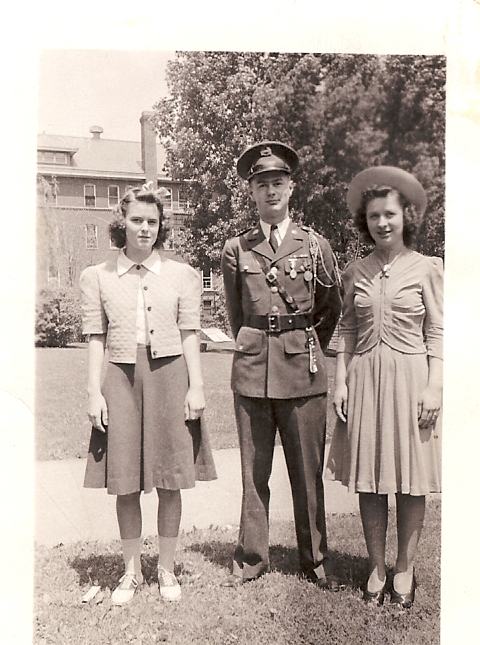
David’s high school graduation from Loras Academy with his sister Ann
to the left and his sister Mary Jeanne to the right. David is in his
ROTC uniform.¬
Bob remembers an episode that goes like this. “One morning Dave and Bob,
together with the Wise boys, Ralph and Vince, went over to the Slades.
They had a beautiful apple tree in the yard (Yellow Transparents) and
the boys robbed the tree. Mrs. Slade got very angry but she did not know
who did it so she called the police. When the police arrived, they found
the 4 boys sitting on the front porch swing surrounded by apple cores.
The boys admitted it. What was worse, they found their poor, innocent
mother in the kitchen peeling apples and making apple pies.‚ÄĚ
From the ‚Äúon line‚ÄĚ Encyclopedia of Dubuque In 1894
Father John P. Carroll, the president of Saint Joseph College
abolished the preparatory department and established a combination
six year high school and college curriculum. A student entering the
high school department was required to have eight years of previous
academic work. The secondary program was then set at three years. A
four-year schedule was arranged for the high school in 1915 with the
first year including grade school subjects. The high school course
became a full four years in 1917. In 1927 what had become Columbia
Academy was accredited with the North Central Association of
Colleges and Secondary Schools. In 1939 the name was changed to
Loras Academy.¬
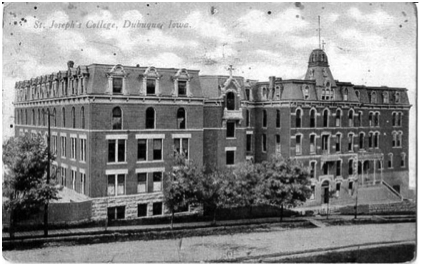
St. Joseph Hall at Loras Academy
In 1918 the combined high school and college departments had an
enrollment of 358 students. In 1928 the high school alone had 324
students instructed by thirteen priests and two lay teachers. The
high school was both a boarding school and a day school. Located on
the college campus, exceptional high school athletes were encouraged
to join the college teams. Extra-curricular activities were
abundant. In 1935 the Reserved Officers Training Corps (ROTC) was
organized on the Columbia (Loras) Academy campus. The school thus
became one of a few high schools and the only Catholic ROTC Honor
High School in Iowa.
¬
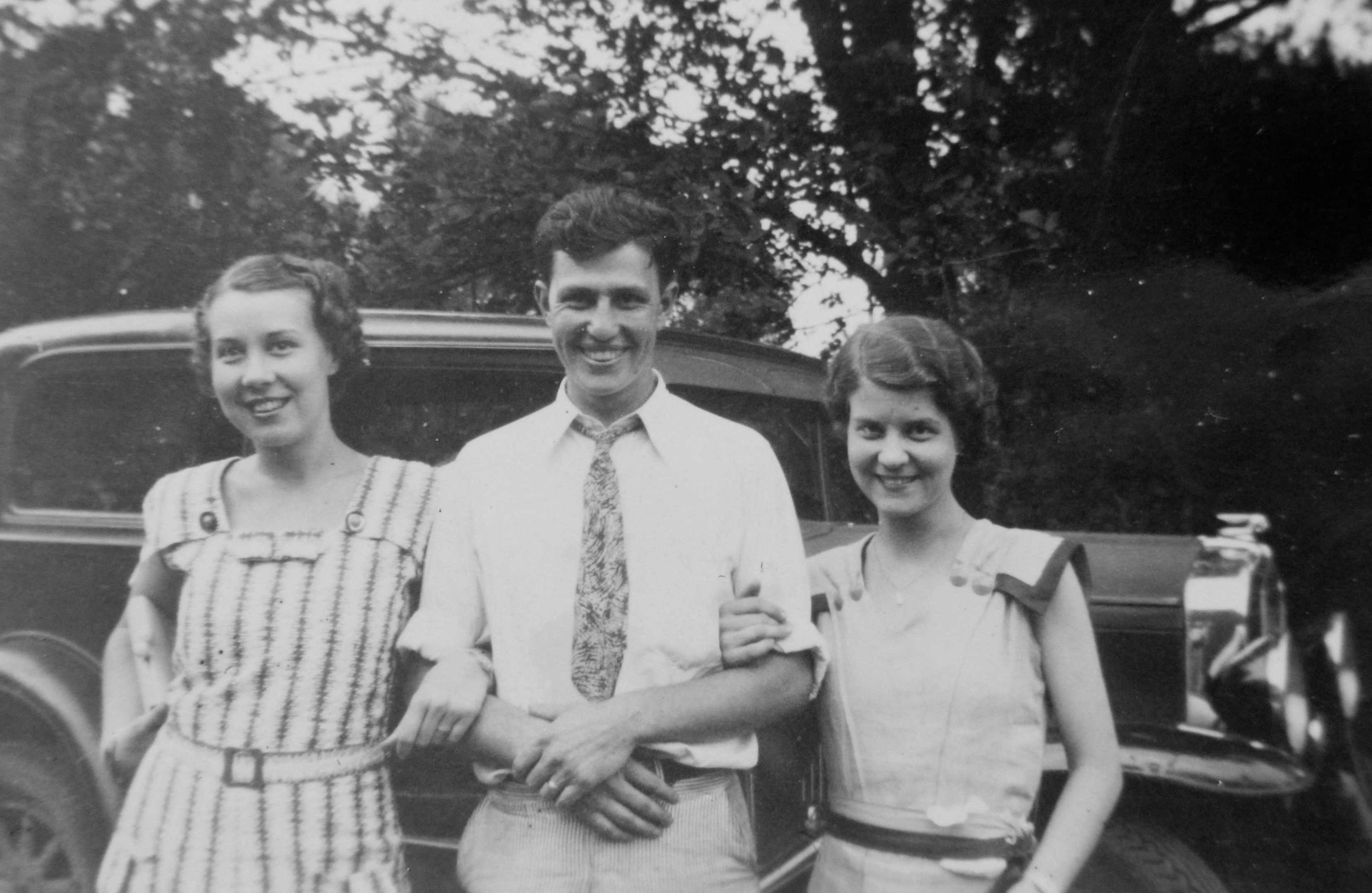
From left Lucile, Al Howe & Elma Voels¬
Bob Voels remembered that Carl Kleeman played baseball for a team at
Granada Gardens. Sunday mornings he would pick up Bob in his model A so
Bob could be the batboy for the games. Bud remembers the movies were two
for a quarter on Friday nights. He would go up to a man or lady who were
in line alone and ask if he could go in with him or her. He would say,
it is two for a quarter and you will be paying a quarter anyway, he
always got in.
During the dating years Bud remembered one of the girls was dating
Johnny Burns. Johnny had a big head of hair and got hair grease all over
the wallpaper behind the sofa. Gram did not like him at all. Betty
remembers the story when Paul was dating Mary Jean and broke the sofa at
Gram's. It took her a long time to forgive him for that. Bud
remembers one time when Paul Schramm was dating Mary Jean and Paul
Cramer was dating Anna Mae. The girls went to a movie at the Grand. They
were walking down the street to get their bus and they walked by the
"HubaHuba" tavern. Ann said it looks like Paul in there, and
Mary Jean said, Paul would never go in this place. They looked in the
window and both Pauls (Schramm & Cremer) were sitting at the bar.
Betty recalls one night Bud and Carl Kleeman drove back from East
Dubuque where they had been at the Hilltop and saw the belly dancers.¬
¬
They forgot to turn on the car lights. They got stopped at about 20th
and Jackson St. by the police. The policeman knew Bud and he stuck his
head in the car and said, “Elmer, don't you think you ought to at
least turn your lights on?‚ÄĚ The officer worked with Fred Voels, their
cousin and he let them go.¬
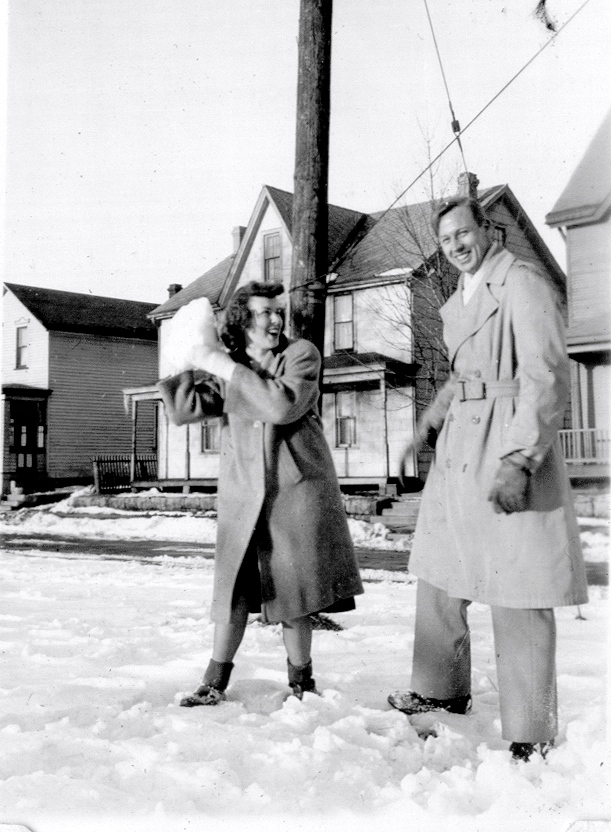
Anna Mae Voels (left) and Bob Cremer (right)
Dave
Howe remembers when Fr. Dave took his folks to Minnesota on a fishing
trip and we kids stayed at Grandmas on Francis St. The fruit and
vegetable man would come up in pick up truck and she would go out in
street and buy things from him. They would talk in German. He also
remembered her making sauerkraut in the basement in crocks. And he
remembered us hiding behind the wood stove in kitchen.
While still living on Francis Street, lots of grand children were born.
Visiting Gram at the Francis Street house was always an adventure.
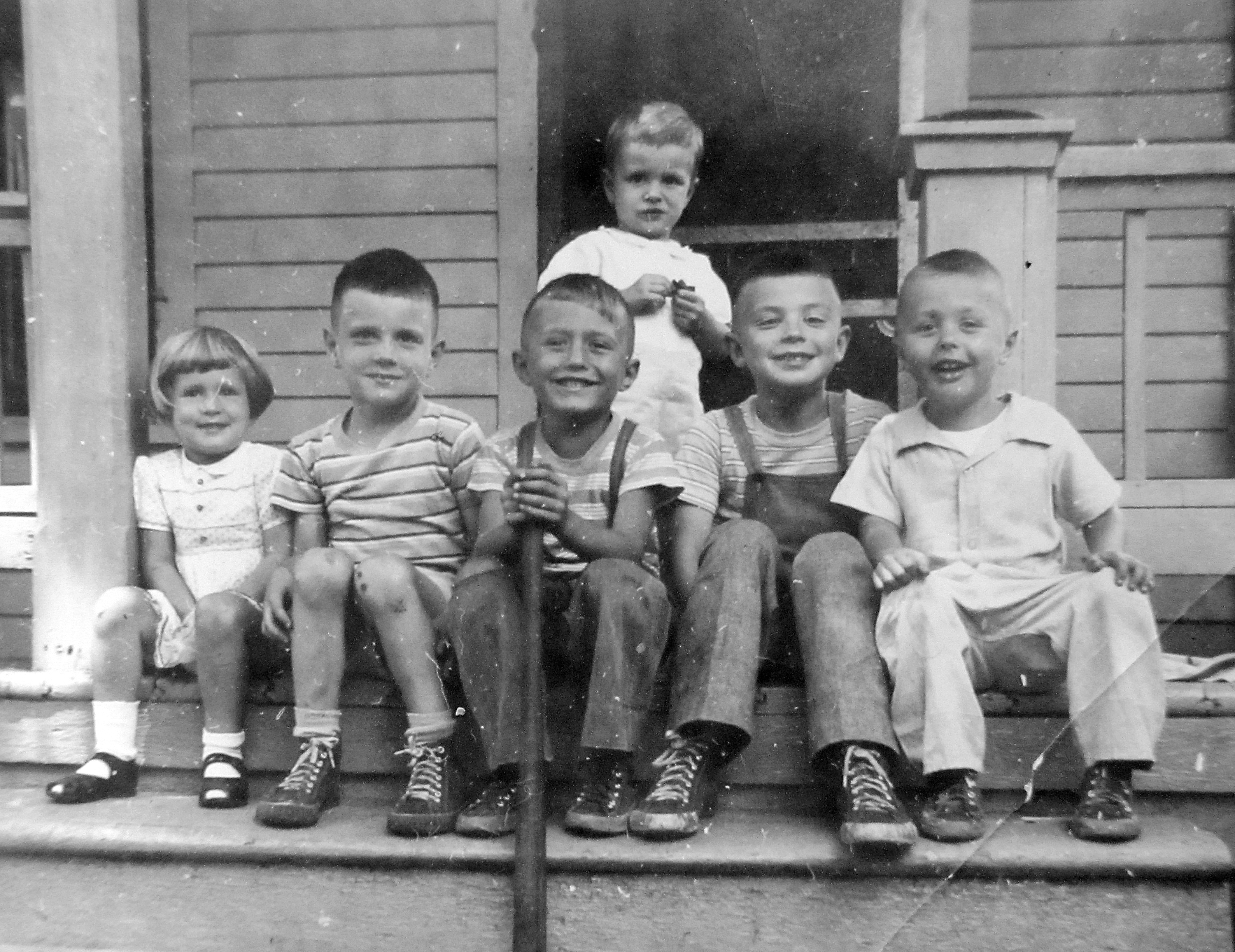
From left, Mary &, Jim Howe, Terry Kleeman, Dave Howe, Jack
Kleeman in back Tom Howe
Voels Family Gatherings at Christmas
In the early days, at Christmas, Mr. Ott, a neighbor, was Santa for the
family. On Christmas Eve, the kids would be taken to the kitchen. While
the kids were in the kitchen, the tree was trimmed and Santa (Mr. Ott)
would arrive. Christmas did not start for the kids until that moment.
Ann remembers that Santa (Mr. Ott) would go to various houses. At every
house he would be offered a little "Christmas cheer".
Sometimes, the kids decided that they were last on the list because when
he would stoop down to talk to the youngest, he would have trouble
getting up.
In the later years after Anna Voels had moved to Cleveland Street, Terry
(Karl) Kleeman remembers: “My most wonderful memories of Christmas were
spent in Dubuque. My parents would stay at Grandma’s and we boys would
stay at the Howe’s. We loved visiting with our Howe cousins. We got to
sleep in a big room upstairs at the front of the house with the boys.
What an adventure. The Howe’s had a wonderful Lionel train set that
fascinated me. This is I am sure part of the influences that led me to a
lifelong interest in trains and my current publications on railroad
history. When we had the wonder family get together at the Howe’s. I
remember the large kitchen filled with wonderful food, everyone so happy
to see one another. We Kleeman kids loved our Voels uncles and aunts and
cousins. And I remember going to midnight mass in the snow. What
wonderful memories of Christmas in Dubuque with family.‚ÄĚ
Elmer Voles last days
Bud remembers when his Dad was ill and Carl and Lucile and Anna took him
to Rochester to the Mayo Clinic. The doctors told the family there was
nothing that could be done. Lucile remembers coming back in the car,
everyone was expectedly glum.¬
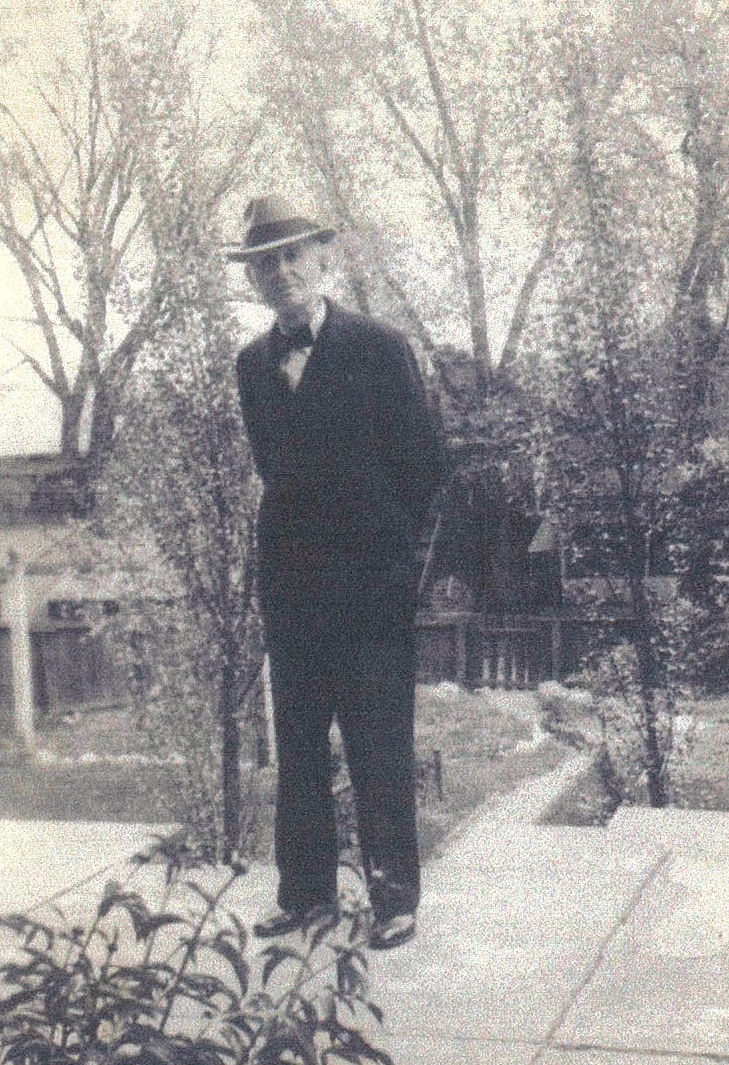
¬ Elmer Voels at home in Dubuque
Dad said, "let's sing" and he started to sing and led them
all. When they came back they did not tell the family of the serious
nature of his illness. After his father's death. Bud always blamed
Dr. Prichal. Bud said Dad had a growth on his neck and Dr. Prichal just
cut it out. Lucile was with her Dad at the doctor and remembers when he
cut out the growth, it broke. Dr. Prichal was the neighborhood doctor so
they all went to him but none of them liked him. Whenever he came to the
house, he gave the kids caster oil and they all hated that. Elmer Voels
died in the upper front bedroom at Francis Street when he was 57. Anna
continued to live in the house for some years (his insurance money paid
off the balance on the house for Anna). Bud helped to support the
family. He was 21 when his dad died. He got paid $24 a week that he gave
to his mother and she gave him back $2.
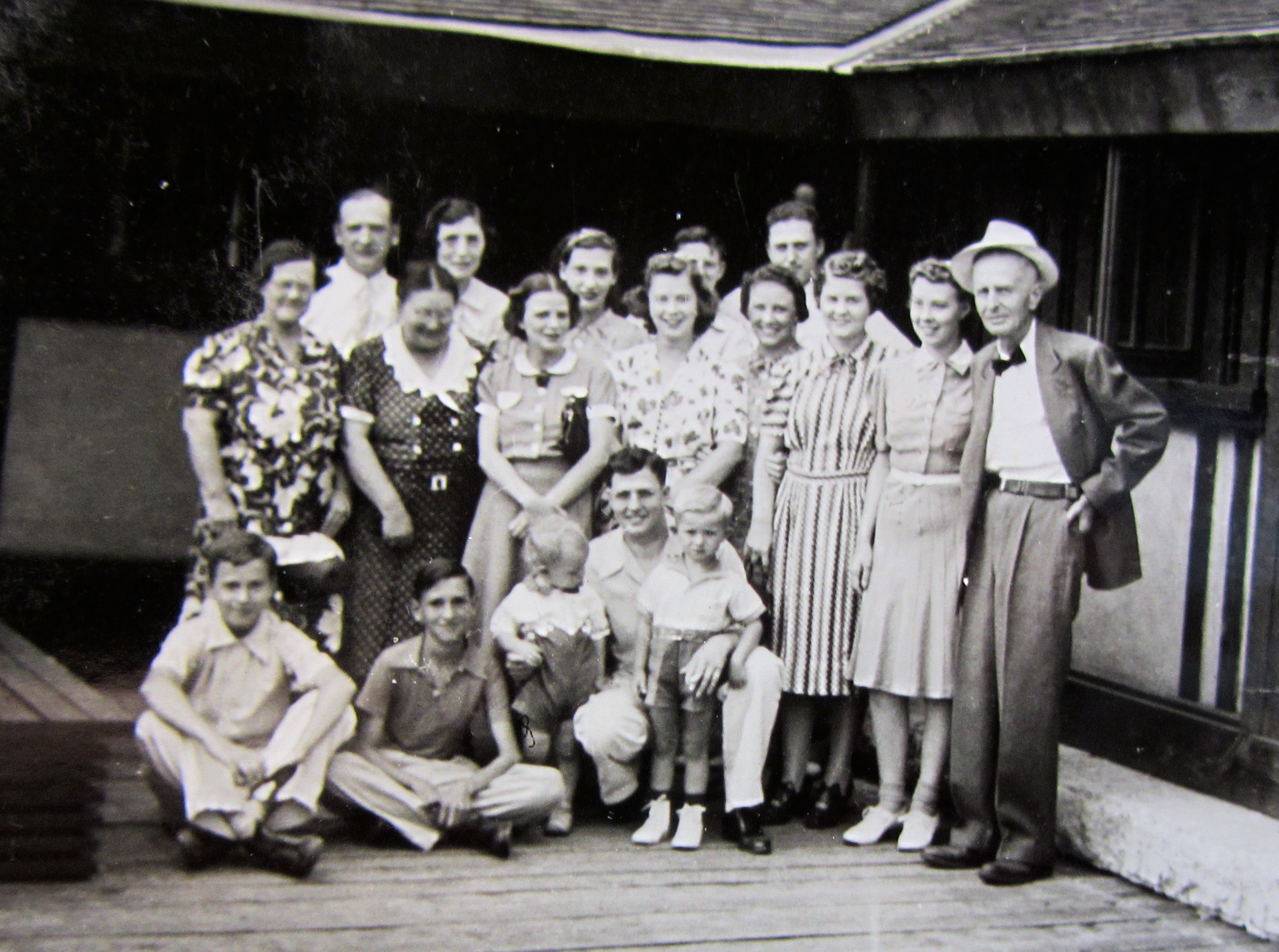
Elmer
Voels (far right), son of Fredrick Voels who had emigrated from Germany
in 1873 to eastern Iowa. Far left, Anna Nesen, Elmer’s wife. Photo
taken at Eagle Point Park in Dubuque in about 1939. Back Row.¬
Cletis and Josie Kasel, Marian Kasel, part of I think my uncle Bob Howe
and Carl Kleeman, Next Row,¬ Grandma Voels, Grandma Howe, Elsie
Howe, Jeannie, Esther (Howe) Richard, Elma, Lucile, Grandpa Howe. Front
Row,¬ Could be Bob Voels, Paul Kasel, Have no idea of the young
child, Al Howe, then I think my cousin Bill Richard.¬
Cleveland Ave Days
Some years later, Anna moved to a small duplex on Cleveland Ave. Karl
remembers the Voels relatives with great love. “I don’t actually
remember living in Dubuque as a toddler. But as we were growing up and
lived in Davenport, Des Moines and then the PI and even while I was in
college, a visit to Dubuque was always special. We were close to the
ages of the Howe family and had such wonder times visiting them in
Dubuque. I have such fond memories of those visits, going for picnics to
Eagle Point Park, playing baseball in the cemetery, wonderful Christmas
visits, and so much more. We often saw our uncles and aunts and other
cousins as well. Everyone was so loving and wonderful and for a young
fellow growing up, this was always so special. I remember an early visit
when we were staying with Gram on Cleveland Ave. and Uncle Bob was still
living at home. One morning after Uncle Bob had been out late the night
before, Gram sent we three boys to get him out of bed. I remember we all
jumped up on the bed. I think he was annoyed but was good to us. And,
when in college and our folks were living in France, we would go to
Grandmas for Christmas break. It was so good to have a home to come to
for Christmas. I will always remember the Voels family with affection
and such good times.‚ÄĚ
Anna’s obituary read, “Mrs. Anna Voels, Mother of Priest,
Dies in Dubuque.‚ÄĚ At that time surviving her were 5 daughters and two
sons, 29 grandchildren and 10 great grandchildren.
Fond Memories of Gram
 The following are Bud Voels (her son’s) remembrances of his mother.
“Anna Voels was a hard working woman who lived for 28 or 29 years after
her husband died. She was a year older than her husband. She brought up
a bunch of kids and did a marvelous job of it. She always managed to
have nice meals for everyone including lots of guests, don't know
how she did it.‚ÄĚ Betty remembers ‚Äúas a mother-in-law Anna was wonderful
and I loved her dearly, Gram was so good. When she first knew Bud was
going to marry me, she wasn't too sure about it. She was afraid I
was on the "re-bound" as I had been engaged to another fellow.
But she accepted me and we had a wonderful relationship.‚ÄĚ
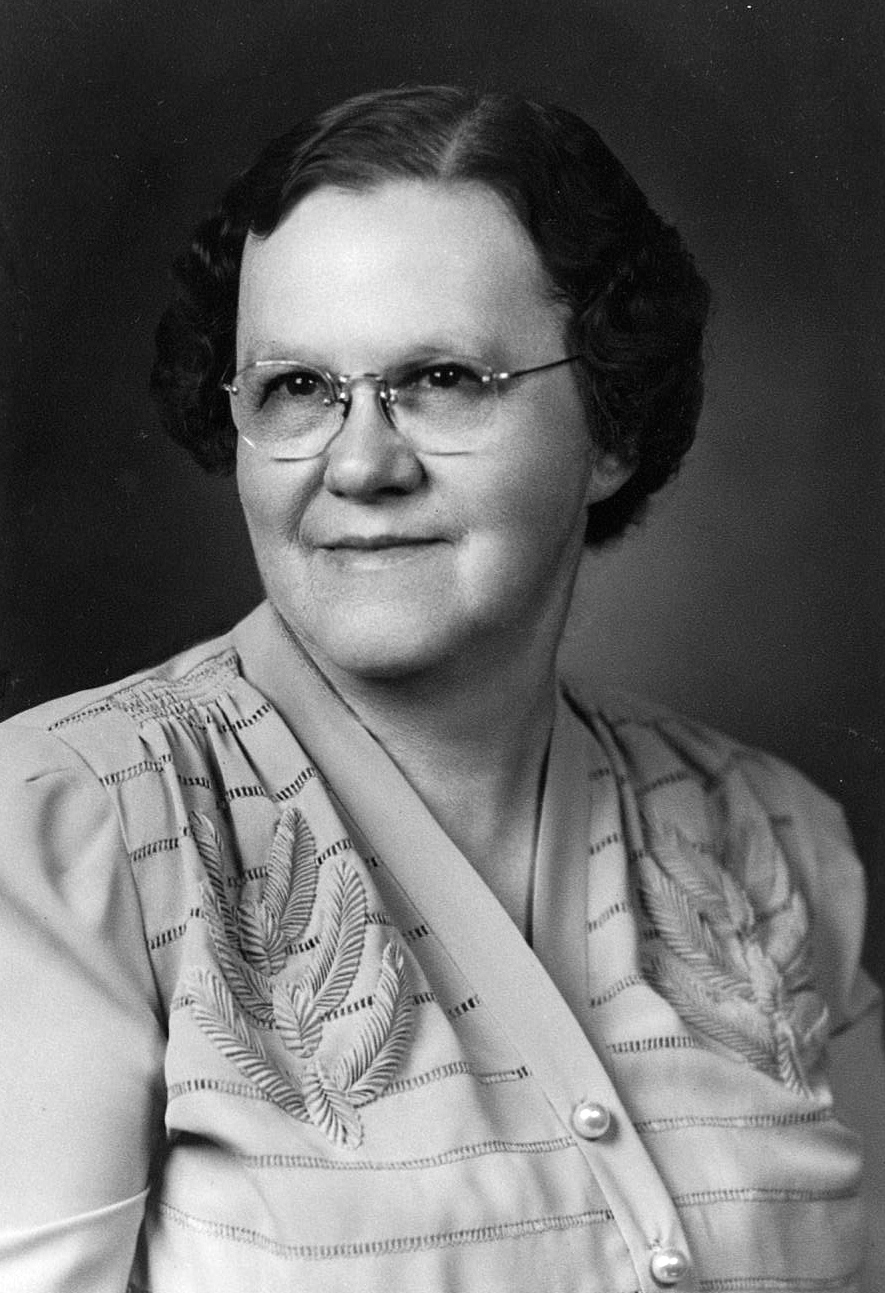
Anna K. Nesen born July 17, 1882 died January 28, 1971
Cathy remembers, I have wonderful memories of my Grandma Voels, fondly
called Gram. She was a very caring and extremely generous person. I can
remember that we always called her on her birthday. Mom would gather all
of the kids together and we would sing ‚ÄúHappy Birthday‚ÄĚ to Gram. She was
always glad to hear from us.
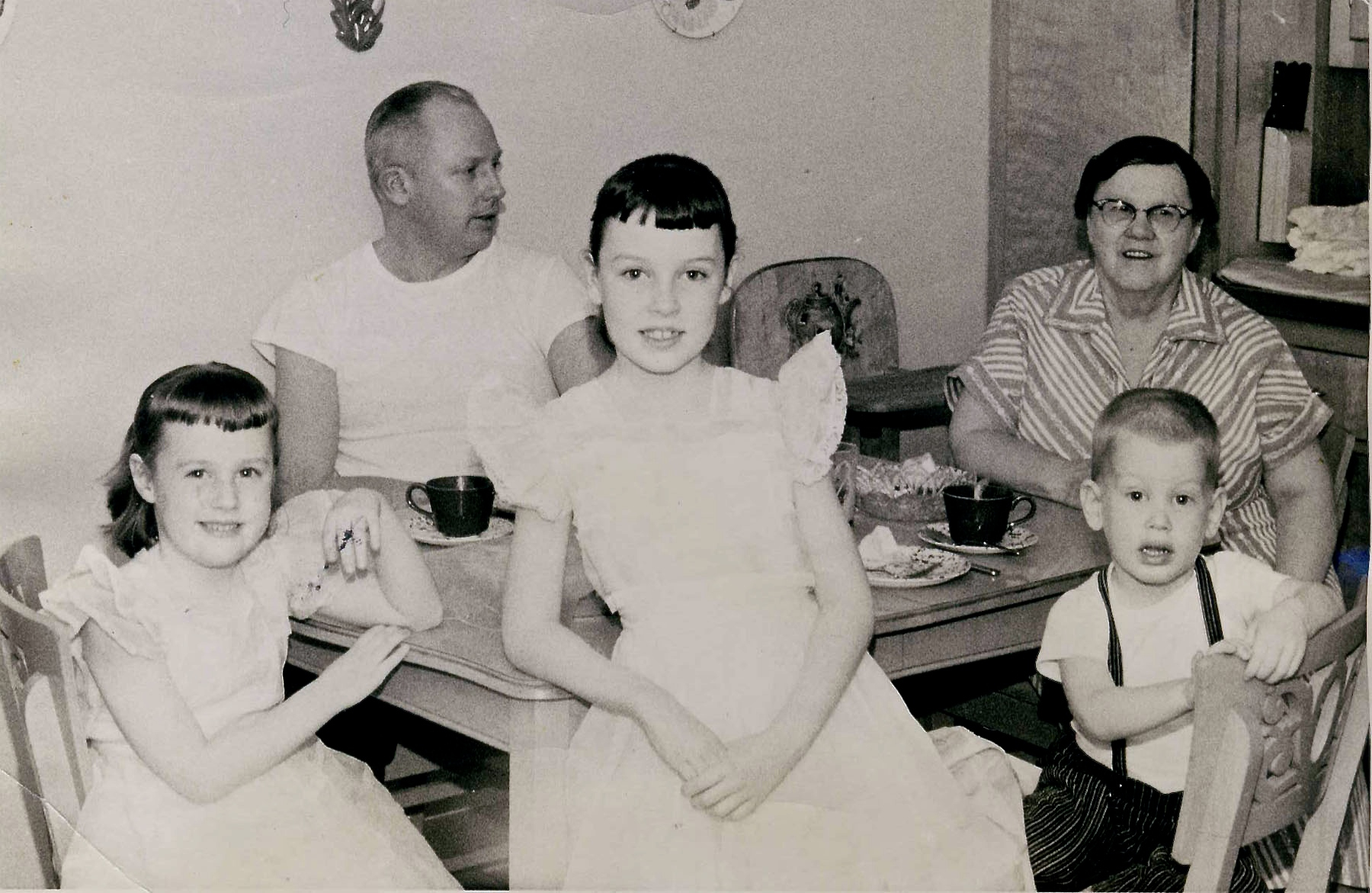
¬ Picture of Anna Voels and the Cremers
Cathy Cremer remembers going to visit Gram in her
house on Cleveland Ave. ‚ÄúShe had a ‚Äúcandy drawer‚ÄĚ that we always
liked to explore. She was a great cook. She made the best pies and
coffee cakes. She was always very concerned that we have enough to eat.
When our family moved from Dubuque to West Des Moines, I was in 3rd
grade. Mom, Dad, Bob and Dave moved, but Sue and I stayed with Gram for
2 weeks so we could finish out the school year. I remember one morning.
Sue and I were having cinnamon toast. And it was REALLY good! When we
had gone through the better part of a loaf of white bread . . .Gram
said that we needed to stop. I remember that I was shocked. Gram had
never limited our food before. She was always encouraging us to eat
MORE! In retrospect, I’m sure she probably was planning to use that
bread for lunch! She was so generous, always giving us things. She
didn’t have a lot herself, but what she had she wouldn’t hesitate
to give to her family. She always remembered our birthdays; we received
a card with money in it. When we visited her, she used to give us each
a dime and we would walk up to the little store at the top of the hill
and get a treat. She gave me two satin hosiery cases that I treasured
and a lace handkerchief that I still have. I also remember her giving
us money to ride the bus. Sue and I would get on the bus at the bottom
of the hill on Cleveland and ride the whole circuit...getting off at
the same stop! It was a fun adventure! I also remember playing her old
‚Äú78" records in the bedroom. We played ‚ÄúThe Blue Danube‚ÄĚ over and
over and over again!‚ÄĚ
Elmer and Anna Voels’ seven children
¬
Elma Ann (Born 6-29-1910)

Al Howe and Elma Voels on their wedding day
Elma was the eldest of the Voels Children. Elma was a gradate of
Immaculate Conception Academy and a member of Sacred Heart Catholic
Church and its rosary society, Catholic Daughters of the Americas and
the Dubuque County Retired Unionist. Elma was employed at Piekenbrock
Shoes and later in the office at the Interstate Power Co.¬ For many
years Elma worked at the polls on Election Day.
Elma married Al Howe on Sept 1, 1938. After she was married, she and Al
lived for a while in Fort Wayne Indiana.¬ Her mother Anna Voels would
mail her piecrust so she could impress her new husband with a great
pie.¬ As time went on she attained that skill as her oldest son Dave
remembers many a great pie she created.
Her brother Bud remembers, the first time he was on leave when he was in
the Naval Air Corp. “Elma had mother, Betty and me up to dinner one
night and Elma cooked everything I liked, crackered veal, coleslaw,
yellow beans with vinegar and bacon, she had a special meal for me.
I'll never forget it. Lucile remembers before she was married, she
went on a trip to California. She had bought a dress and when she
returned, she told her sister, Elma, wait until you see the dress I
bought in California. Elma said, I bought a new dress too. The sisters
brought out their new dresses and they were identical. Bud recounts a
story about Al Howe. Elma and Al, Ralph and Elizabeth and Betty and I
went down to a tavern one night at 6th and Locust and Al got up and sang
"Mamie". He had a few beers and he was imitating Al Jolson. Al
had a wonderful voice, he sang in the choir. Al did his full time work
during the week and on weekends he would work in Penny's in the shoe
department to provide for his large family. He was a good man and a
wonderful father.‚Ä̬

 Gathering at the Howe’s home, from left Elmer (Bud) Voels, Elma
Howe, Anna Mae Voels and Betty, Elmer’s wife
Elma’s son Dave remembered, some of his favorite
childhood memories are the special occasions when the Voels clan would
gather at our rather modest home on Windsor Ave. “We managed
to find room for everyone and the food was always plentiful as was the
fun.¬ As small children we would eat on the steps and Fr. Dave or
Uncle Bob would supply us with pennies so we could play games while
waiting for our turns to enjoy the meal. I remember some of Mom's
friends commenting on how she was able to wash and iron so many white
shirts each week as my Dad worked part time at Penny's and we boys all
took our time working at Eagles Super Market and we all were required
to wear clean white shirts each shift.¬ This was before the day
of washers and dryers. I remember the sad evening when Elmer and Betty
came to tell my Mom that Fr. Dave had drowned; this was one of the
saddest events of my teen years. My folks were so happy when they
became Grandparents.¬ They were special people and always thought
of their children first and many times we were not aware that they did
with out so they could provide for us.¬ We were so blessed to
have such wonderful folks as well as to grow up with so many Aunts,
Uncles and Cousins.¬ We had so many very special times.‚ÄĚ
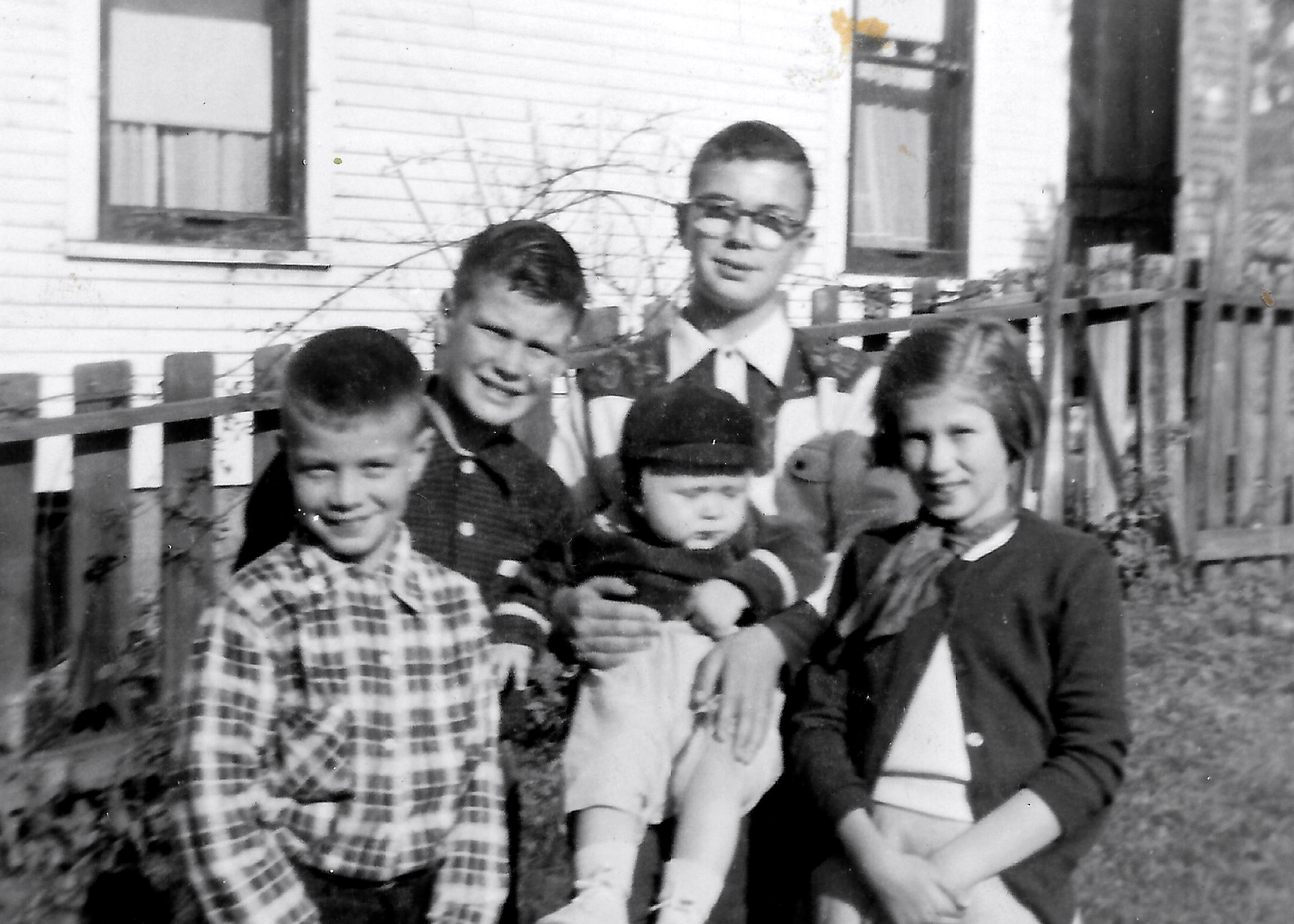
¬ The Howe children, David in back, Jim to his left, front from the
left, Tom, Mike and Mary
Elma loved her grandkids.¬ Jim Howe remembered,
when we arrived from WI, “our girls soon headed right to the
pantry & waited for Grandma to pull out the can of "Cheetos" which
she always had & knew¬ they loved.¬ ¬
She¬ usually made a casserole with "tater tots" on top because she
knew they liked that. ‚Äú¬
From a newspaper article entitled, Volunteer of the Month, we
have this about Elma. Our special volunteer this month is Elma Howe.
Elma is the mother of five children, one daughter and four sons. She
has nine grandchildren and one great-grandson. She was involved in a
great deal of volunteer work as her children were growing. Elma
worked in the library and helped with noon lunches and made altar
breads at Sacred Heart and Wahlert Schools. She also did volunteer
work at Xavier Hospital for many years. Elma took the book cart
around to the hospital patients. Most recently, the last 12 years,
Elma has volunteered to label the Senior
Circuit each month. She said the ‚Äúwork is great‚ÄĚ and
the ‚Äúladies are nice and friendly.‚ÄĚ Each month between 20 and 25
volunteers help label over 11,000 papers and the work is done in
about five hours in two mornings. Everyone has a good time visiting.
And we do take time for a cup of coffee and a cookie. Elma enjoys
crocheting in her spare time. She and a friend took a class offered
by the presentation Sisters many years ago. Elma plays 500 and
euchre often. But most of all in her spare time she loves to read.
She enjoys any type of book but historical novels are her favorite.
She receives many books as gifts. Thanks Elma for you years of
volunteer service to Project Concern/Phone-A-Friend, Inc. It is most
appreciated!
Lucile Mary¬ (Born 7-4-1911)¬
Lucile (Voels) was born in Dubuque, Iowa, on July 4,
1911.¬ She went to Sacred Heart Catholic School and made her
first communion in 1918.
¬

Lucile‚Äôs First Communion Day, June 1918.¬
Lucile remembered, “We received a very strict moral
training for which I am grateful for today.¬ The strict
discipline didn’t hurt us one bit. I like to think we are
better men and women today for having had that training.‚ÄĚ
Lucile graduated high school from Immaculate
Conception Academy in Dubuque in 1929 and worked as a bookkeeper during
the depression.¬ Mildred Kempt, a dear friend, lived on 22nd
Street.¬ The two went all through school together.¬ Janet
Moran worked with Lucile at Flynns.¬ Before she was married,
Lucile went on a trip to California with her friend, Carol Rolling
(later Weber).¬ Carol had a cousin, Sam Chapman, who graduated
that year from the University of California. Lucile’s brother,
Elmer, recalled Sam was immediately picked into the major leagues by
Connie Mac and became a well-known star.¬ When in California,
Lucile and Carol spent some time at Sam's house, and Lucile took Carol
to Aunt Mae's.¬
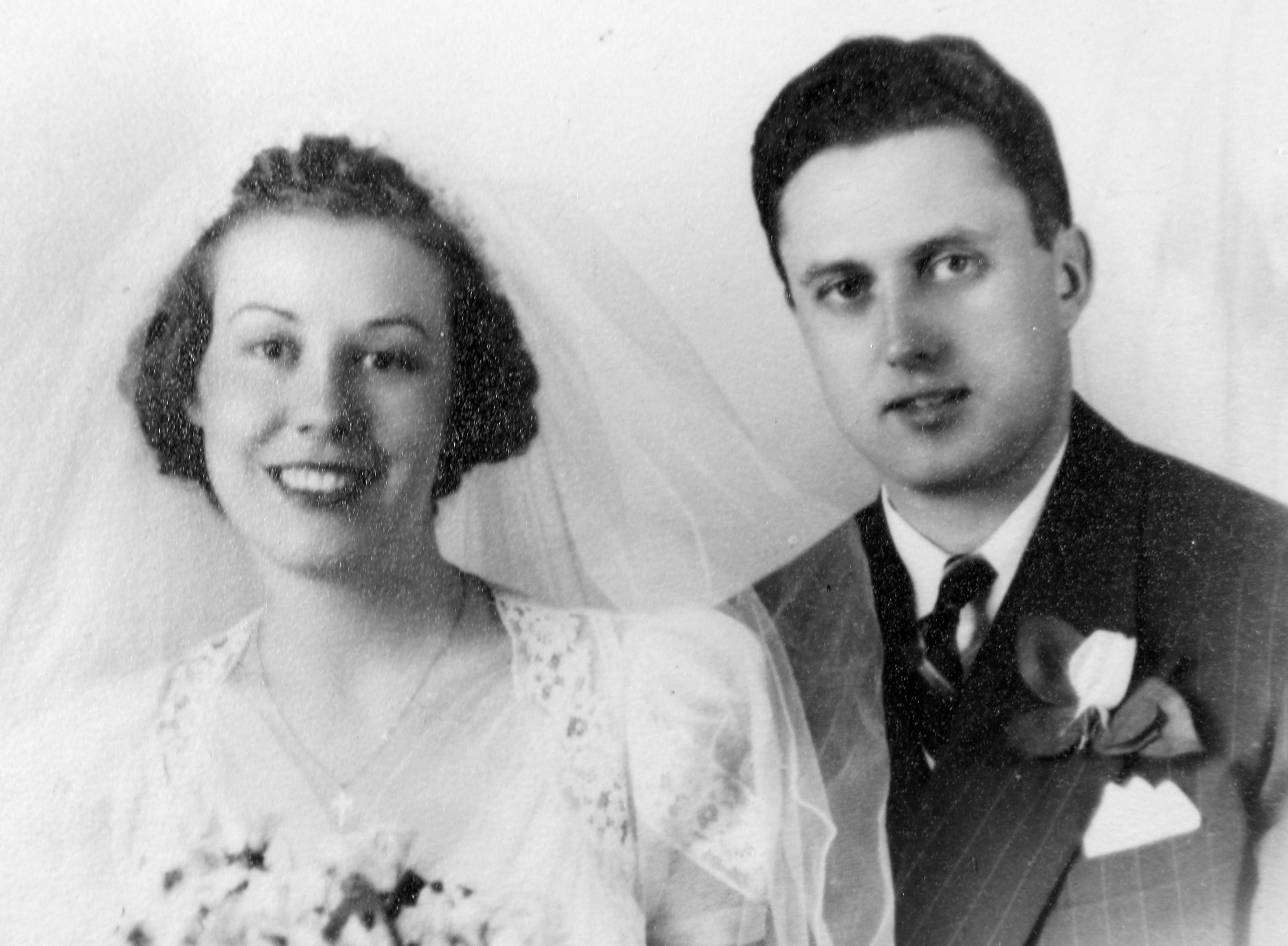
¬ Lucile Voels and Carl Kleeman married in 1940
Lucile married Carl Kleeman in Dubuque in 1940.¬ Her brother, Elmer
Voels, gave away Lucile at her wedding, as their father had passed away
earlier year.¬ The couple first lived in an apartment on Henyon St.,
near Loras College. Bud remembered, “After Carl and Lucile were
married, they had the Voels and Kleeman parents up to dinner.¬ Lucile
had baked a chicken, but she forgot to take out the innards and they
couldn't eat it.¬ That was the first time she ever cooked a
chicken.‚ÄĚ ¬
Her first son, Karl Terrance (called Terry), was born
in 1942.¬ While her husband, Carl, was in basic training, Lucile
lived with her Mother and family on Francis Street.¬ Her second
son, John, was born during that time. Lucile remembered, “It
was the war years and we always had to share rides.¬ When it was
time to deliver, we called a cab to go to the hospital.¬ Well,
the cab had to stop and pick up other passengers.¬ I remember the
last person to get in had a vacuum cleaner!¬ I thought I would
never get there!‚ÄĚ
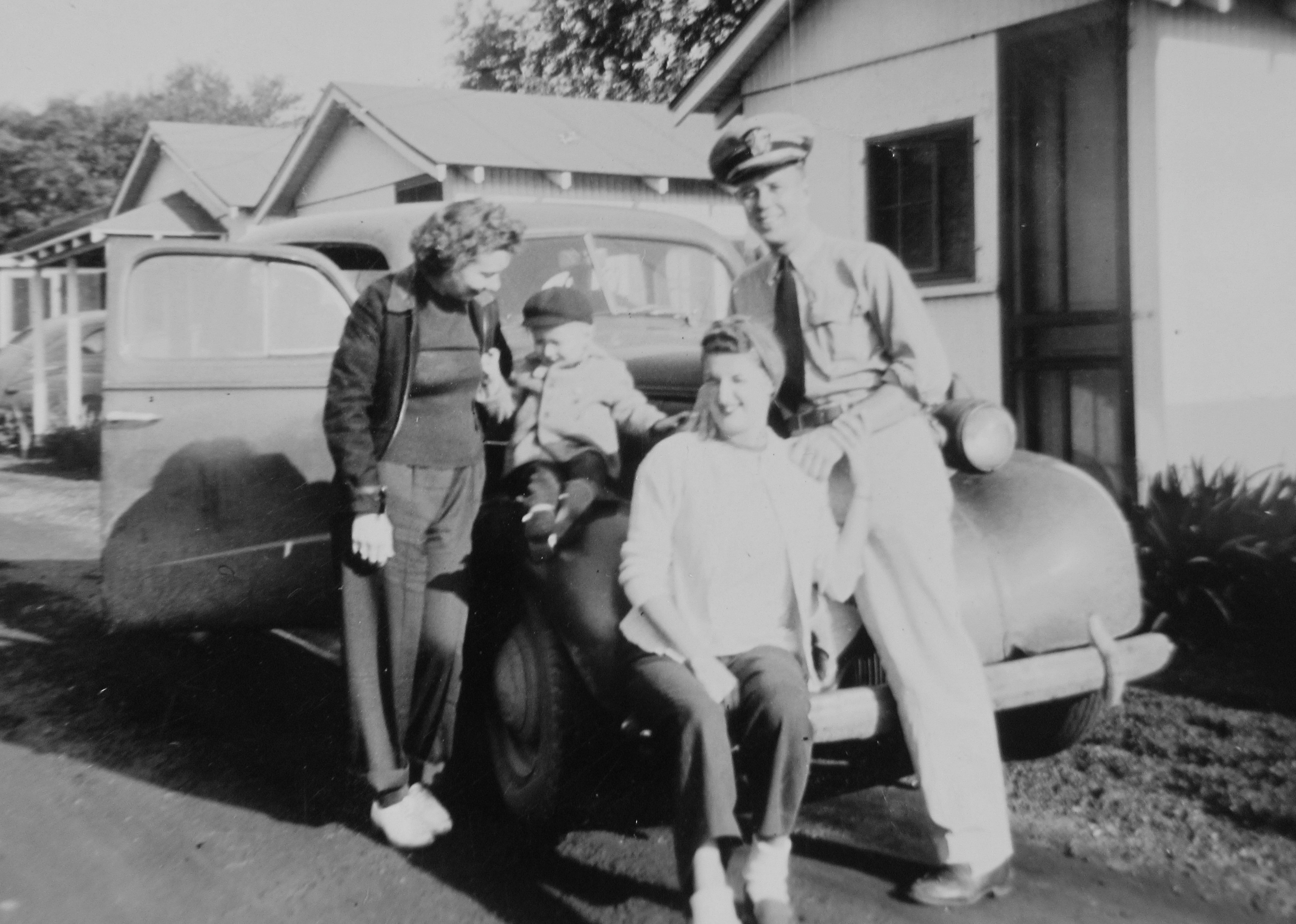
¬ Pictured in Council Bluffs, Iowa, trailer court, Betty & Bud
(front), Lucile looking at young Terry, next to a 1937
Chevrolet.
It turned out that her husband and her brother, Elmer,
were both assigned to the same base in California.¬ Lucile
decided she wanted to join her husband, so she, Carl, their two
children, her brother Elmer and his wife, Betty, all loaded in a 1937
Chevrolet and headed for California.¬ The car was loaded down
with baby things, dishes, etc.¬ It was a long trip.¬ One
story remembered is heating a baby bottle on the engine of the car when
stopped.¬ They had to use all kinds of subterfuge just to get
overnight lodging.¬ Sometimes, when going to a motel, they had to
have Terry sit down on the floor of the car where he could not be seen,
as some overnight lodging did not accept children.
When first arriving in California, the family all
shared a room in a lovely new home, Kidd’s house, in San
Lorenzo.¬ They had a big bedroom for the entire family, but most
of the time, Carl was not there.¬ They also had kitchen
privileges. There were two other couples doing the same thing and they
used to take turns cooking. ¬ This was typical around military
bases during the war.
¬

Lucile, Carl, Terry, and baby John, in front of Naval housing where
the family lived on the second floor. ¬
Carl kept a rope in the bedroom to use to lower the
children in case of a fire. Eventually they moved back to Dubuque, then
Davenport (where Lucile had their third child, Jim), and then Des
Moines.¬ At this time, Carl worked for International Harvester
Company. Her husband’s job eventually took the family all over
the world and Lucile lived in the Philippine Islands, France, and South
Africa, and finally in Chicago.¬ Lucile and her husband retired
to Sunriver, Oregon in 1973.¬ Throughout her life, she enjoyed
reading, golf, travel and caring for her family.
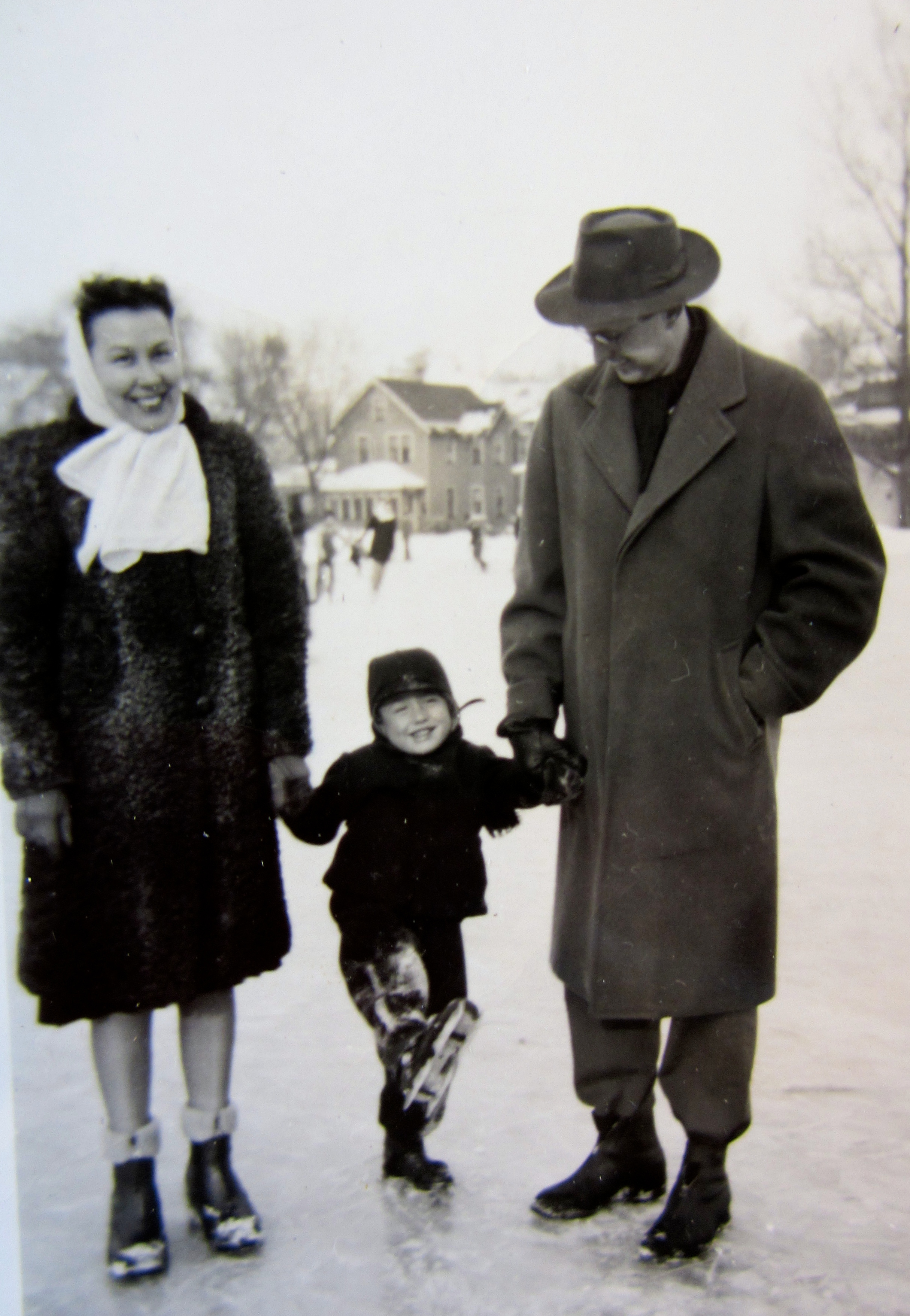
¬ Carl & Lucile ice skating with young Terry in Dubuque
Cathy Cremer remembers, “I have fond memories of your Mom. She and my
Mom were always close. Your Mom was my godmother and she sent me
wonderful gifts from the exotic places where you lived. I especially
remember a pink flowered dress with matching pink coat. I was in about
6th
grade and I was so thrilled to get it! I also remember visiting you in
Milwaukee and you had this very energetic dog.¬ You mom threw hot dogs
down the basement steps. Of course the dog went bounding down to get the
treat and your Mom quickly closed the basement door. Makes me laugh
today thinking about it. I don’t think our parents had pets when they
were growing up and weren‚Äôt too fond of dogs.‚ÄĚ
After her husband passed away, Lucile moved to Crystal
Terrace Retirement Home in Klamath Falls, Oregon, to be close to her
grandchildren, Kellianne and Scott.¬ She was an active bridge
player and enjoyed her friends.¬ She was a member of Sacred Heart
Catholic Church in Klamath Falls. She was a wonderful mother and an
adventurer, having met the challenges of raising her family in foreign
countries.¬ She especially loved Paris.¬
¬
Lucile and Carl’s sons went on with careers in the
medical field.¬ Karl Kleeman, PhD (Clinical Microbiology),
serving as a hospital laboratory director, and wife Edwina Kleeman
(Medical Technologist, MS in microbiology.¬ John Kleeman, MD
(Family Practice) and his wife, Gayle, a schoolteacher, and their two
children, Kellianne and Scott.¬ James Kleeman, PhD
(Pharmacology), and his wife Lee, a schoolteacher and accomplished
artist. ¬
Catherine (Broell) Welu (adopted)
Catherine married Tony Welu, who owned and ran a
bookbindery, Welu Printing, on Central Avenue.¬ The business
still exists across the street from the original shop and is now a
thriving printing business, run by Tony and Catherine's son David, and
now, run by David’s daughter (third-generation). When Tony was
courting Catherine, he used to come to the house on 22nd Street.¬
He and the family would sit at the kitchen table, as he would sew
books.¬ He would work night after night; the man had a lot of
ambition. His son is the same way.
¬ ¬
Tony and Catherine were married at Sacred Heart Church
and the reception was in the house on 22nd Street.¬ A lady who
ran a tearoom on Bradley Street catered it.¬ It was the first
time Bud Voels ever saw a keg of beer.¬ He did not have any, as
he was too young.¬ He remembers Johnny, Leo, Mona and Florence
Welu at the reception. Bud and Betty were close to Tony and
Catherine.¬ In fact, the day Bud broke his jaw; they were at Tony
and Catherine’s on Thanksgiving Day for dinner. The whole
family used to go out the Welu's cottage on Riverside, overlooking the
Mississippi, for outings.¬ Bud remembered one cold winter day,
“They cleared the snow off the ice on the river and parked the cars
with the headlights shining on the "rink" that evening and had a
skating party.‚Ä̬ The Welu children included Rickey, Tommy,
David, Janet, and Joan.¬
Bud recalled another story. “Dave
Voels was in school. “He was visiting Tony in his shop on
Central on his way home from work one day.¬ Dick Berg was a
printer about 5-6 doors up the street.¬ Tony said, ‚ÄėDave, Dick
borrowed my paper stretcher, would you go up and get it?’ Dave
said ‚ÄėSure,‚Äô and went up to Berg‚Äôs place.¬ Dick went down
into the basement and found a big piece of iron and wrapped it all up
in paper.¬ Young Dave could hardly lift it.‚Ä̬ Tony used
to love to tell that story. “ Betty Voels pictures Tony with a cigar
in his mouth. “Tony was
a real character. He was the Red Dean of Riverside.‚ÄĚ
Bud remembered a 4th of July picnic they had out at
Riverside with most of the Voels family “We played cards. It
was a good time.¬ Everyone always had such a good time at the
Welus. Ann Cremer tells the story of being out at Riverside, sleeping
overnight. “The
house was so close to the railroad that very time a freight train came
by, it felt like it was going through the cottage.‚Ä̬ Bud bought
a beagle pup, but the pup was a real whiner, so Bud couldn't keep him
in the city.¬ Well, Tony and Bud used to hunt together, so Bud
took the dog out to Tony’s. The dog never did develop into a
hunter so he was named ‚Äėgyp‚Äô.¬ Bud felt gypped.‚Ä̬
¬
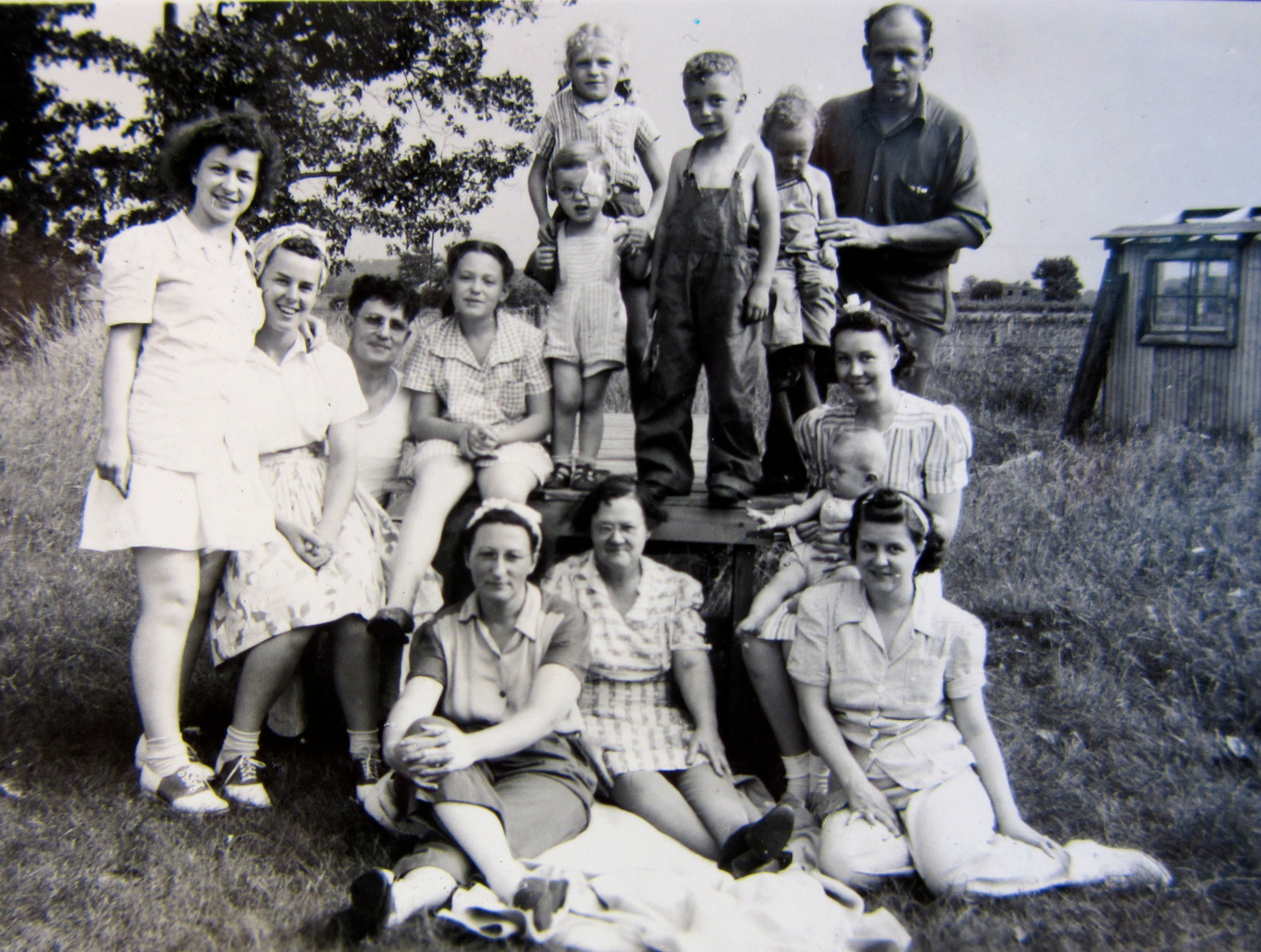
Family picture at Tony Welu’s cottage at Riverside on the
Mississippi, outside of Dubuque.¬ Sitting on the ground,
left-to-right: Catherine Welu, Anna Voels, and Elma Howe.¬ Lucile
Kleeman holding Ricky, sitting behind Elma.¬ Standing/sitting from
left-to-right: Mary Jean Schramm, Anna Mae Cremer, Al Howe, Joan
Welu, David Howe with patch on eye (an eye that turned inward and
had corrected as a child), and the Welu children: Janet, Tom, and
David.¬ Standing far right: Tony Welu.
Elmer John (Bud) (Born 3-3-1919)
When Uncle Henry would visit, he would always say, “Bud, have you hopped
any freights today?‚ÄĚ Bud used to hop freight every once in awhile and
ride for a block or two. One day when Bud was up to his old tricks, a
man slipped under a train and had both legs cut off. Bud still remembers
the coroner walking down the track carrying those two legs with the
shoes still on. Bud recalls the time he broke a windshield. It cost $15
to replace. It was two-piece and was tilted up. His dad had to pay for
it. Bud remembers a party at Sacred Heart, we drank beer and had a good
time and came home around midnight. Bud went right to bed. Bud used to
play cards at the King of Clubs. When he would come home, Gram would
call, "Is that you Bud?" "What time is it?" Bud
would respond, "Plenty after 10" and try to make it sound like
20 after ten. When David Howe was living at the house on Francis Street,
every time Bud would be sneaking into the house after midnight, “that
kid‚ÄĚ would wake up and start screaming. For years Bud called him ‚Äúholler
cat". In high school, Bud would wait on tables at Melody Mill. Some
nights he would get 10-12 dollars in tips. He would go home and give it
to his mother and she would give him a little spending money out of it.
Bud's first full time job was at Rushes in the stockroom for $9.65 a
week. There were 10 birdcages on the main floor at Rosheks. Every
Friday, Mr. Roshek would come up to Bud with a hand full of quarters and
ask, "Can you take care of my birds for me. So every Sunday, Bud
would go down and knock on the door and the guard would let him in. For
a half hours work cleaning the birdcages, he got 10 quarters directly
from the boss. From there, Bud went to A. Y. McDonalds in the factory
and got $24 a week. That was double money. He worked in the plating
department. They would first mold the plumbing fixtures, then polish
them, then they would go to the plating department where they were
placed in racks, put in the plating solution, and electroplated with
aluminum. Bud worked there for about 5 years, then he went into the
service for 3 years, 3 months. Bud had ROTC for two years in high school
with that big Springfield rifle and when it came time, he did not want
to have any more of that so he enlisted in the Navy Air Corp.
¬

¬ Bud Voels in his Navy uniform
He had never been in an airplane. He went to Minneapolis for a physical,
a written test, and was accepted and sworn in on the 23 day of September
of 1942. I came home from work on New Years Eve and his letter was
there, to report for a physical the day after new years back in
Minneapolis. The physical consisted of a doctor asking each person if
they had contacted any social disease since they were there in
September. "No Sir" and he directed them to a line and they
left that night for the University of Washington at Seattle. There were
about 200 on the train. Bud went to ground school for 3 weeks, and a
call came out for navigators. It would have taken another year and a
half to become a pilot, so 6 of them decided to go to navigation school
and they sent them to Hollywood, Florida, just north of Miami. Lucile
remembers when Bud was traveling from Washington State where he had
begun his training to his new station in Florida. He called from St.
Paul and asked the family to meet his train in East Dubuque; he wanted
to drop off his heavy clothes, as he would not need them in Florida. The
family had to wait a couple of hours in the middle of the night for the
troop train. When the train finally came, it just slowed down going
through the East Dubuque station, he stood on the steps and threw off
the clothes, yelled a greeting and away he went. Anna Mae has a story
about Bud. Mother was feeling so badly when he left for the service. It
was difficult for every family when the eldest son left to go off to
war. Mom was really grim about it, then, the first word we got from him
was a postcard with a picture of this big resort, Hollywood Beach Hotel
in Hollywood, Florida. The Navy had taken it over, Bud said, "Not
bad duty, I am fine" and everyone said to Anna, stop worrying, it
looks like he is having a pretty good time.¬
¬
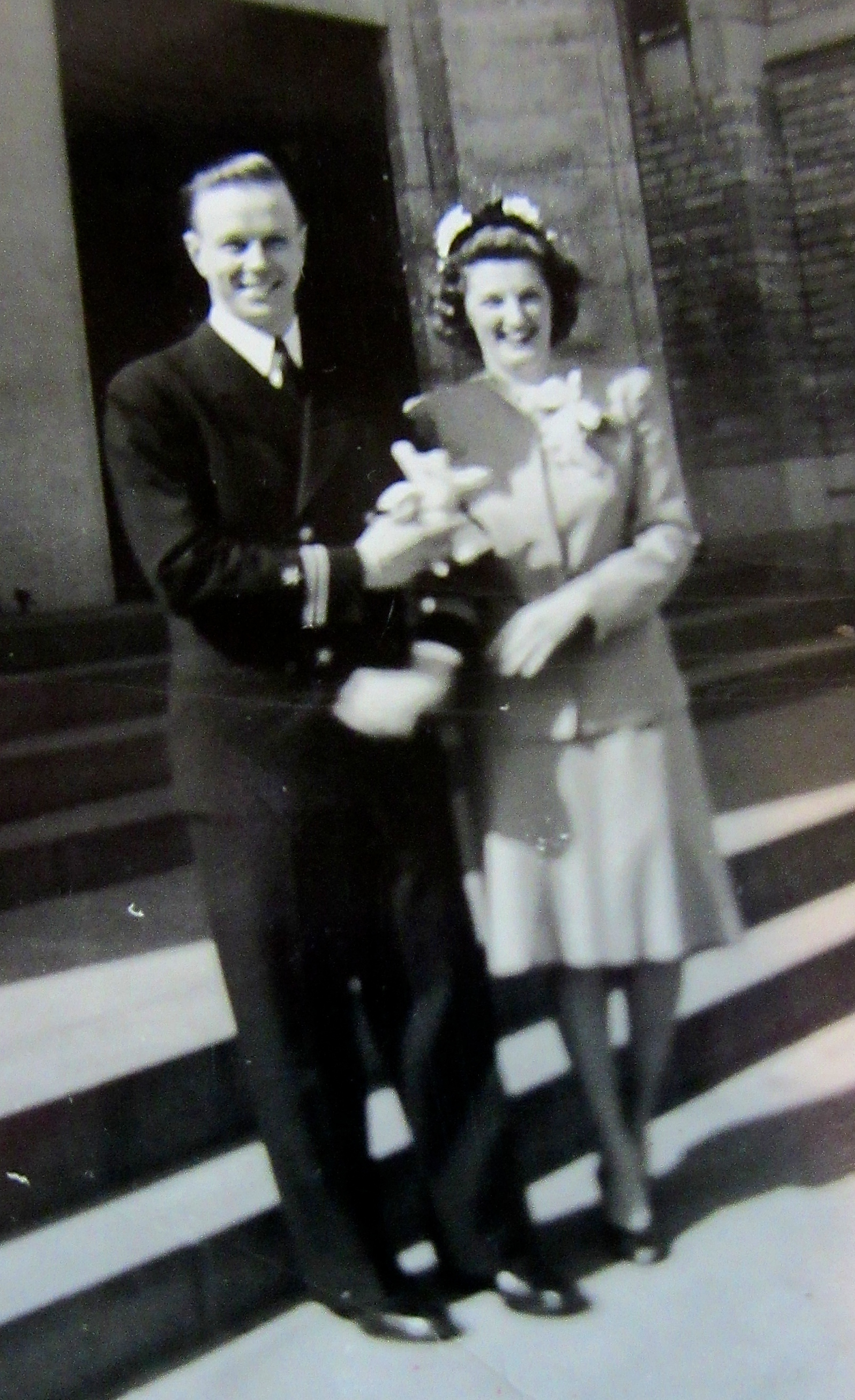
Elmer (Bud) Voels and Elisabeth (Betty)¬ married in New York
City¬
Bud married Betty. His brother, Dave Voels was not ordained at the time
but he was able to come to Bud and Betty's wedding in New York. Bud
had rented an apartment above a Jewish couple. Their 11-year-old
daughter also lived upstairs. The evening when Dave came to New York he
stayed in the apartment. The landlord brought his daughter downstairs
that night. Another memory, the Jewish couple had a sader meal with
gefilte fish, which they shared with Bud and Betty. This was a strange
and not particularly appetizing dish for the young mid-western
Catholics, so they wrapped it up and put it in the refrigerator. After a
few days, they decided they needed to dispose of it. They did not want
to put it in the garbage at the apartment where the kind Jewish couple
might find it, so they wrapped it up and took a bus to the subway and
when they came to a station with a trash bin, he tossed it in. Bob
Cremer remembers that Bud had tough duty, the submarine patrol between
Miami and Havana, Cuba. Bud was reassigned to Oakland, California and he
and Betty helped Lucile Voels and her husband Carl and their two
children, Terry and John drive to California.
After Bud and Betty were married for about 6 months and living in
Oakland, CA, they went to San Francisco to see a show, decided to stay
overnight and went to a hotel. Bud was in uniform. Betty sat in the
lobby while Bud went up to the desk and registered. The clerk looked him
over and said "no luggage"? Bud said no. He handed the key to
the bellhop and said "No luggage". They got on the elevator
and the bellhop nudges the elevator operator, "no luggage".
After they checked in and got settled. Bud went down to the lobby and
bought two toothbrushes and toothpaste. The next morning Bud went to the
barber in the hotel and got shaved. Anna Mae remembers when Bud was
getting out of the service. A big box arrived with his uniforms. He had
written Mother and said he was sending a box with his uniforms and a few
trinkets and gifts. The family opened it; they couldn't wait until
he got home. Every sleeve was stuffed with liquor. Bud remembers one
evening when Lucile and Carl were living on Jackson Street and they were
up there to play bridge. It was the second time Betty ever played
bridge.
¬
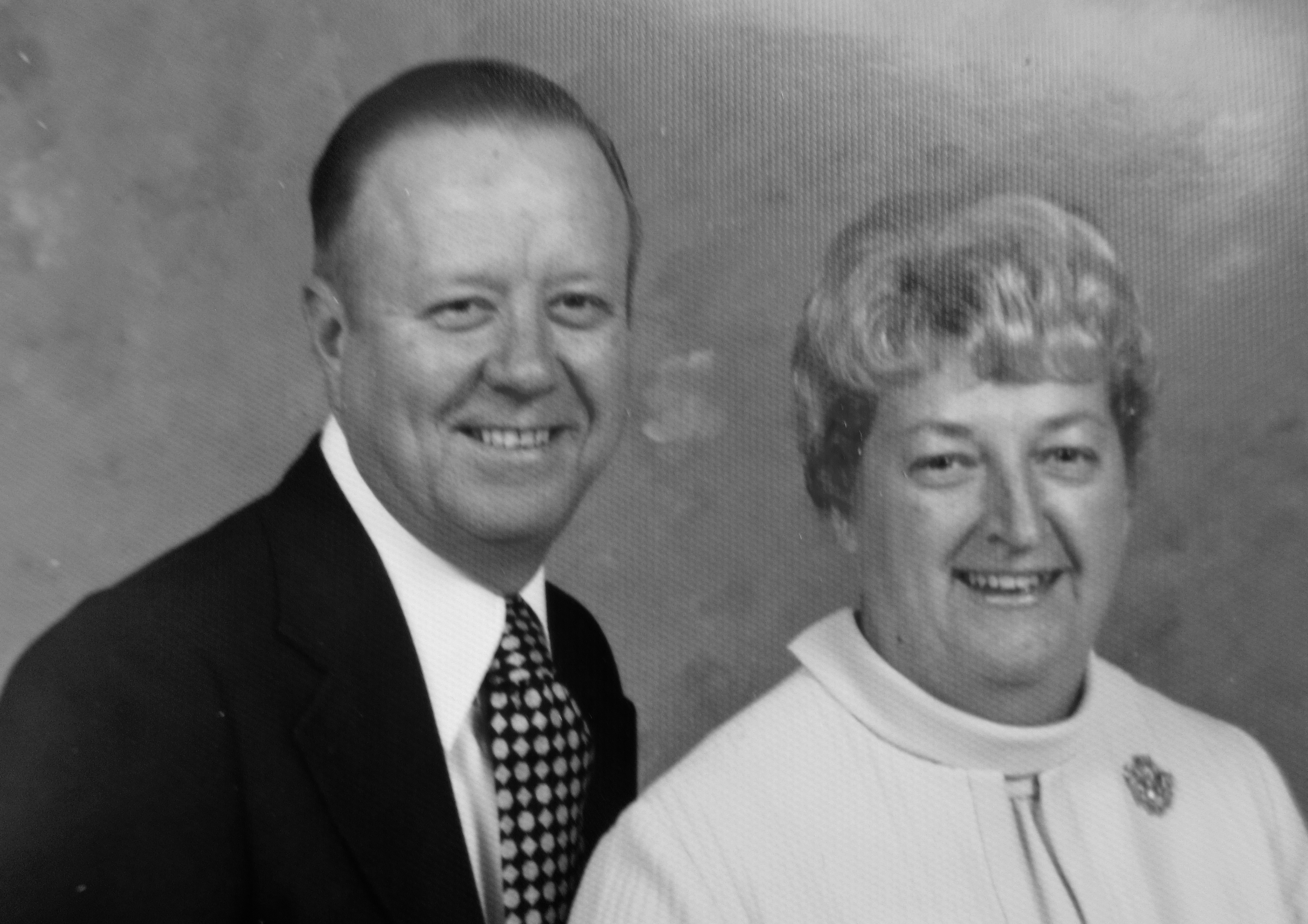
Bud was the dummy and he got up and said "Oh my God". Betty
put the cards down and said it was either the cards or the marriage.
They did not play bridge for the next twenty-five years. One Christmas
Bud was jacking up the car to put chains on and the jack handle popped
up and hit him and broke his jaw. He had to have his jaw wired shut and
was eating everything through a straw. After the service he took 5 days
off and went back to work at McDonalds. He didn't want to work in
the factory so he started looking and found a job at Rainbow Oil
Company. He worked as a salesman for 38 years, traveling within 100
miles of Dubuque.
David Robert (Born Jul-5-1922)
¬ ¬
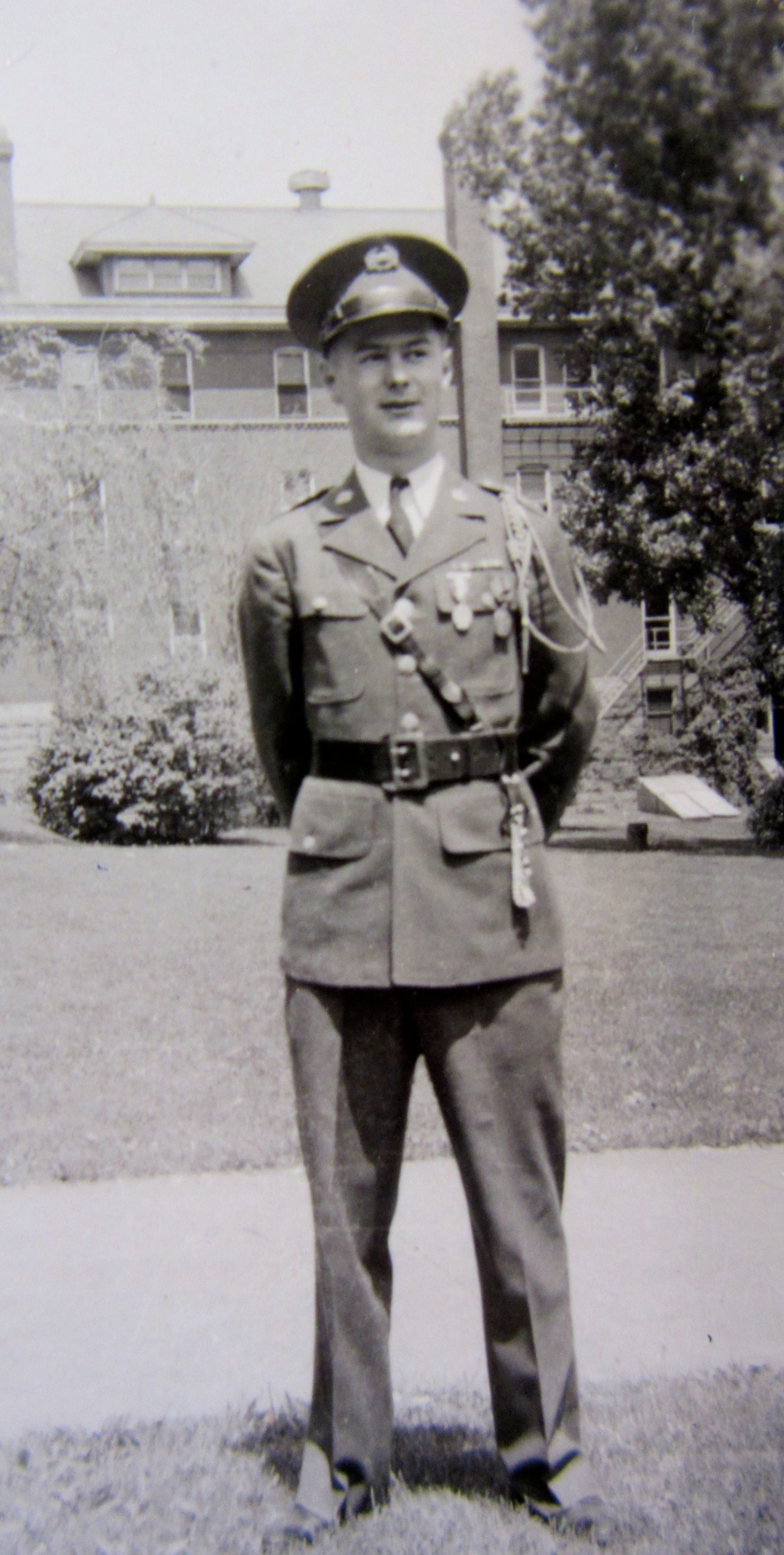
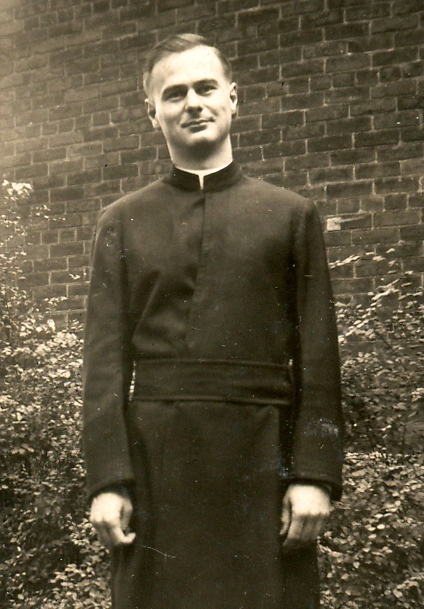
David Voels at this graduation from Loras, the students who were in
the ROTC and wore a uniform.
Father David Voels was a graduate of Loras Academy and
Loras College, Dubuque, Iowa and Sulpician Seminary at Catholic
University, Washington D.C.¬ He was ordained May 31, 1947 in
Dubuque and served as an assistant priest for eight years at St.
Francis Xavier Basilica, Dyersville, Iowa.¬ Father David came to
Ames, Iowa, in July 1955, where he served as assistant pastor at St.
Thomas Aquinas Church.¬ Fr. Dave was a
speaker and pulpit orator of outstanding ability: a writer and author of
the Marian Pamphlet Prayer Book.¬ ¬ ¬
¬

Father David Voels
Father Voels was appointed June 1, 1960 as director of
the New American Martyrs' Retreat House in Cedar Falls.¬ The new
retreat house was scheduled to be opened to the public for the first
time at an open house September 4, 1960.¬ Father Voels had been
living temporarily at St. Mary's Rectory in Waterloo while awaiting
completion of the retreat house.¬ Established in 1960, under the
direction of the late Archbishop Leo Binz, the Retreat House was
officially dedicated to the North American Martyrs, Saints Isaac
Jogues, Rene Goupil, and John Lalande.¬ The Retreat House
location is reminiscent of the time in which these early martyrs trod
the land of North America. The location is in the beautiful Cedar River
Valley, surrounded by 75 acres of trees and uninhabited beauty,
creating an atmosphere of peace and serenity, which is an ideal setting
for rejuvenation of the spirit.
Father David drowned in a boating accident on August
26, 1960, at the age of 38.¬ His loss was devastating for his
mother and all of his family.¬ He was fishing with Fr. Robert
Vogl, his close friend, and Fr. Vogl’s father, in a boat in the area
of Ely, Minnesota.¬ The story is that they all had bites and no
one was minding the boat. It was cold and they were wearing heavy
clothing.¬ Just before the boat was swept under a waterfall, Fr.
Vogl noticed and jumped to the rocks but was unable to secure the
boat.¬ He watched helplessly as his father and best friend
drowned.¬ Surviving the accident, Father Bob became a life-long
member of the Voels family, celebrating the family’s happy occasions
and sharing everyone’s sorrows.  Fr. Robert Vogl died on
December 27, 2014, at Stone Hill Care Center in Dubuque, IA.¬
Burial was in Cedar Rapids, IA., in Mount Calvary Cemetery. Cathy
Cremer remembers, “I think your family was visiting in Dubuque when
Father David died. (Do your remember this?¬ I hope I have it
right.) The phone rang and suddenly both our Moms burst into tears and
went into the bedroom. They didn’t tell Gram right away.  Gram
said, ‚ÄúWhat‚Äôs wrong, what‚Äôs wrong. Is it my David?‚ÄĚ She knew.
And then they didn’t find him for a while. We were at mass at St.
Columbkille’s Church. The pastor got a call and came running down the
aisle to tell Gram that they had found his body. I remember being so
sad as I kept hoping he survived and was somewhere in the woods. He was
a really good person and everyone loved him.‚ÄĚ
Mary Ann Howe remembers, “Father Dave liked to take pictures,
especially of family. When he would come to our home on Windsor Avenue,
he would ask us, one by one, to sit across from him at the kitchen
table, and he would take our pictures.‚ÄĚ Jim Howe remembers,
“Father
Dave would call Mom and tell her he was bringing steaks (1" or more
thick)¬ for the family, and she would call her brothers and
sisters and their families would come to our house for a pitch-in
dinner.¬ ¬ We had a family picnic at Eagle Point Park, weeks
before he died.¬ I had just bought my first car, a
52¬ Chevy, and¬ he asked me to show it to him.¬ He then
asked if he could drive it, and he drove my old beater around the
park.¬ I always admired his¬ interest in us.¬ The day
he died I was working at Eagles Super Market until 9:00 pm.¬ I
got a message to go right home after work.¬ All the relatives'
cars were at the house.¬ I walked in to see Granny and all with
tears in their eyes.¬ I will always remember our ride around the
park.‚ÄĚ
Mary Jeanne Voels¬ (Born 7-1-1923)
Mary Jeanne was born at 301 East 22nd St., Dubuque,
Iowa on July 1, 1923. A cute story about Mary Jeanne that her mother
used to tell: “When Jeannie was four years old she invited the
neighbor girls to her birthday party and then came home and told
Mom. Mom said you can’t do that today, it’s Monday and I am
doing the laundry, so Jeannie went back and told the kids they
couldn‚Äôt come.¬ When she came home again Mom said, ‚ÄėI guess
you can have the party as long as you have invited the girls.¬ So
Jeannie hurried back and told the kids that they could come.¬
Busy Mom still took time to make a birthday cake.‚ÄĚ ¬
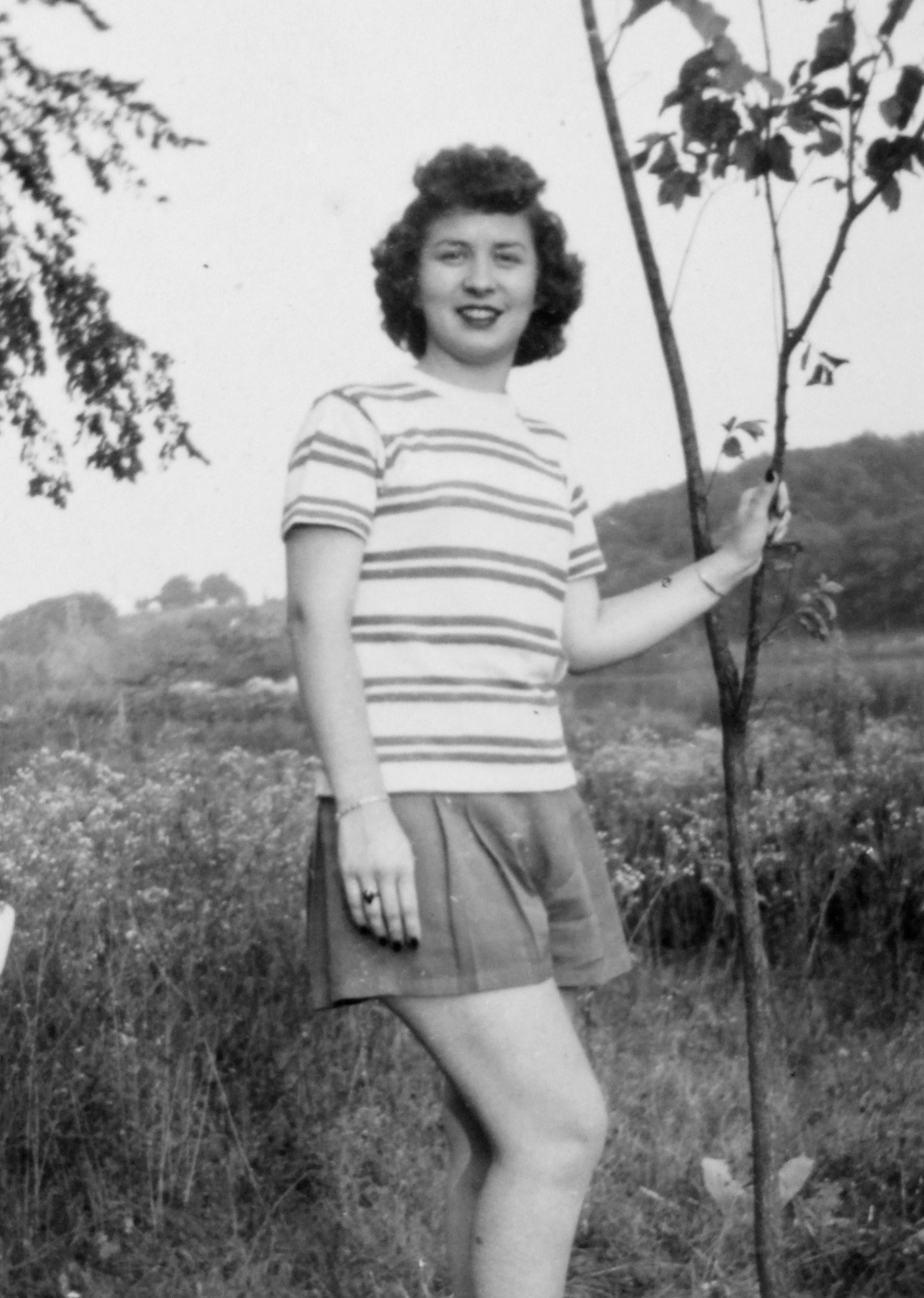
¬ Mary Jeanne at Mawuaketa in 1945
“For Mary Jeanne's First Communion, Dad bought a
gallon of maple nut ice cream in a big blue bucket.¬ For a long
time she wondered why she never saw any maple nuts.‚ÄĚ She attended
Sacred Heart School and the Immaculate Conception Academy, where she
won a national editorial writing contest and was the editor of the
school paper in her senior year.¬ Jeanne had a scholarship to go
to Marquette University for Journalism, but her father died and she and
her sisters had to get jobs to help support their mother.¬ She
worked at the Dubuque Fire and Marine Insurance Company after she
graduated from high school and then worked at the Key City Gas Company
until she was married.
¬
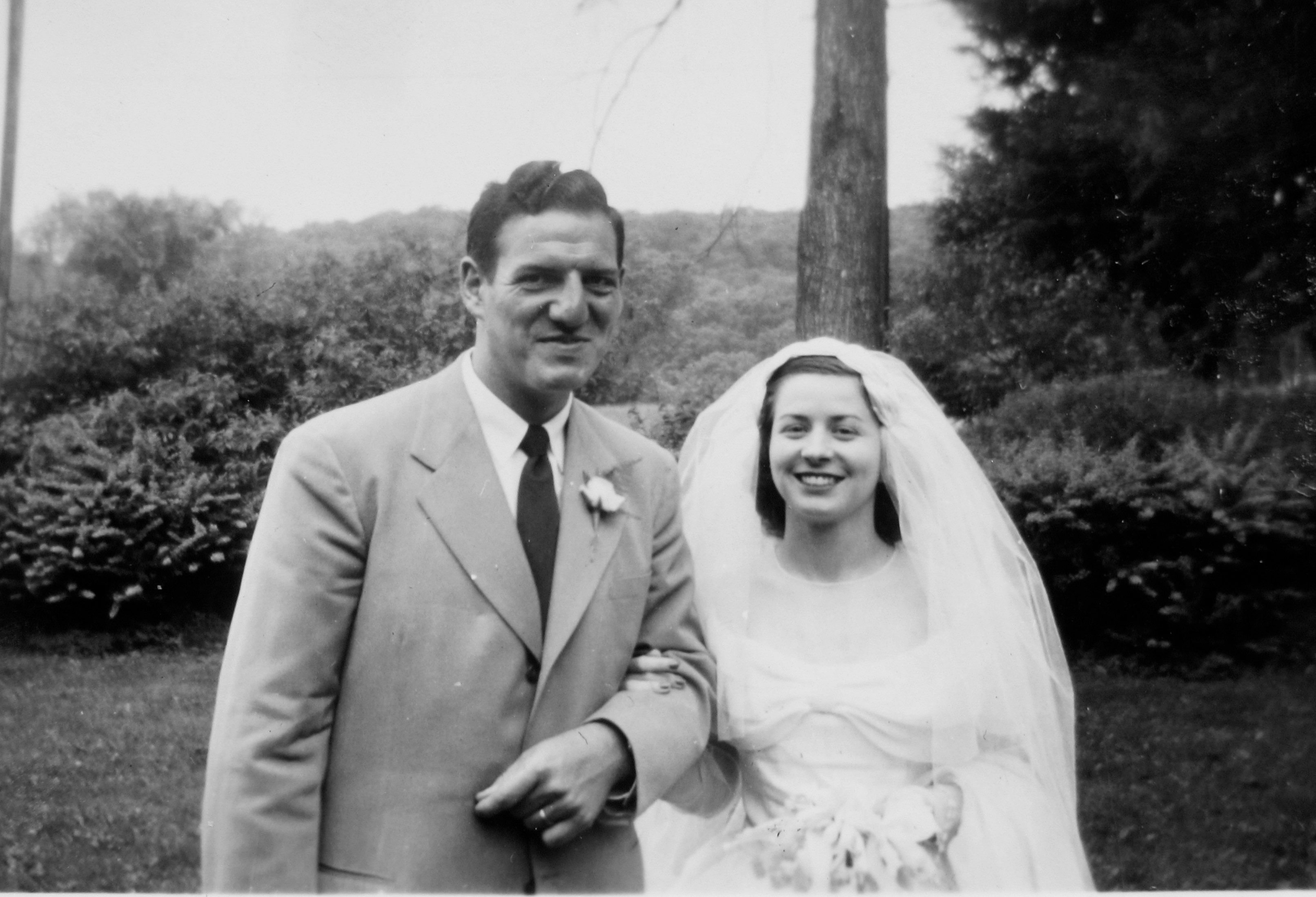
Mary Jeanne Voels and Paul Schramm on
their wedding day
On June 12, 1948, Mary Jeanne married Paul
Schramm.¬ Paul was from Freeport, IL and a graduate of Loras
College in Dubuque, Iowa.¬ They met while Paul attended Loras
College after having served in the Philippines during WWII.¬
Shortly after Paul’s graduation, Mary Jeanne and Paul were married on
June 12, 1948.¬ They moved to Blairstown, Iowa.¬ After two
years they moved to Des Moines, where Paul taught and coached at¬
Dowling High School. In 1955 they moved to Dyersville,
IA.¬ Paul taught and coached at Xavier High School and started
football there.¬ They outgrew their home on West Victoria and
moved to a home at 921 3rd St. SW.¬ After Xavier High School
closed, Paul served as Director of Audio Visual Education for the
Western Dubuque School District until his retirement.¬ All of
Mary Jeanne’s children speak about how wonderful life was with
parents who lived the example of what married life and having children
was all about.
Paul passed away at the age of 80 years old and
Jeannie at 90.¬ They had a wonderful life together. Mary Jeanne
loved her husband, her children, her many friends, and created a home
that enriched a wonderful family life.¬ ¬
Mark Joseph was born on June 6, 1949, in Cedar Rapids Iowa and
was ordained a Divine Word Missionary Priest in 1975.¬
Paul Edward was born on July 10, 1952 in Des Moines, Iowa. He
married Suzanne Wessels on August 16, 1975.¬ They have three children,
Joseph, Timothy, and Andrew.¬
Mary Suzanne was born on June 10, 1955 in Des Moines, lowa.¬ She
married George Patrick Guinane on May 21, 1977. ¬
Roger John
was born on January 9, 1958 in Dubuque, Iowa.¬ He married Deborah
Reiter on April 21, 1990.¬ They have two children, Ryan and
Kalynn.
David Gerard was born on April 25, 1960 in Dubuque, Iowa.¬ He
married Debra Stuart on February 7, 1998.¬ They have one son, Chase.
Michael Alan was born on December 10, 1961.
Patty Ann was born on January 24, 1963.¬ She married Kenneth
Berzinski on August 9, 2003.¬ They have one daughter, Brittany.¬
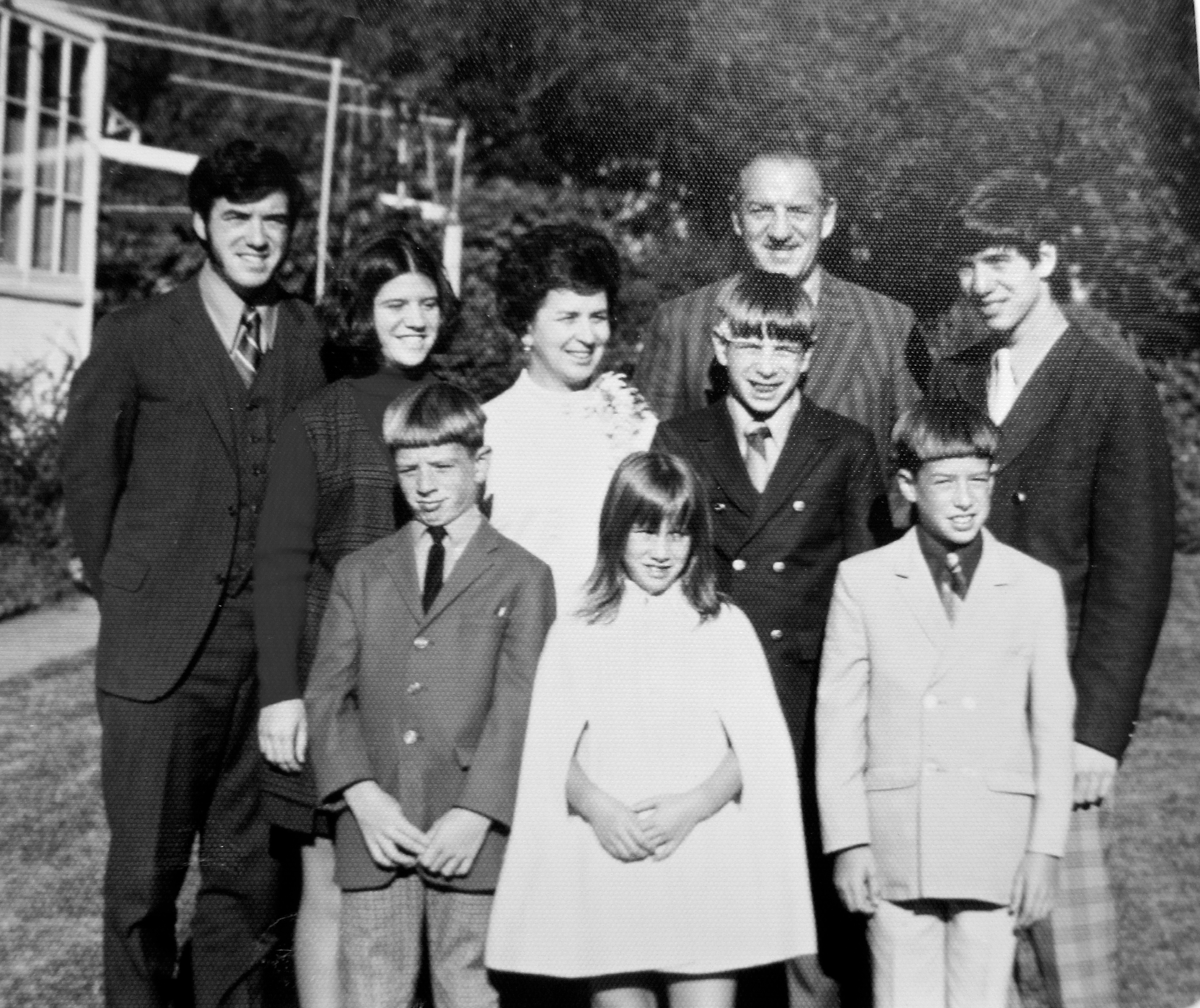
¬ Schramm family ‚Äď Front row left to right: Michael, Patty, David
Second row left to right: Mark, Mary, Mary Jeanne, Roger, Paul
Paul Sr. in the back.
“We, Paul and Jeannie’s children, remember going
on car rides on summer evenings with the family in the station wagon,
with dad smoking a cigar and listening to the "Sunday evening Pops
Concert" on WMT AM radio or a Cubs game on WGN. ¬ We would always
stop and get ice cream cones at the drive-in before going home. We
remember going on family summer vacations with the family in Wisconsin.
¬ Most times other members of the Voels family would join us.
¬ Elma & Al, Betty Voels, Jim & Fran and their kids would
meet us and we'd spend a week in a cabin on a lake. ¬ Lots of fun!
We remember the whole family driving into Dubuque at the Holidays going
to Elma and Al's.¬ We ate too much, played board games, watched
football or basketball games on TV, watched the grownups play cards,
and have lots of laughing and fun. ¬ Then walk out into the cold,
get back in the car and sleep all the way back to Dyersville. We
remember meeting the families at Eagle Point Park in Dubuque in the
summertime for picnics.¬ Everyone would make it there and, as
usual, there would be plenty of food and fun. We remember¬ Dad and
Paul Cremer smoking cigars together while swimming, and going to
Grandma Voels’ little apartment/duplex and having her cook us a fried
chicken dinner with strawberry and banana jello, mashed potatoes and
cole slaw. ¬ We remember watching that big black and white TV that
had the extra speaker because she was hard of hearing, and walking up
the street to the candy shop to spoil our dinners.¬ She often
asked mom why we never ate much at her house but would at home.¬
Mom would say it’s because Grandma filled us up with treats from the
candy shop!‚ÄĚ
Karl Kleeman remembered the wonderful family gatherings at Jeannie and
Paul’s house in Des Moines on Thanksgiving. “ I used to have a great
time getting together with our cousins.¬ I remember the upstairs
apartment at the Schramm‚Äôs. ‚Äú¬
Mark, Paul, Sue, and I (Cathy Cremer) used to play
‚Äúoffice (using the typewriter) and cards and board games.¬
Later as we got older, we played “45" records on their record
player.¬ It was always fun to get together!¬ We also
remember how much fun Jim Kleeman was!¬ He would keep us in
stitches.¬ He was full of jokes and crazy fun!¬ Dad and
Uncle Paul used to smoke cigars and watch football games.¬ To
this day, I don’t mind the smell of cigar smoke. It reminds me
of my Dad and warm family gatherings.¬ I also remember one year
when Uncle Paul stuffed the Thanksgiving Turkey so tight that it
exploded!‚ÄĚ
Robert Jerome (Born 10-6-1924)
Robert J. Voels was born October 6, 1924, at the
family home in Dubuque, Iowa, the son of Elmer and Anna (Nesen)
Voels.¬ He graduated from Sacred Heart Grade School and Loras
Academy.¬ He attended Loras College, eventually leaving college
to help support¬
¬ his widowed Mother.¬
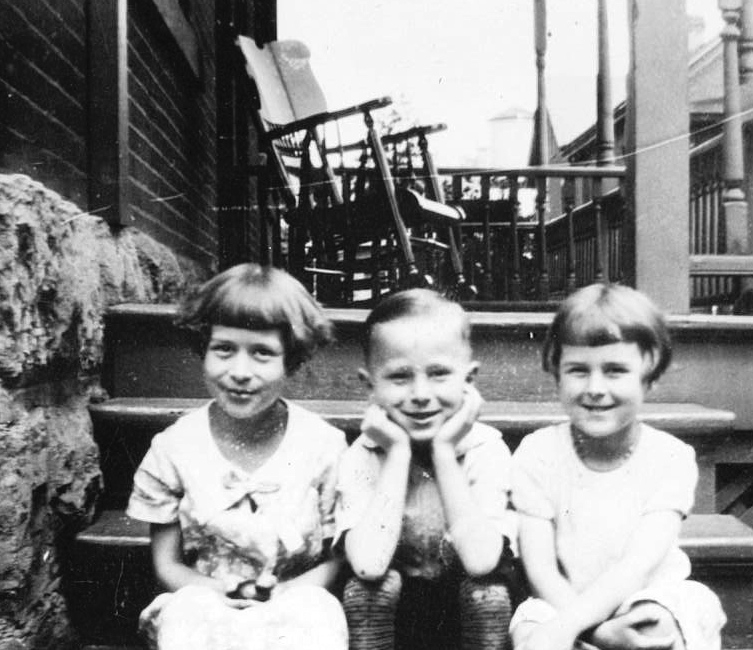
Bob and his sisters, left Mary Jeanne, right Anne
He married Sally A. McCauley on September 6, 1958, in St.
Columbkille's Church.¬ He
was a member of Sacred Heart Parish in his youth and then St.
Columbkille's Parish for over 55 years, where he served on the Parish
Council as the Finance Chair and the Fall Festival Committee.¬
Bob and Sally had two sons, Bob Voels, of Cedar Rapids, IA, and Steve
Voels, of Frisco, TX and a daughter, Barb, who tragically died of
cancer soon after she was married.¬ Bob and Sally had four
grandchildren, Sarah, Allison, Ian and Matt Voels.
Bob tried to enlist in the service during World War II
but wasn’t able to as they discovered he had a heart mummer,
unbeknownst to him, and would not take him.¬ He was bitter about
this.¬ His older brother, Bud, and all his friends had gone into
the service.¬ Bob was a happy fellow and everyone enjoyed his
company.¬ He made a record with friends, "Don't Be A Baby,
Baby.‚Ä̬
¬
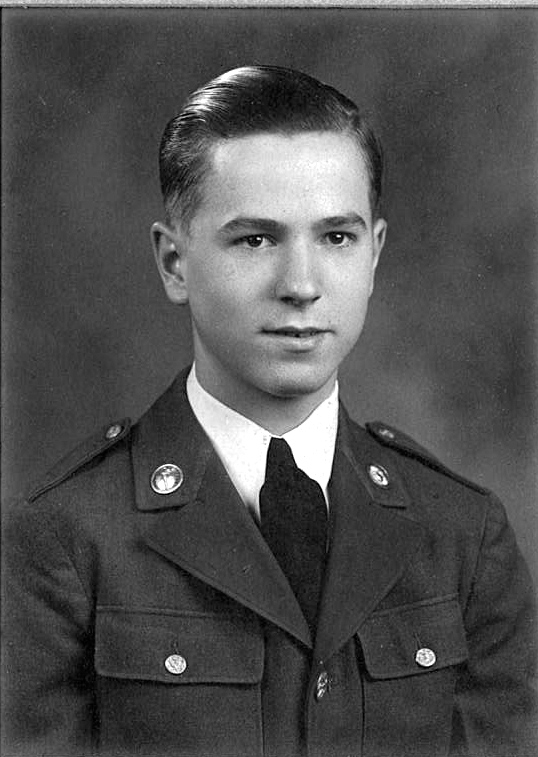
Robert (Bob) Voels in his ROTC uniforn¬
Bob worked for A. Y. McDonald Mfg. Co. his entire
career, retiring in 1992 as Manager of Marketing Services after 45
years, serving in many different capacities, from Assistant to the
President, Inventory Control Manager, and ultimately, leading the
Marketing Services team. He was an accomplished ice skater, and worked
at city park ice rinks through school and was up late at night and
early in the morning to flood and maintain the rinks for other
skaters.¬ He played basketball and baseball in school and city
leagues for many years, and was honored to be inducted into the Dubuque
County Fast Pitch Hall of Fame in 1991.¬ Bob was a great bowler
as well, playing in many leagues and with his family over many
years.¬ He enjoyed extensive travel, taking his family on annual
vacations across most of the country while growing up.¬ These
trips always included away games for the White Sox.¬ His travels
continued into retirement, with many trips with Sally, to Las Vegas and
other places around the country, and then later, trips to Disney World
with his son Bob's family, and several cruises with his son, Steve.
Bob was a sports fan his entire life.¬ If there was a University of
Iowa, Notre Dame, or White Sox game playing, you could always find him
in front of the TV to cheer them on. He stayed up late to watch the
Chicago White Sox finally become the World Series Champions in 2005,
after spending 80 years as a loyal fan.¬ He was always in the stands,
cheering for his children's, and then grandchildren's, sports
games, band, drama and academic achievements.
He was an avid golfer his entire life, playing on
Saturday mornings during his working years, and then could be found on
the links almost daily with a great group of friends in
retirement.¬ He had the excitement of not just one, but actually
two hole-in-ones during his golfing days.¬ Bob never shied away
from an invitation to play cards in Iowa or in Texas when visiting his
son.¬ He was a member of the Tri-State Bridge Club, with a
wonderful group of friends for many years, and a regular Euchre player
with a small group of special friends through retirement.¬ When
his memory started to challenge him later in life, he would always say
that he wasn't sure he remembered how to play the card game or dominos,
but then typically ended up winning with a big smile on his face.
During retirement, he was a member of the Friday Lunch Bunch, meeting
first at the Busy Bee and then at Breezy's Cafe for many years,
reminiscing weekly with friends from his youth.¬ All who met Bob
soon knew that he was a kind and gentle man with a quiet strength and
always cheerful attitude.
¬
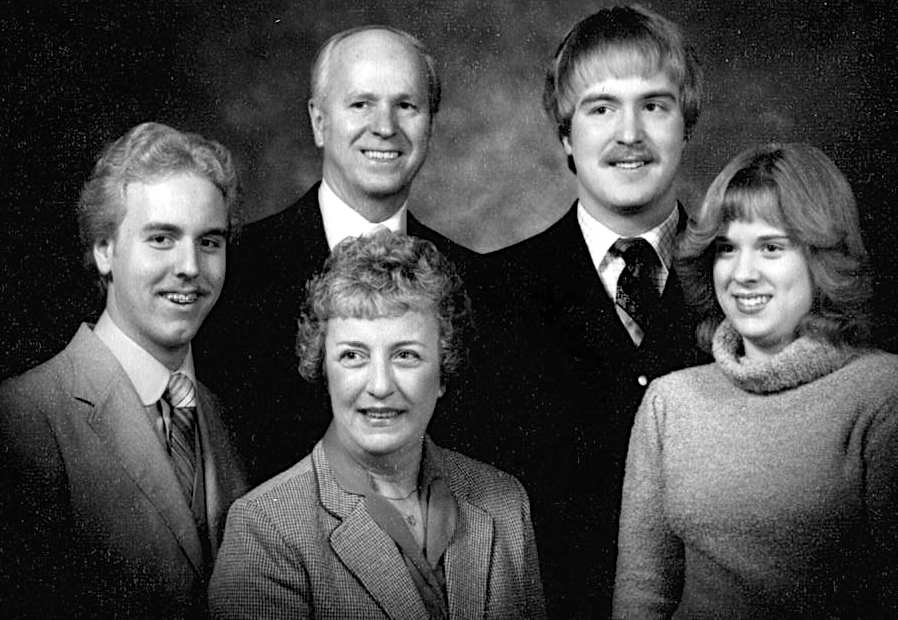
The Voels family, back row from left, Bob, Steve, front Robert, Sally
and Barb
Anna Mae (Born 5-3-1926)
Anna Mary was the youngest child of Elmer and Anna
Voels. Known as Anna Mae while growing up, she also went by
‚ÄúRitzy‚ÄĚ. This nickname came about when she said, ‚ÄúDon‚Äôt I look
ritzy?‚ÄĚ while playing dress up in her older sisters‚Äô party dresses.
Ann's best friend was Lois Slade who lived right across the street. The
two girls would get their tennis rackets and bicycle up to Eagle Point
Park on a Saturday, play tennis for a number of hours, then bike back
going down the long hill at the park. Ann graduated from Immaculate
Conception Academy where she played basketball and tennis. She also won
first place in a poetry contest. She took sewing during high school and
became an excellent seamstress. She made beautiful clothes for her
daughters and commented that her girls had the best-dressed Barbie
dolls in Iowa!
 Ann’s Dad, Elmer, was diagnosed with throat
cancer when Ann was in high school. The family drove up to the Mayo
Clinic so he could see a doctor there and find out if they could help.
The news was not good. On the drive back to Dubuque, her Dad suggested
that they all sing some songs. No doubt, he was trying to raise
everyone’s spirits.
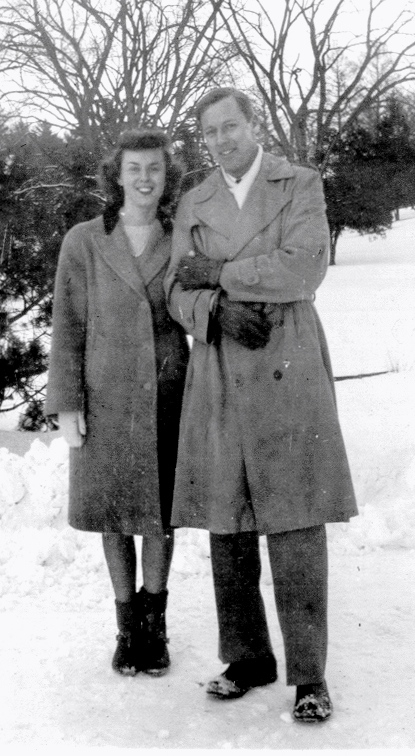
Ann met her husband Paul when she was a sophomore in high school and he
was in college. Paul tells it this way. I was a freshman at Loras
College majoring in Journalism and met Ann at a dance at the Knights of
Columbus. Paul recalls, as a freshmen at Loras, he had to be in at 11 pm
so it was a short evening. Paul then asked Ann to a Loras Sock Hop.
Because of their difference in ages, her mother was against them dating.
However, Ann’s brother Dave knew Paul since both were on the Lorain
Staff and with his ok they were allowed to go. Ann’s mother Anna was a
great cook and Paul enjoyed meals at her house. Ann says that he didn’t
fall in love with her; he fell in love with her mother’s apple pie.
As told by Paul’s half-sister Peggy, “Paul met Ann
and was just "smitten with her‚ÄĚ. He was going back and forth from
Freeport, IL to Dubuque a lot and it seemed like it was the “real
thing‚ÄĚ. Then there was trouble and it was off!¬ There was a
problem because Paul did not wear a necktie and was expected to do so
for some event and Ann had a real problem with that. A little time went
by and Paul was miserable¬ (we thought). Then - it was back on
again! We asked why? Paul said, "Well, she got down on her knees and
begged me to take her back. Ann remembered that her friend Lois Slade
came to the rescue and got them back together.‚ÄĚ
Story told by husband Paul. “There was over a foot
of snow on the ground covering up the parking lane. Ann was parked too
far away from the curb and she got a ticket stating that she had to
appear in court and pay a fine. So, she went down to the police station
to take care of the ticket and the man behind the desk said, “you got
the ticket and you have to pay the fine.‚ÄĚ Just then, cousin Fred
Voels (a detective) walks in and says, “hi Ann, what are you doing
here?‚Ä̬ ‚ÄúWell‚ÄĚ, she said, ‚ÄúI got a ticket for improper
parking.‚ÄĚ Fred turned toward the desk sergeant who by then had turned
his back and was reading the paper. Cousin Fred said, “And how is
Mother? How is the rest of the family?‚ÄĚ as he took the ticket and
tore it up. ‚Äú¬
These were the war years and Paul was classified 1A.
He decided to enlist in the Air Force before he got drafted. Paul
joined the Army Air Corp on June 27, 1944 and passed all the tests and
was trained becoming a Second Lieutenant pilot. After his training was
completed he was stationed at Hondo Texas flying the AT-7 for the
purpose of training Navigators.¬ Paul completed his service and
was discharged Nov. 16 1945 at Chanute Field, Illinois. Ann and Paul
corresponded while he was away and that is how they really became
acquainted. He had a wonderful sense of humor. He was a writer and
would send letters that were 8 1/2 by 11 sheets, two or three of them
and he writes fairly small. Ann would read his letters to the family at
the dinner table because they were so witty. Paul returned to school
after the service and that's the story. They were married in Dubuque in
1949. ¬ Later, Ann and Paul lived at 2051 N. Main in Dubuque for a
while. Ann recollects Paul painting the back porch for Gram.¬
Gram asked if he had any experience? (She was very particular, no brush
marks.) Paul replied, "First time".
¬
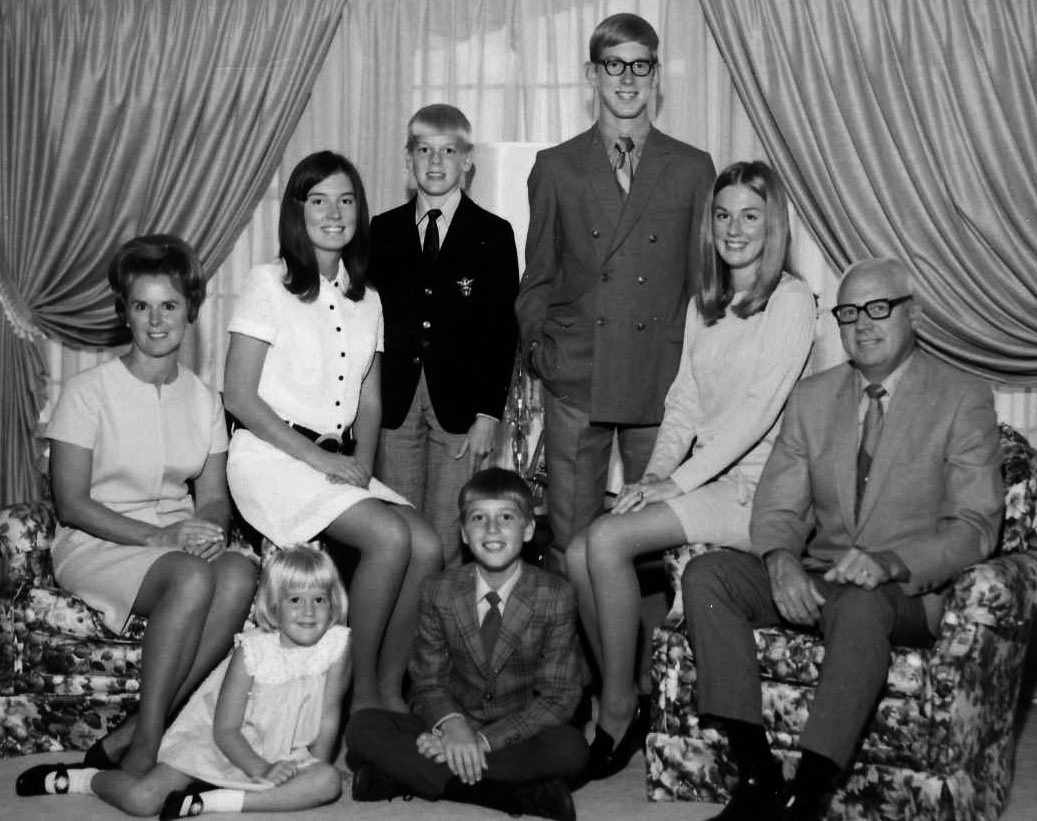
Cremer family: Back row: Ann, Cathy, Dave, Bob, Sue, Paul¬ front:
Trish and Steve
Ann and Paul have six children. Cathy Cremer Mallinger, born
02/28/1950, married Stephen Mallinger and they have two sons, Michael
and Jeffrey. Jeffrey married Alexis Beauvais and they have a daughter
Beatrix. Susan Cremer, born 07/11/1952, married Gerard
Weingartner and they have two daughters, Caryn, who married Nick Wallin
and they have a son Graham and Lauren. Robert Cremer born
04/08/1955, married Debbie Dye and they have three children, Joshua,
Melissa and Christina. David Cremer born 11/13/1957, married
Karen Allen and they have two sons, Bryan and Jason. Steven
Cremer born 06/29/1959, married Carolyn Parks and they have a
daughter Kelly and three sons, Scott, John and Mark. Patricia Cremer
Mayer born 11/13/1965, married Michael Mayer and they have three
children, Michael, Meghan and Jackson.¬
Ann and Paul and Cathy lived in Davenport, IA. Ann’s sister Lucile lived
down the street with her husband Carl and their three sons, Terry, John
and Jim. Ann recalls that Terry and John passed her house as they walked
to school. Lucile called every day to make sure that Ann saw the boys
pass by and continue on to school. Ann and Paul later returned to
Dubuque where Sue, Bob and Dave were born.¬
In 1959, the family moved to West Des Moines, IA where Steve and Trish
were born. Ann enjoyed the busy years while her six children were
growing up. She was a wonderful cook and baker. Her family enjoyed her
great meals and the way she always made things special. She supported
her kids in their activities including Little League, softball, tennis,
golf, Boy & Girl Scouts, swimming. Ann enjoyed playing tennis, golf
and bridge when the children were grown and she had some free time. For
20 years Ann and Paul spent several months in Marco Island, Florida to
escape the cold Iowa winters. They played a lot of golf and tennis and
enjoyed getting together with Ann’s brother Bud and his wife Betty.
Over the years the family has grown to include 16 grandchildren. Ann and
Paul moved to a smaller house in Clive, IA and then to the Reserve
Independent Living in Urbandale, IA. In the spring of 2014, their
children moved them to Bishop Spencer Place in Kansas City, MO to be
near Bob and Trish who live there with their families.
¬
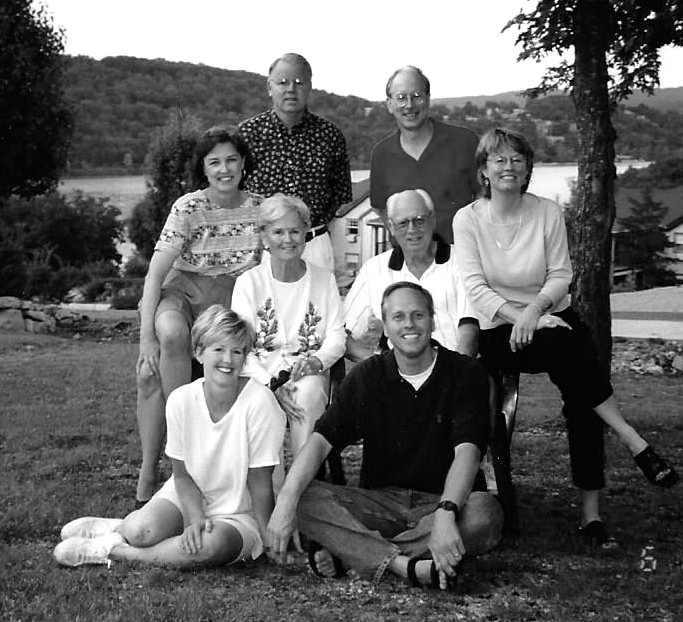
Celebrating Ann and Paul's 50th Anniversary at Tablerock Lake
(1999)
Front: Trish Cremer Mayer, Steve Cremer
Middle: Cathy Cremer Mallinger, Ann Cremer, Paul Cremer, Sue
Cremer
Back: Bob Cremer, Dave Cremer
Reunion in Colorado
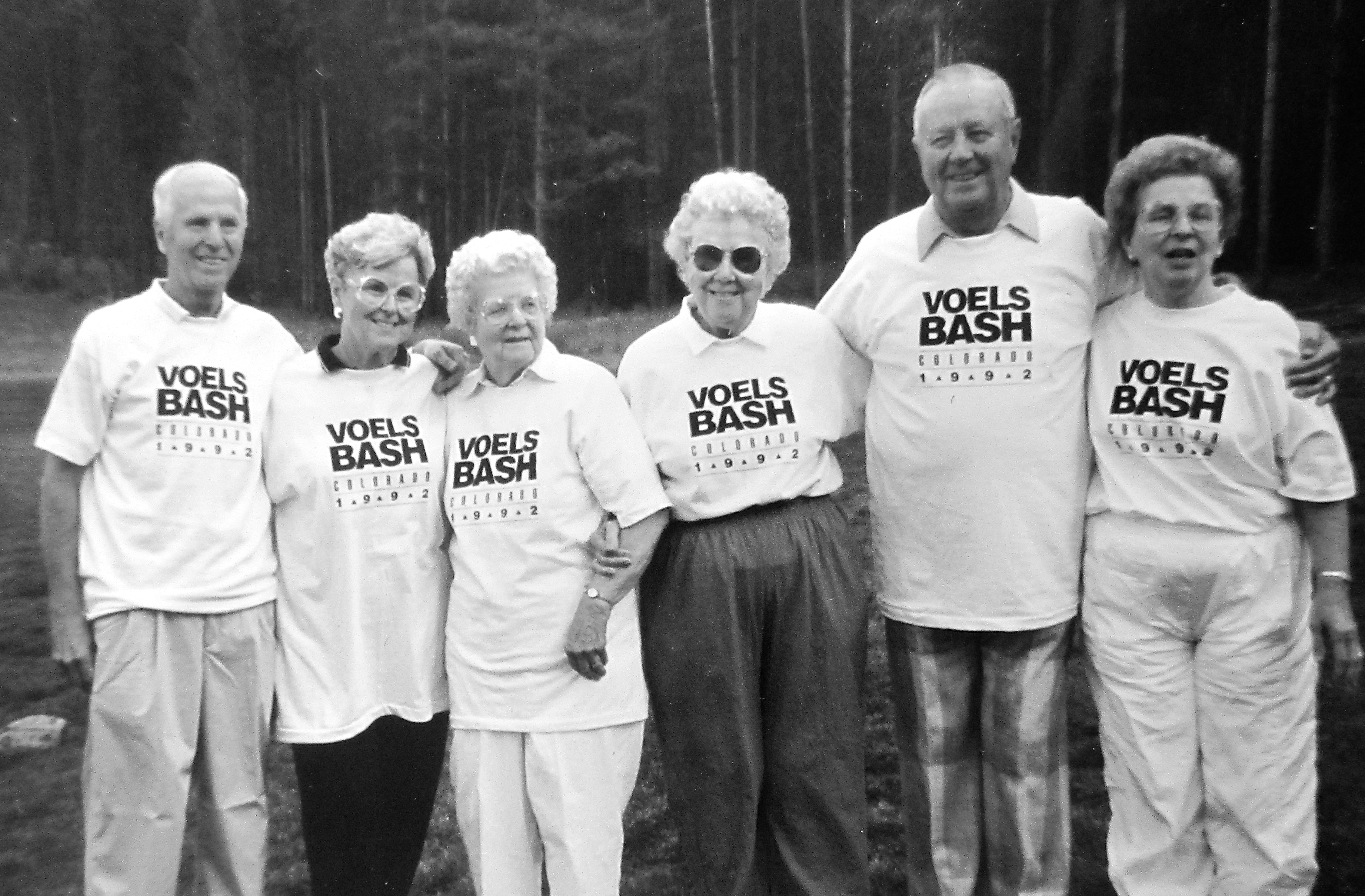
¬ Voels reunion in Breckenridge Colorado, from the left, Robert (Bob),
Anna Mae, Elma, Lucile, Elmer (Bud), Mary Jeanne